
- 2 Weeks for Couple
- 2 Weeks for Family
- Thailand Lantern Festival
- Indonesia(Bali)
- South Korea
- China (HK, Taiwan)
- Itinerary Ideas
- Asia Highlights Travel Reviews
- Thailand Travel Reviews
- Vietnam Travel Reviews
- Cambodia Travel Reviews
- Japan Travel Reviews
- Myanmar Travel Reviews
- China Travel Reviews

- 12 Days in Japan: Top 4 Itineraries for First Visit 2024/2025
A 12-day duration is ideal for you to explore Japan's highlights at a more relaxed pace. It would allow you to visit the top cities of Tokyo, Kyoto, and Osaka as well as popular nearby places, such as Hakone, Nara, or Mount Fuji. You could also explore traditional villages, such as Takayama and Kanazawa, or other close-by places that interest you.
In this article, we've handpicked four 12-day Japan itineraries to help you plan a beautiful, once-in-a-lifetime-special, and stress-free journey. We would customize any itinerary based on your preferences.
- Itinerary 1: Classic Japan (Most Chosen)
- Itinerary 2: For Family with Teenagers

Itinerary 3: Classical Japan with Himeji
- Itinerary 4: Essence of Japan with Okinawa
How Much Does 12 Days in Japan Cost?
Discover real reviews of Highlights Travel Family 's best-rated service across trusted platforms.
Itinerary 1: Classic Japan (Grand Cities and Traditional Villages)
- 3 nights in Tokyo
- 1 night in Takayama
- 2 nights in Kanazawa
- 3 nights in Kyoto (side trip to Nara)
- 2 nights in Osaka
This 12-day itinerary is excellent for a first trip to Japan, with plenty of authentic experiences and activities. Not only could you explore the best of Tokyo, Kyoto, and Osaka, but you could also delve into the less-crowded towns of Takayama and Kanazawa to see picturesque rural views and unique farmhouses.
Start your journey in Tokyo. Wander along the wide stone path lined with tall trees at wooden Meiji Shrine in the downtown area, and immerse yourself in the atmosphere of Tokyo's most spiritual Buddhist temple, Senso-ji. You could also try your hand at making sushi for lunch to discover a prominent element of Japanese culinary tradition.
Then, take the efficient Shinkansen (bullet train) to explore serene Takayama, Shirakawa, and Kanazawa. These three cities have well-preserved sites and picturesque countryside views.
- Takayama: Wander around the well-preserved old town to soak up the Edo vibe, hold delicate handicrafts, such as lacquer and ceramics, and sample some representative Hida beef.
- Shirakawa: The unique gassho-zukuri farmhouses, which have steep thatched roofs that are named after 'praying hands'. These farmhouses are extremely charming when covered in snow and illuminated at night during January and February.
- Kanazawa: Stroll through one of the three most celebrated Japanese gardens — Kenroku-en — to admire the manicured landscapes, relax and enjoy a cup of matcha at a traditional teahouse, and experience attaching gold leaf to chopsticks.
Contiune your trip to tradition Kyoto. Immerse yourself in the Fushimi Inari Shrine to see amazing sight of thousands of orange-red torii gates. Spend a night at a Japanese ryokan for a cozy night. And feed and enjoy close interactions with the deer in nearby Nara.
Osaka is your final stop. You'll experience highlights like unique ukiyo-e printmaking, sample local snacks in the Dotonbori district, and watch an impressive Japanese sporting event — a sumo wrestling match.
Our Japan travel expert would tailor-made a private tour for you based on your preferences and requirements.
Itinerary 2: For a Family with Teenagers Including Hands-On Activities
- 2 nights in Hakone
- 3 nights in Kyoto (side trip to Uji and Nara)
- 3 nights in Osaka
This 12-day Japan itinerary is the perfect choice for families with teenagers. It satiates kids' love for anime and games, offers abundant family-friendly activities, and you won't have to change hotels frequently.
Start your trip from Tokyo. Discover some Japan-exclusive products at the most popular Pokémon Center, enjoy coffee and desserts at an anime café, and immerse yourself in interactive experiences at high-tech museums, such as TeamLab.
Next, travel to Hakone for its onsens (hot spring baths) and charming rural views. Don't miss experience at a traditional ryokan (inn) with a family room (accommodating 3–5 people). A ryokan typically has 5–15 rooms, and they easily become fully booked, so you're advised to book at least 3 months in advance to ensure a wider range of options. Our Japan travel advisors would help you to select a family-friendly ryokan based on your preferences .
Take the comfortable Shinkansen to Kyoto. You'll wear kimonos to explore the Gion district and take memorable family photos, engage in a matcha-making experience to savor the refreshing taste of tea, and feed the lovely deer in Nara.
Finish your wonderful family trip in Osaka. Here, you could try on ninja outfits to learn about ninja weapons and techniques from a ninja master. Interact with cute farm animals and participate in hands-on activities, such as cheese-making and horseback riding, at Rokkosan Farm. Alternatively, you could spend a day fully immersed in the magical world of Mario at Super Nintendo World.
Our Japan travel expert would carefully design each private tour to cater to your unique interests and requirements .
- 1 night in Hakone
- 4 nights in Kyoto (side trip to Nara)
With this 12-day itinerary, you would visit the highlights of Japan in Tokyo, Kyoto, and Osaka. Indulge in the enchanting sights of shrines, experience a traditional tea ceremony or wear a kimono (or both), stay at a ryokan for a memorable night, and feed the deer in Nara.
You would visit the well-preserved castle in Himeji, which is located near Osaka. Himeji Castle is particularly enchanting during the cherry blossom season when it's adorned with beautiful cherry blossoms. The castle's white exterior walls and magnificent structure amaze many at first sight, and you would have the opportunity to explore the castle's interior.
If you have other requirements, contact us and our Japan travel expert can make it happen.
Itinerary 4: Essence of Japan with Beach Time in Okinawa
- 2 nights in Okinawa
With this 12-day itinerary, you would explore the essence of Japan in Tokyo, Kyoto, and Osaka . You would immerse yourself in traditional shrines, enjoy delicious cuisine, visit world-class theme parks, stay at a traditional ryokan, and experience authentic activities, such as making cup noodles or creating Kyoto pottery.
Moreover, you could head to Okinawa to delve into the long history of this small island. Okinawa possesses some of the most stunning beaches in Japan and you could enjoy exciting outdoor sports, such as snorkeling, diving, and surfing, and take a leisurely walk on a sandy beach to see a beautiful sunrise or sunset.
Okinawa also boasts its rich and unique Ryukyu culture. Visit Ryukyu Mura to gain insights into the ancient Okinawan culture. You could see a variety of traditional Ryukyu performances, experience the traditional Okinawan musical instrument called a shamisen, taste authentic Ryukyu cuisine, and interact with the local people.
Contact us for more suggestions based on your interests.
US$350-500 per person per day is the typical cost for a private tour with 4-star hotels, based on a family of 3–5 people. This includes a private guide, private car, full-day itinerary, tickets for attractions, all intercity transport within Japan, and hand-picked 4-star hotels. Thus, the total cost for 12 days in Japan is about US$4,200-6,000 per person (international flights not included).
Why Asia Highlights (10,000+ reviews & 98.8% 5-star rating)
- Save Your Time:
- Less research, more enjoyment!
- Real-time 1V1 expert planning
- Maximize Your Flexibility:
- Personal local guide and ride
- Explore at your own pace
- Celebrate Your Journeys:
- Specially-crafted family adventures
- Celebrate milestones with style!
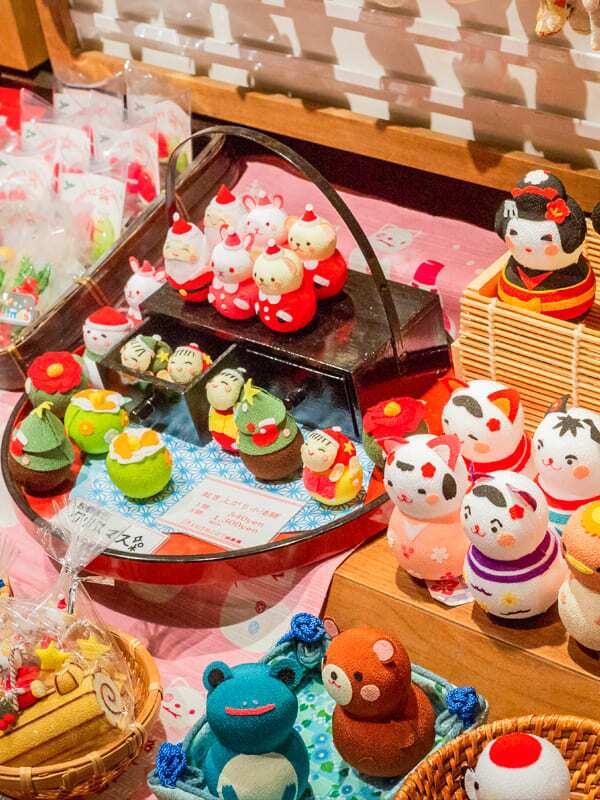
- 7-Day Japan Cherry Blossom Tour 2025: Essential Springtime Mini-Group Tour
- 7-Day Tokyo, Kyoto and Osaka Tour
- 8-Day Tokyo, Hakone, Kyoto, Hiroshima and Osaka Tour
- 9-Day Japan Highlights Tour
- 10-Day Japan Cherry Blossom Spring 2025 Mini-Group Tour
- 10-Day Tokyo, Yokohama, Hakone, Kyoto, Nara and Osaka Tour
- 11-Day Traditional Japan Tour
- 12-Day Classic Japan Tour
- 12-Day Tokyo, Hakone, Kyoto, Osaka and Himeji Tour
- 2-Week Highlights of Japan in the Cherry Blossom Season
- 16-Day South Korea and Japan Cultural Adventure Tour
- 16-Day Japan and China Discovery Tour
- How to Plan a Trip to China and Japan
- Plan a Japan Cherry Blossom Trip 2024/2025, Dates and Avoid Crowds
- Plan a Family Trip to Japan 2024/2025: Experiences and Itineraries
- How to Plan a Luxury Trip to Japan in 2024/2025
- Best (and Worst) Time to Visit Japan 2024, Cherry Blossom Time
- 1 Week in Japan: Top 5 Itineraries for First Visit 2024/2025
- 8 Days in Japan: Top 5 Itineraries for First Visit 2024/2025
- 10 Days in Japan: Top 5 Itineraries for First Visit 2024/2025
- 2 Weeks in Japan:Top 5 Itineraries for First Visit 2024/2025
- 3 Weeks in Japan: Top 3 Itineraries for First Visit 2024/2025
- How to Plan a 2-Week Itinerary in Japan and South Korea
- Japan Weather in January: Travel Tips for First-Timers
- Japan Weather in February 2024: Travel Tips for First-Timers
- Japan Weather in March 2024: Travel Tips for First-Timers
- Japan Weather in April 2024, Travel Tips (for First-Timers)
- Japan Weather in May 2024: Travel Tips for a First Visit
- Japan Weather in June 2024: Coolest Summer Month, Travel Tips for First Visit
- Japan Weather in July 2024: Full of Festivals, Travel Tips for First Visit
- Japan Weather in August 2024: Travel Tips for First Visit
- Japan Weather in September, Travel Tips (for First-Timers)
- Japan Weather in October 2024: Travel Tips for First-Timers
- Japan Weather in November 2024: Best Autumn Month, Travel Tips
- Japan Weather in December 2024: Travel Tips for First-Timers

Jessie was amazing ! Everything from her level of English to her understanding of what we valued .
We had a good time exploring the city with Selinda!
Our guide lele is a wealth of information, Lele is very professional and very attentive to our needs. Lele is amazing. Lele got everything spot on. It probably helps that Guilin is a brilliant place to visit so Lele has great material to work with but that doesn't take anything away from how much Lele helped make it a great trip.
Our guide for Beijing was super knowledgeable and experienced and able to help us to achieve as much as we wanted within the time given. We had a fun time guided by him as he is also super humorous and you can see how he interacts with the vendors and people whom he comes by. Thank you for a very enjoyable time in Beijing and accommodating to all our needs!
Our China Highlight guide. Michael, was attentive, thoughtful and knowledgeable. He narrated many interesting historical events about Chengdu while touring around the city and having afternoon tea with us. He was thoughtful to provide us with snacks during long hikes at Leshan or walks around the city.
She was very flexible and added extra time when we needed it and we felt extremely well taken care of. She also chose the best restaurants for us,
Our tour guide Helen, was excellent, she was very kind, professional and passionate for her work and she also loves Pandas! She will take you to take the best panda photos and to know more about Chengdu city. Our tour was great, she took us to all our destinations always with the best spots: Temples, pagodas, famous streets, theaters, pandas...you name it! Everything was great.
He picked up our pre-booked boat/other excursions tickets so we were able to avoid all the long lines and chaos. He is knowledgeable of the places we visited, courteous, fun to travel with and well-versed in Chinese classics.
Tom is the guide that will take you to where no other guide will. We pushed for the experience and Tom and the team delivered more than what we could have ever asked for. His English speaking ability and his Chinese history knowledge is second to none.
More reviews
Get Inspired with Some Popular Itineraries
At Asia Highlights, we create your kind of journey — your dates, your destinations, at your pace. You can have any trip tailor made for your travel.
More Travel Ideas and Inspiration
Sign up to Our Newsletter
Be the first to receive exciting updates, exclusive promotions, and valuable travel tips from our team of experts.
Why Asia Highlights
Where can we take you today.
- Middle East
- African Safari

- Travel Agents
- Our Differences
- Privacy Policy

Address: Building 6, Chuangyi Business Park, 70 Qilidian Road, Guilin, Guangxi, 541004, China
Going Awesome Places
Detailed itineraries + travel guides
12 Day Japan Itinerary – The Ultimate Trip Planning Guide
Last Updated February 20, 2023 William Tang
You are here: Home » Travel Itineraries » 12 Day Japan Itinerary – The Ultimate Trip Planning Guide
The essential 12 day Japan itinerary that is j a m packed with incredible food, culture, and fun.
Japan was high on my list of countries to visit for a long time and when I finally got to go there, it met my expectations in every way and was a dream trip come true. Knowing everything that I went through in planning the trip, there were a lot of takeaways from my booking activities and hotels ahead of time, experience on the ground, and things I didn’t expect along the way. That’s why I’ve put together this ultimate 12 day Japan itinerary and collected all of the “need to know before you go” tips in this travel guide.
- 12 Day Japan Itinerary Overview

When planning for Japan, I knew I wanted to try to get a good overview of the “ best of the best ” of the country. So I knew that would have to include Tokyo and Kyoto but filling in the blanks was a challenge as there just wasn’t that much online to go on. It was a lot harder than other countries in part due to the difference in language and lack of English based sites. Restaurants were also a hard part to figure out as I didn’t really want to rely only on TripAdvisor’s biases. Luckily, I reached out to a local Japanese friend for real local recommendations and she was able to provide a ton of suggestions which worked out well.
The overall trip to Japan was a huge success as we got a combination of delicious foods, culture, history, outdoors and everything that goes with the big city of Tokyo. I will say though that it was extremely hot and sticky in August. That certainly weighed down on us on the day to day and found ourselves much more tired than usual.
If you’ve got 10-12 days only in Japan and want to see some of the best of the best, then you’re in the right place. Read on!
Read more about Japan
- Guide to Toyosu Fish Market in Tokyo
- Tokyo Japan food guide
- Food souvenirs to buy in Japan
- Where to stay in Tokyo – a neighbourhood guide
- Best Ramen in Tokyo
- Top Japan Articles
Where to stay in Japan?
- If you’re looking for great places to stay, my recommendation is to take a look on Booking.com whether you’re staying in Tokyo , Osaka , Kyoto , or Hiroshima . They’re probably the most versatile hotel platform now mainly because they not only have a big hotel inventory but they also have a ton of B&Bs as well.
- I have specialized neighbourhood guides for Kyoto , Hiroshima, and Tokyo .
In This Article
Japan 12 Day Itinerary
What we missed, things you need to know before going to japan, all of japan, travel advice on tokyo, travel advice on osaka, travel advice on nara, travel advice on kyoto, travel advice on hiroshima, travel advice on hakone, 12 day japan itinerary in photos.
To navigate, scroll left and right to see the full itinerary.
If you’d rather have a version of the itinerary you can re-use, sign up to become an insider to get access to the Japan in 12 days itinerary.
At the end of the day, 12 days in Japan is just enough to explore the tip of the iceberg. There were so many things we wanted to do but simply couldn’t fit into the itinerary. Thinking back on the trip, if I were to isolate the top 5 things we regret not doing, it’d be the following:
- Climbing Mount Fuji – I was this close to doing it but alas the weather conditions weren’t very favourable in August.
- I wish I got to spend a little more time in Osaka itself. We opted to switch out our day in Osaka with Nara since a friend said it would be nice out there. Another night in Osaka also would’ve been nice to try out more food as Osaka is known to be the foodie capital of Japan.
- Kobe is another place I regret not going to. That mouth watering, butter-like quality beef lingers as an item I still have not been able to check off. I couldn’t include it due to the lack of days I had but if this is your priority, you should definitely try to fit it in.
- Koyasan (Mount Koya) was another option as a day trip from Osaka but seemed too ambitious as a day trip.
- Outside of Tokyo I also thought about doing Yokohama or Kamakura but ultimately I chose Hakone because I wanted a more authentic onsen experience.
As you’re planning out your trip to Japan, I can relate to how head-ache inducing it can be because there’s either too much information or some of the information you’re looking for on official sites aren’t translated to English. It’s totally overwhelming. Thinking about my own trip experiences, I captured a BIG LIST of things that I know will be useful for your very own 12 day itinerary to Japan.
Japan Trip Planning Essentials and Discounts
If you’re in the middle of booking your trip to Japan, here are the most important places you need to go to book:
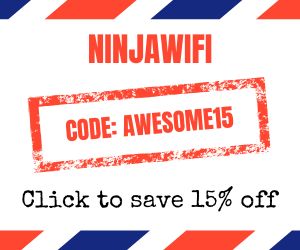
- JR Pass – The two most reliable places we always check are JRailPass and JRPass . If you are taking long distance Shinkansen across multiple region, get the full JR Pass . If you’re focusing on one specific area, you only need a JR regional pass .
- Shinkansen – The JR Pass prices have gone up and for many of you, it’ll make more sense to book tickets individually. The secret is that when you buy your Shinkansen tickets through Klook offers special vouchers for Don Quijote and BIC when booking. Their tickets are super easy to redeem as well. Right now, use code SKS10OFF to save $10 USD off.
- Hotels/Ryokans – In Japan, the best website for accommodations, hands down is Agoda . When we’ve compared them against Booking , Agoda consistently came out cheaper.
- Tours – While Viator and GetYourGuide are our go-to’s, Klook and KKDay are much popular in Asia so it’s always worth comparing across all of them to make sure you get the best price.
- Pocket Wifi – While we do love eSIMs, having a pocket wifi is great for sharing data with a large group. The most popular is NinjaWifi which is easy to pick up at the airport. Use code AWESOME15 to save 15% (automatically applied). Alternatives are offered by JRPass and JRailPass but they aren’t as cheap. For a more global solution, consider Solis and PokeFi .
- eSIM – The best one is Airalo . Save money by getting the Japan region eSIM and use referral code WILLIA9500 to get $3 USD credit on your first purchase. From now to Feb 29, the 10GB package is half price as well! Ubigi is another one that we’ve had success with where they uniquely offer 5G coverage. Use code AWESOME10 to save 10% on your first order.
- Car Rental – Big companies like Budget , Avis , and Enterprise operate in Japan but they’re usually the most expensive. The best companies are the local Japanese ones such as Toyota Rentacar, Nippon Rentacar, Orix Rentacar, Nissan Rentacar, and Times Car Rental. To make things easier, use Rentalcars and Klook to compare prices all in one place. Don’t forget, you need an IDP to drive in Japan so get one before you leave your home country.
- Learn Japanese – It helps to know even a bit of the language before you go. Start your learning with Rosetta Stone Japanese .
- Cash or credit – Cash is still very important to have in Japan but when you use credit cards, make sure you’re not getting charged those extra exchange rate fees. The best card right now is the Wise Multi-Currency Card which is actually a debit card where you can convert at favorable rates beforehand. This cuts out any sneaky transaction fees.
- Travel Insurance – Make sure you’re covered in case something happens. Get quotes from Insured Nomads and if you’re from Canada, get quotes from RATESDOTCA .
- Shopping – Discovering Don Quijote is a quintessential part of the Japan experience. The secret for tax-free shopping is that they have a coupon that can help you save 10% off + additional 5% off if you spend ¥10,000 or more.
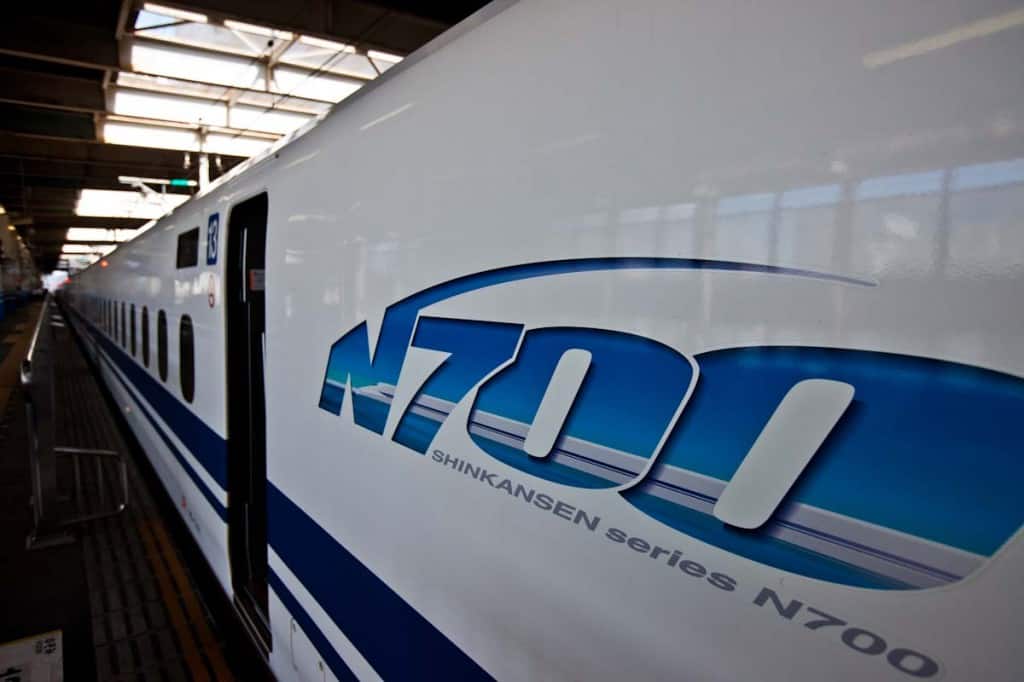
Japan by Train – The JR Pass is pretty much a must if you’re going to be travelling between major cities in Japan. Read more about Japan by Rail .
Get Your JR Pass Before You Go
If you’re looking to do any travelling around Japan, I highly recommend picking up a JRailPass . Keep in mind that you’ll need to purchase it before your trip and ship it to your home.

Train Schedules – If there’s one site you need to know when travelling with a JR pass is www.hyperdia.com . First of all, it’s English friendly so no need for complicated translations. This is an excellent page to figure out the train schedules and since you know the Japanese railway system runs like clockwork you don’t need to worry about whether it’ll be early or late. I used this on many occasions during the trip to figure out the most effective trains to take to get from point A to B.
- For example when going from Kyoto to Hiroshima most of the itineraries involved a transfer in Osaka which would waste time. I played around with different departure times and eventually found a direct Shinkansen that ran from Kyoto to Osaka and then to Hiroshima. No transfer required = less time = more sleep on the train.
ATM’s – If you have a foreign debit card like I did, you’re going to run into problems withdrawing from normal legit bank ATM’s. For some reason these machines don’t take foreign cards. The only machine that worked for me the entire trip was the 7-Eleven . This one worked all the time. So don’t worry, it’s not you when your debit card doesn’t work anywhere else. Just go over to any 7-Eleven which won’t be hard to find and you’ll be good to go.
Baggage Delivery Service – Look for Yamato either at the airport or anywhere in major cities to get it done. They’re fast, simple and reliable. You can either use this service to ship bags from the airport to a city ahead of you so you don’t have to lug it around while taking the train. You can also do what I did which was to ship my larger suitcase to my last destination in Japan.
Most Useful Website – Aside from my own of course ;), Japan Guide was probably the most useful site for Japan that rivalled even TripAdvisor and their forums.
Tuesdays – This one easily creeps up on you without you realizing. There are many places including attractions and restaurants that are closed on Tuesdays so make sure to double-check.
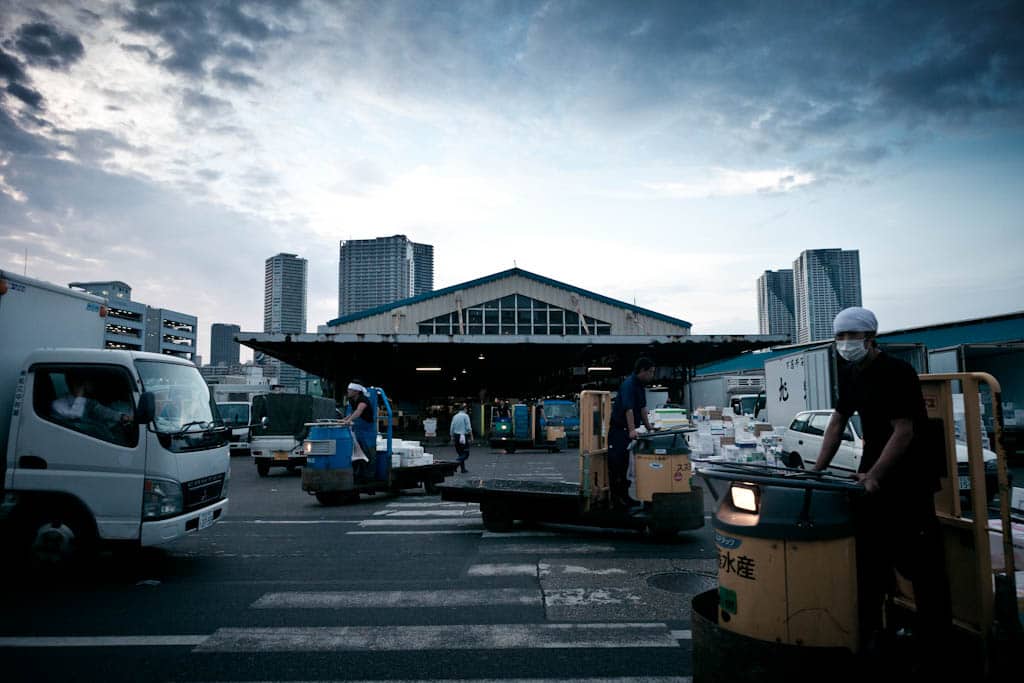
Tsukiji Fish Market Toyosu Fish Market
- NEW IN 2019 – Toyosu Market (豊洲市場) opened October 2018 and is the new site of the Tsukiji Fish Market. Tuna auctions occur at 5:30 and 6:30AM and can be viewed from a few places – observation windows, observation deck (reservation required). For a full guide on how to get into the Toyosu Fish Market Lottery and the full details about what the experience is like .
- How to get to the observation deck – Advance reservation is required to access this deck during the tuna auctions. Similar to before, there are 3 groups of 40 that are allowed in for 10 minutes at a time between 5:45AM and 6:15AM. You must submit your application a month prior at a selected time . It’s a lottery system which is good and bad – good that you don’t have to attempt in the morning and fail but bad in that it is possibly even more competitive because everyone will put their names in.
- Eat lots – Make sure you make it to the restaurants there. Sushi Dai and Daiwa are the go-to places but expect to line up. If you failed at going to the auction you might as well go straight to the restaurants. These classics from Tsukiji Fish Market have been relocated to the new market.
- Seafood Intermediate Wholesaler’s Area – The area is off limits to visitors but they also have their own observation windows for viewing. That said the views are quite narrow and limited.
Restaurant Reservations – For a lot of the well-known restaurants in Tokyo it’s important to make reservations a day in advance. We did this for the entire trip and didn’t run into any problems.
Harajuku – One of the must-visit neighbourhoods of Tokyo. It was a ton of fun to explore even when packed. Filled with many boutique shops, girls in Lolita costumes, and many snacks.
- TIP: To see Lolita girls, make sure you go on the weekend.
Hato Bus – This is a popular tour bus company that locals use and is just as well known for visitors. Hato Bus is a great option in Tokyo because it saves you the hassle of figuring out public transit and allows you to see way more in one day than you would on foot. They offer high quality tours that are quite affordable as well. For the tour that we went on, it also came with a fabulous lunch in a zen park.
- TIP: If you’re doing the Hato Bus, just make sure you plan your itinerary around the tour so you don’t end up redoing any sights.
Looking For Great Views? – If you’re looking to go up a skyscraper with fantastic views of the city AND you want to do it for FREE , look no further than the Tokyo Metropolitan Government Building is the one you want to go to. Based on personal experience though, the one thing to note is that the views from the top are somewhat limited. I feel that Tokyo Tower or Tokyo Skytree would offer better views but those have paid admission.
Best Shrine – If there’s one shrine you want to go to in Tokyo, I would recommend Meiji Shrine. My #2 would probably be the one in Asakusa.
Recommended Restaurant – Gonpachi is a must-do restaurant in Tokyo. Make reservations! It’s the restaurant that inspired the epic restaurant scene in Kill Bill.
Odaiba – I wouldn’t necessarily recommend Odaiba to first time visitors of Tokyo but if you’re looking to do some shopping and want to hang out at as a local for shopping and entertainment arcades, you can definitely make the trip out to this man-made island.
Day trips – Tokyo is massive and so if you’re looking for a great day-trip recommendation, check out foodie destinations like Kichijoji which is well known for their street food.
Where to Stay – Here are my recommendations for top 4 picks in the city that caters to all budgets. If you want more recommendations, make sure to take a look at the in-depth neighbourhood guide and best places to stay in Tokyo .
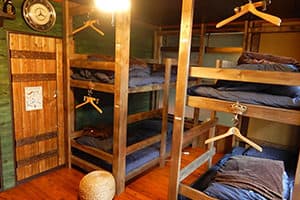
HOSTEL OOMORI SOUKO
If you’re looking for cheap accommodations in Tokyo (sub $100), you’re looking at hostels and ones that are going to be a little away from the core. The host, Kato-san is extremely friendly which is why the property is so well reviewed. It’s minutes away from Haneda airport and 16 minutes walk to the train to head into the downtown.
Booking.com
BUDGET-FRIENDLY

DAIWA ROYNET HOTEL
Brand new hotel as of February 2019, this a 3-star hotel with affordable prices because it is in the Shinjuku Ward which should not be confused with Shinjuku. You’ll need to take the train into the city but for the cost and as a brand-new property, this can’t be beat.
TripAdvisor
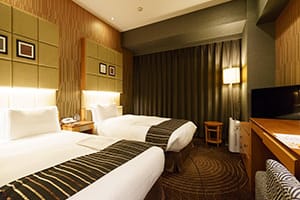
HOTEL SUNROUTE HIGASHI SHINJUKU
Located near Shinjuku, this hotel is conveniently located 10 minutes walk from the Isetan department store and more importantly right by the train station. The rooms are spacious, clean, and comfortable and up to standards as a mid-level hotel.
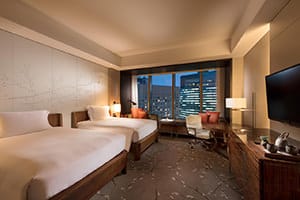
CONRAD TOKYO
This property is well deserved of Hilton’s top brand. Located near Shimbashi and Shiodome, this is located in a financial area which means there isn’t too much around directly in its vicinity but Shimbashi certainly makes up for it. It is also walking distance to Tsukiji. Impressive room, executive lounge, the lobby, and impeccable service.
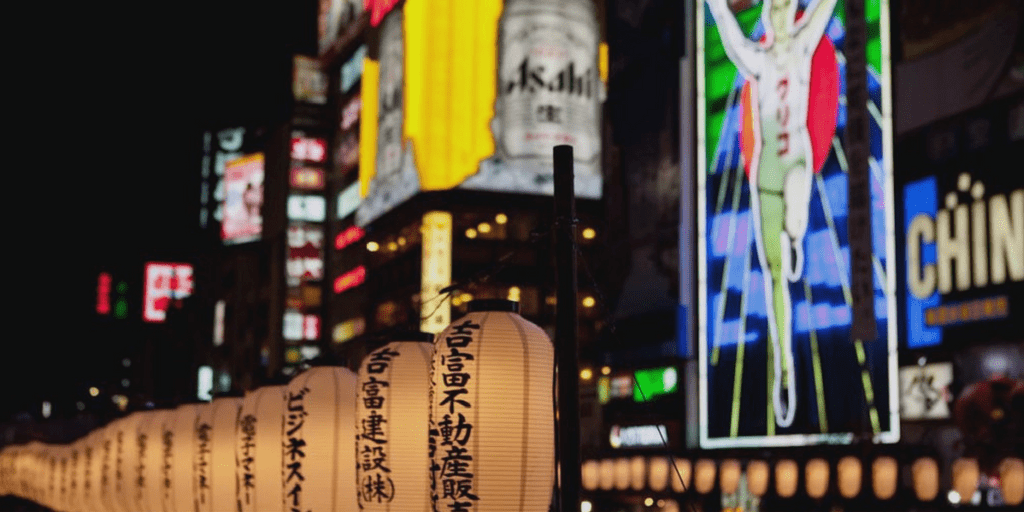
Hotels in Osaka – Accommodations aren’t the easiest to find in Japan but Hostel 64 Osaka was recommended by my Japanese friend and it sure was a winner. Highly recommended for their spacious rooms, location, service, and breakfast. It has many of the hostel qualities but out of all hostels I have ever stayed at, this has to be #1.
Foodie Paradise – Come to Osaka for the food. There’s just so many options here and things seem more accessible here than in Tokyo.
Where to Stay – Even with only a couple of days here, you’ll need to find a good place to stay as a base of operations whether you’re doing Osaka, Nara, or any of the other outlying cities.
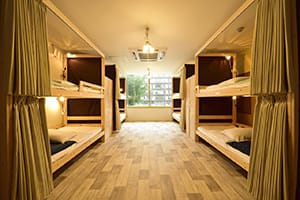
HOSTEL CHILL OUT
This is a killer hostel that’s conveniently located right along the Dotonbori River, is really cheap, and comfortably spacious for shared accommodations. This one is top in my books for Osaka.

SARASA HOTEL SHIN OSAKA
A great steal of a property for those not looking to stay at a hostel where I’ve seen prices hovering around USD$60 or less. What you need to know that this is located north of central Osaka in Yodogawa Ward district and right by Shin Osaka station. Bonus is that they include a mobile phone with internet access.
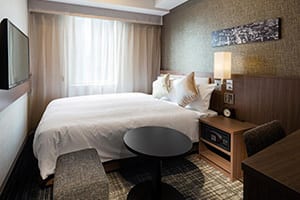
HOTEL UNIZO OSAKA
A hotel that includes all the fixings you’d expect from a modern property. The highlight though is the location which is just a here 5-minute walk to Umeda station and a 10-minute walk to Osaka station, respectively. There is free wifi at this hotel.

HOTEL NIKKO OSAKA
Looking to go a little fancy? Well right up there in terms of top properties in Osaka is the Nikko Osaka which sits right above Shinsaibashi subway station which gives you access to the shopping and restaurants of the Dotonbori area. It is also located Daimaru. The rooms are of the highest class and many offer excellent views of the city.
Is Nara Worth It? – Without seeing much of Osaka outside of Dotonbori I can’t really say whether Nara was better than Osaka or not but it’s definitely a side trip worth doing. The deer experience alone made it worthwhile.
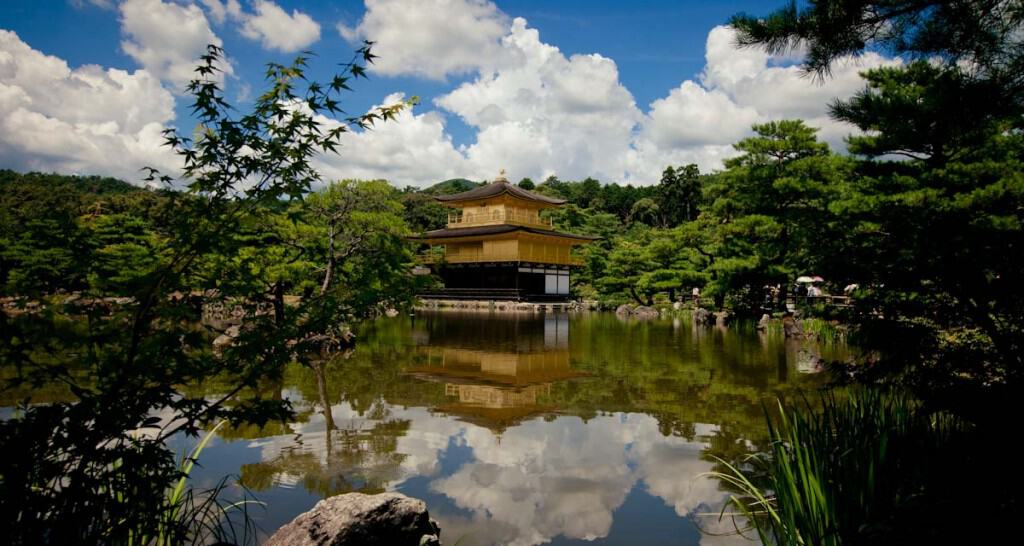
Ryokans – One of the must-try things in Kyoto is to stay at a traditional ryokan. Ryokans are a type of traditional Japanese inn that has existed since the eighth century. For something on the budget side of things Ryokan Shimizu is perfect. It’s clean, it has its own en-suite bathroom, and is close to transportation. Get the ryokan experience for a fraction of the cost.
Higashiyama District – You can easily spend a full day in the Higashiyama Area and I would highly recommend it if you have 2 days to work with. This is the area where you’ll be able to see Kiyomizu-dera and Yasaka Shrine.
Plan Wisely – Something you should note as you plan your trip is that special buildings such as temples, shrines, and castles close between 4PM-5PM. This means that if you don’t want to run risk of being shut out of any places, it makes sense to do these sights earlier in the day.
Fushimi Inari – Now what’s unique about this cascade of red torii gates is that there’s no official closing time here so when planning your day, slot this towards the end of the day so you can still see your temples, shrines and castles and then round out the day exploring Fushimi Inari. For the photographers out there, Fushimi Inari is absolutely stunning for photos.
Where to Stay – Kyoto has an interesting mix of accommodations that makes it one that you really have to do some research for. As mention above, there are the traditional ryokans that most of you will undoubtedly want to try here. I pick out the best affordable ryokans in Kyoto but what are others you should consider? We also have an detailed Kyoto where to stay and neighbourhood guide that you should use for your trip planning.
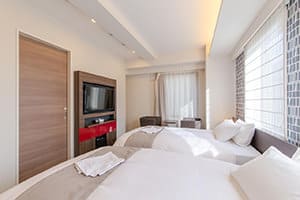
HOTEL M’S PLUS SHIJO OMIYA
It’s crazy to find such a popular property (close to 6,000 reviews) at such cheap prices (USD$50) in Kyoto but here it is. The surprising thing is that their rooms are just like any other high quality hotel room. You can’t go wrong with this one.

HOTEL KEIHAN KYOTO GRANDE
Another property that should be more expensive than it is. Hotel Keihan is directly connected to the JR Kyoto train station, is 10 minutes from Higashi Hongan-ji Temple, and 15 minutes from To-ji Temple. All of the modern rooms also come with free wifi.
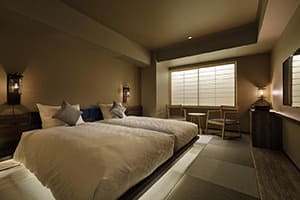
HOTEL RESOL KYOTO KAWARAMACHI SANJO
Located in the Nakagyo Ward, just north of Kyoto station, you’re only 1.6km to temples such as Shoren-in. This is comfortable and upscale hotel that is built in the modern style but mixes in the ambiance of what it’s like to stay in a ryokan.

RYOKAN TORI
Completely authentic ryokan experience that is definitely more expensive than the budget ryokans I’ve written about but the reason for this is all the extras you get – private hot bath well prepared for you each evening, tea ceremony at the tea room, and love the homemade Kyoto style breakfast.

I’m glad we were able to fit in Hiroshima as part of this 12 day itinerary of Japan. For more details about places to go, make sure to head to the top 5 things to do in Hiroshima .
Photography at Miyajima – One thing that people say about photographing Miyajima and the floating torii is that you have to decide whether you want to shoot it with the tide up or down. I didn’t have the luxury of choosing when I went so this was a non-factor for me but if you want to shoot it at high tide, go in the morning. If you want to see it at low tide and be able to walk right up to the gate, you’ll want to be there in the late afternoon. Of course the time of the year matters as well but the tide trend should stay the same.
Why Hiroshima? – Hiroshima is definitely something not to miss if you’re going to be in the Osaka region. Even if you’re not a WWII history buff, the atomic bomb history is thoroughly interesting and of course Miyajima is beautiful.
Remembering – The atomic bomb monuments, museums, and park can done in half a day so if you have a full day in Hiroshima, you can easily do both the atomic bomb memorials and Miyajima island. If you’re looking for a tour, this full day tour that combines Hiroshima with Miyajima is excellent.
Where to Stay – When in Hiroshima, you’ll need a few nights stay so here are my top picks for the city. I have a full guide on where to stay in Hiroshima but for a few quick recommendations take a look below.
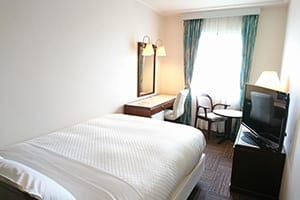
COURT HIROSHIMA
The rooms here are tiny but for the cost, you can hardly complain. At rates around US$50, you’re walking distance from the Hiroshima tram and in between the train station and the downtown core. Note that they only offer free wired internet.

DAIWA ROYNET HIROSHIMA
Conveniently located in Hiroshima ‘s main commercial district, it’s just a 1 minute walk to Chudenmae Tram Station. This property is affordably under US$100 and offers free wifi which is key. Walking to Hiroshima Peace Memorial Park only takes 10 minutes.
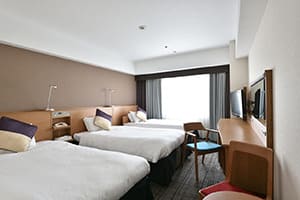
HOTEL GRANVIA HIROSHIMA
Ranked #2 in Hiroshima, this hotel is directly connected to the JR Hiroshima station which makes it uber convenient. Also, you’ll find that the rooms are larger than most hotels in Hiroshima. Wifi is free as well.
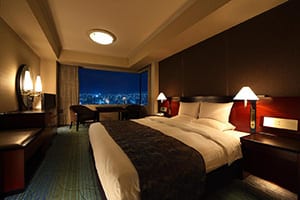
RIHGA ROYAL HOTEL HIROSHIMA
Smack right in the middle of the Hiroshima core is this top-end hotel that can only be described as grand. As more of a business-hotel, the rooms are extremely spacious but some have said are a bit dated. The best part is that it is only 5 minutes away from the city’s main attractions.
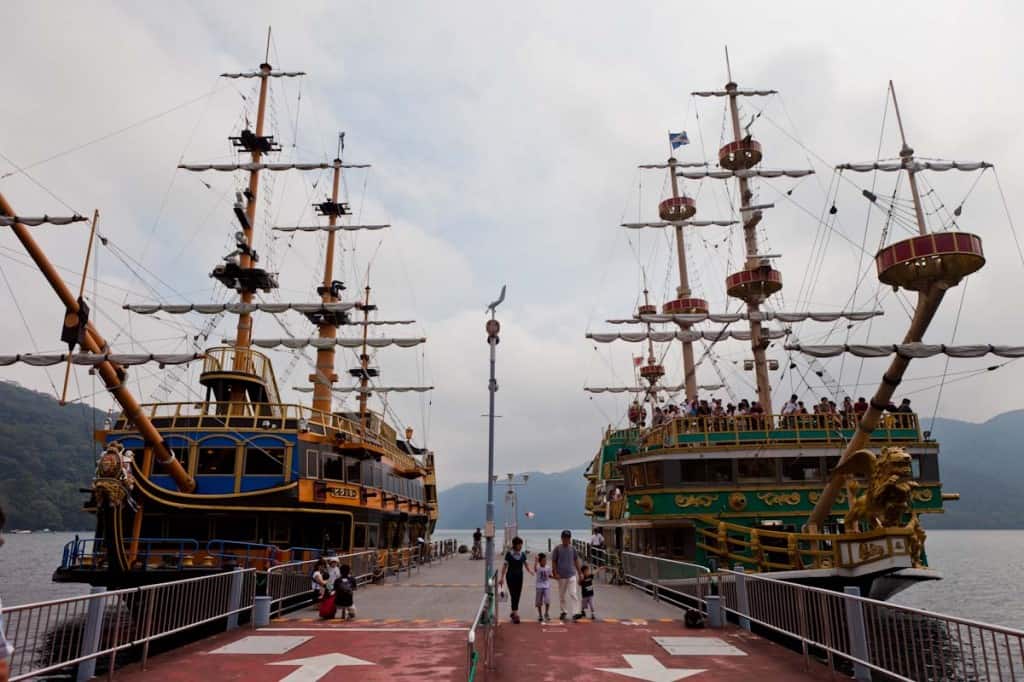
Hakone Free Pass – If you’re going to be going to Hakone and going to do the round-the-city tour like we did, this is the one to get. 5000 JPY can’t be beat. Get an earlier start than we did and in one day you can pretty much see all the main sights and activities in Hakone.
Hot Springs for Couples – Do your research beforehand and if you’re not sure, ask your concierge if you have any questions or get them to call to get the answers. If you’re looking for hot springs for couples, they are rare in Hakone. The onsen we ended up choosing was Tenzan and they had them available but only for 2 hour time slots. On top of that, you can only reserve them when you get there. There are only 3 or 4 of these type of rooms but you only get one temperature pool and that’s it. We opted to go to the regular onsen area as we wanted to experience it to its fullest (nude and all).
The visuals really tell the story of why it was so easy to fall in love with Japan in a matter of 12 days. Here’s a glimpse of the things I was able to capture.
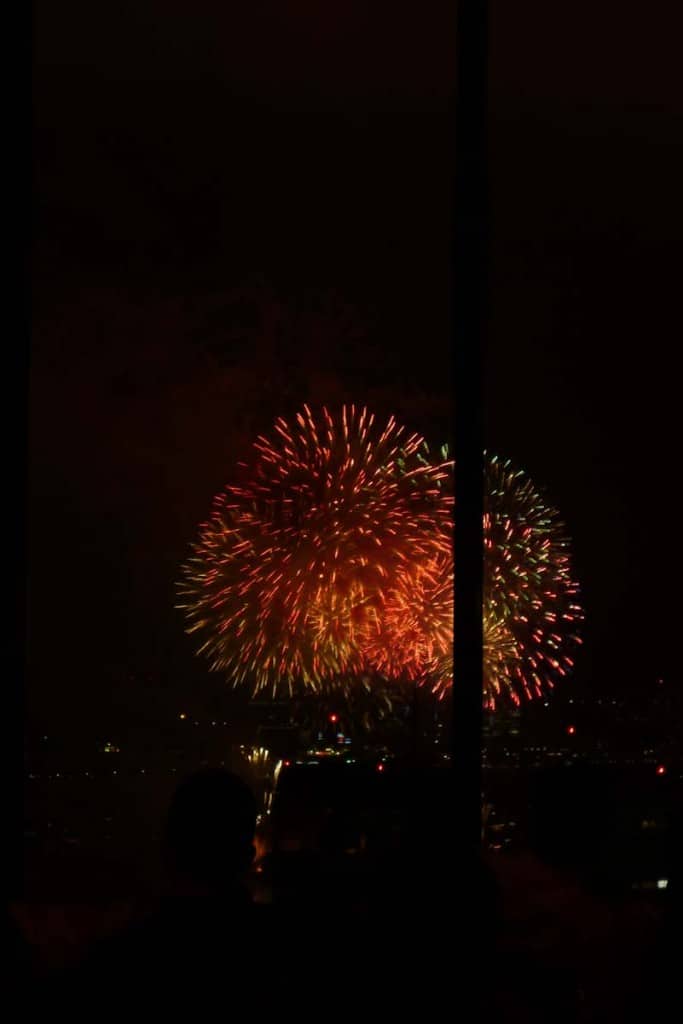
Read More About Japan
- Guide to the Must-Try Food in Osaka
- Where To Stay In Hiroshima – A Guide To The Best Hotels and Neighborhoods
- Top 5 Things to Do in Hiroshima, Japan
- When Is The Best Time To Go To Kyoto?
- Immerse Yourself in Japanese Culture in Kyoto
About William Tang
William Tang is the Chief of Awesome behind the award-winning Going Awesome Places which is focused on outdoor adventure, and experiential travel. His true passion lies in telling stories, inspiring photography and videos, and writing detailed itineraries and travel guides. He is a member of Travel Media Association of Canada (TMAC), Society of American Travel Writers (SATW), Adventure Travel Trade Association (ATTA), and Travel Massive. He has also been featured in publications such as Reader's Digest, Entrepreneur, Men's Journal, and Haute Living. Make sure to learn more about William Tang to find out his story and how Going Awesome Places started.
Find us on social media

Japan Itinerary: 12 Days in Tokyo, Kyoto, Osaka & Hakone
Last updated on March 8th, 2024 at 09:58 pm
Japan offers an incredible juxtaposition of modern technology alongside ancient temples and traditions. It is also one of the world’s safest countries, making it an ideal travel destination. The frenetic energy of bustling Tokyo, with more Michelin star restaurants than anywhere else on Earth, dazzles both the eyes and palate. For over 1,000 years Kyoto was the capital of Japan (from 794-1868) and still reigns as the traditional heart of the country. Kyoto features a staggering 17 UNESCO World Heritage Sites.
If you take a two-week vacation, you will have around 12 days to explore Japan. This 12 day Japan itinerary covers a variety of significant highlights in Tokyo, Kyoto, Osaka and the resort town of Hakone near Mt Fuji. This is an ideal itinerary for experiencing the cultural highlights of Japan, including a wellness escape!
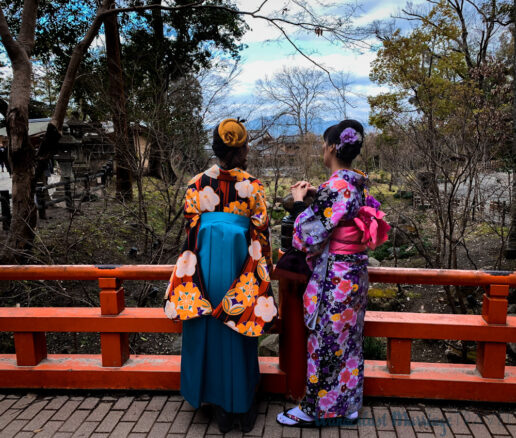
Tokyo – 4 Days
Tokyo airports – arriving in tokyo.
Metropolitan Tokyo is the world’s largest city, with a staggering 37 million people! This is an exciting entry point for most visitors to Japan. Two airports serve Tokyo – Narita and Haneda. I flew into Narita Airport and out of Haneda Airport to the USA. Narita Airport is further from Tokyo but is served by a high-speed train.
I was curious to fly in and out of both airports and the times worked well to do that. The only downside to that is having to figure out one more thing during your journey. If you’re more the routine type, pick one of the airports to fly in and out of if you have the choice. That way, you have one less thing to worry about for your Japan itinerary.
Japan for Couples or Solo Travel
I traveled to Japan solo, en route to Australia last year. Bell had limited time to only visit her home country of Australia. Also, she previously traveled around Japan solo, in 2003, before we were together. So traveling around Japan was not as much of a priority for her compared to places she has not visited yet. But for me, traveling to Japan was really high on my travel list, and I had more time. So a solo trip worked out well for both of us. Anyways, the tips below are suitable for both couples and solo travel!
Tokyo Highlights: 12 Day Japan Itinerary
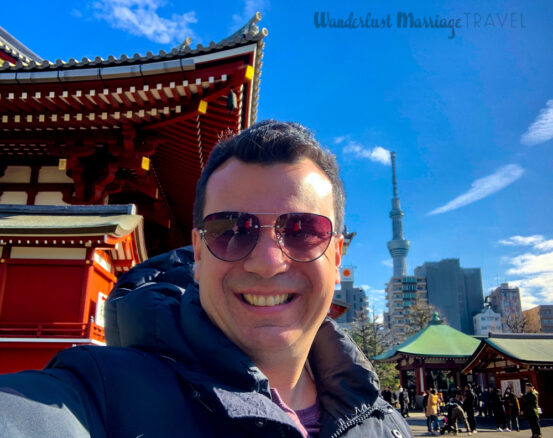
Asakusa is a traditional neighborhood famous for the Senso-Ji Temple. The Buddhist temple is dedicated to the bodhisattva Kannon and is considered the most important temple in Tokyo. The neighborhood is also wonderful for its variety of small stalls selling street food ranging from fried fish to sweet treats. It is generally considered impolite to eat while walking in Japan (partly because of how crowded it can be), but is socially acceptable in areas like Asukusa, where street food is sold. A visit to Asakusa is a must on a Japan itinerary. This is the favorite district of many that visit Tokyo.
Tokyo Imperial Palace
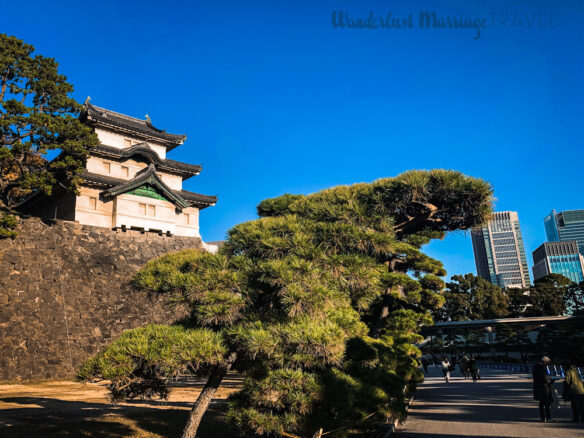
Built in 1457, Tokyo Imperial Palace is home to Japan’s royal family. It is located in the center of Tokyo, a short walk from Tokyo Station. The large park is surrounded by massive stone walls and moats. 75 minute tours in English and Japanese are conducted on the palace grounds. You can book a tour on the Imperial Household Agency website. Plan to book tours in advance, though same day tours are possible.
The inner grounds of the Imperial Palace are closed to the public except for January 2nd (New Year’s Greeting) and February 23rd (Emperor’s Birthday).
The Imperial Palace East Gardens are open to the public throughout the year. I did not book a tour time and enjoyed the gardens, bridges and centuries old architecture along with throngs of other visitors.
Tokyo Skytree
Tokyo Skytree is the tallest building in Japan. At 634 meters (2080 feet), it is also the world’s tallest tower and second tallest structure after the Burj Khalifa in Dubai. There are two observation decks on Tokyo Skytree – at 350 meters and 450 meters. The tower is open from 9am-9pm 365 days a year. It is one of the most popular tourist attractions in Japan so it’s often busy. Book tickets in advance to save time!
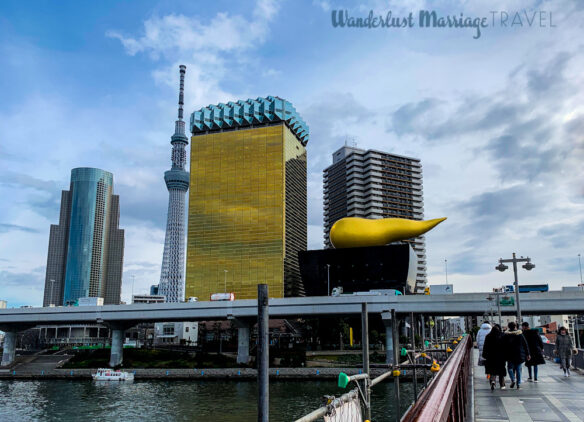
In the above photo you can also see the golden flame atop the Asahi Group Head Office Building. Some jokingly call it the “Golden Turd.” What do you think?
Ueno Park is home to many museums and temples. It features beautiful cherry blossoms in the spring and colorful foliage in autumn. It is one of Japan’s five oldest public parks and was probably my favorite park in Tokyo for strolling and admiring the scenery. I was captivated by the vibrant foliage and people watching in Ueno Park. You can also plan a visit to Ueno Zoo and admission is just 600 yen ($6 USD).
Along with Asakusa, Ginza, Shinjuku and Shibuya, Akihabara is one of the most interesting districts of Tokyo to visit. It is famous for its electronics retailers, ranging from large department stores to tiny stalls. This is also the cultural epicenter of manga, anime and video games. For the uninitiated like myself, stepping into a manga retailer is like exploring another universe.
The maid cafes in Akihabara are a unique spectacle. Maid cafes are where adorably dressed girls serve food and perform on stage in maid outfits. You can’t miss them as the girls stand out front handing out fliers. Do not expect an amazing culinary experience at a maid cafe. But it is a quintessentially kitsch Japanese tourist experience.
Plan to spend a few hours in Akihabara as it is one of the most unique districts in the world. It is likely you will stumble upon things you have never seen before.
Tokyo Tower
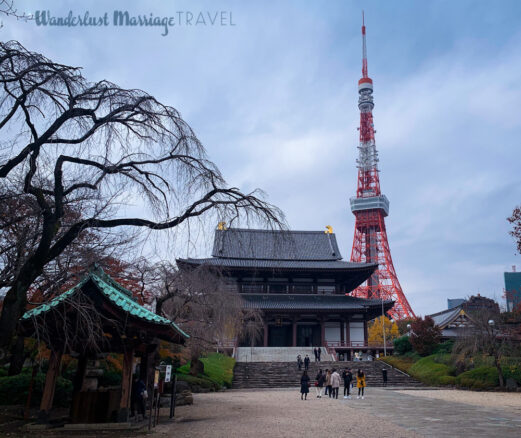
At 330 meters, Tokyo Tower is the second largest building in Japan. The Eiffel Tower inspired lattice tower serves as an observation deck and communications tower. Tokyo Tower offers sweeping vistas across the world’s largest city. I appreciated that there was no line to take the elevator to the 150 meter observation deck on the mid-December weekday morning I visited. There is always a line to go up the Eiffel Tower in Paris! There is a second observation deck at 250 meters, offering an even higher birds eye view.
Zojoji Temple
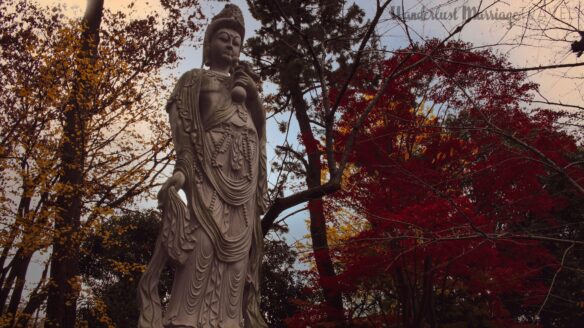
Across the street from Tokyo Tower is the impressive Zojoji Temple. It is the main temple of the Jōdo-shū Chinzei sect of Buddhism in the Kantō region. The temple complex houses the tombs of six Tokugawa shoguns. It is just a 5 minute walk from Tokyo Tower and a 10 minute walk from Hamamatsucho Station. The gardens are impressive to stroll, and I was surprised to see such vibrant autumn foliage the second week of December. Plan to visit Tokyo Tower and Zojoji Temple the same day. Keep backtracking to a minimum during your Japan itinerary, as Tokyo especially is a massive city.
Ginza is Tokyo’s most famous high end shopping, dining and entertainment district. The area is packed with luxury retailers, along with swanky cocktail and sushi bars. Traditional Japanese dance and drama can be watched at the famed Kabuki-za theater. Most shops in Ginza are open everyday. A particularly pleasant time to visit is weekend afternoons when central Chuo Dori closes off to cars and becomes a large pedestrian zone.
Fun fact: 2 million passengers pass through Shinjuku Railway Station each day, making it the world’s busiest train station. Visit one of the observation decks atop the Tokyo Metropolitan Building. The 243 meter tall building has two towers, each houses a free observation deck at 202 meters. On a clear day you can see Mt Fuji, Tokyo Skytree, Tokyo Tower, Meiji Shrine and the Tokyo Dome.
Shinjuku bustles with night clubs, karaoke rooms and endless shopping options. Enjoy dishes like tempura at a lively izakaya, where locals dine and catch up over beers, cocktails and sake.
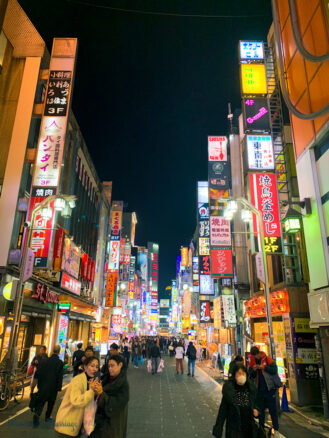
Shinjuku is also home to Tokyo’s Red Light District. Unfortunately, many of the strip clubs that cater to foreigners are run by the Yakuza (Japanese mafia) and are not reputable establishments. Check google reviews before going into any of the girly clubs in Shinjuku. Do not go into any of the clubs where people try to pull you in off the street. You will get ripped off. This makes Shinjuku the most unsafe district of Tokyo – but if you stay out of the shady sex clubs and use common sense regarding personal belongings, it’s fine to walk around the district.
Want to witness the busiest pedestrian crossing in the world? Head to the Shibuya Crossing. Every time the street lights change around 2,000 people cross the street simultaneously. You will also find a wide variety of shops and good restaurants in Shibuya. If you’re short on time, pop into a ramen restaurant for a fast and delicious bowl of piping hot noodle soup. You can even hang out in a cat cafe, playing with adorable kittens while sipping a latte. Plan to spend a few hours of your Japan itinerary in this interesting district of Tokyo.
Delicious Sushi Throughout Tokyo
There are so many culinary delights in Tokyo, but be sure to enjoy the excellent sushi. There are so many great options so just check reviews to be sure. Conveyor belt sushi establishments have become popular around Tokyo. They typically don’t serve the highest quality sushi, but they’re good and very handy if you just want a quick and inexpensive bite. Check the colors of the plates carefully if you don’t want to spend too much. For example, you may think a plate is white, but it is actually a more expensive pale blue or pink plate. Very sneaky!
Even Japanese 7-Eleven’s sell tasty packaged sushi rolls and salads. The options are healthier and tastier than American 7-Eleven’s. Several days I just wanted a quick lunch to continue exploring an infinitely fascinating city, and 7-Eleven sushi rolls fit the bill.
Tokyo Hotels
Shangri-La Hotel Tokyo is an excellent choice for a luxury stay. Elegant and spacious rooms feature floor-to-ceiling windows with city or bay views overlooking the Imperial Palace, Tokyo Sky Tree and Mount Fuji on clear days. Along with a 50 foot heated pool, their onsite spa, CHI, offers a range of treatments and relaxing massages. Onsite restaurants include Nadaman, serving fine Japanese cuisine and sushi and the elegant Piacere, serving gourmet Italian food. It is conveniently located right next to the JR Tokyo Station.
The Strings by Intercontinental is another great choice for a luxury stay in Tokyo. Rooms at The Strings showcase tasteful Japanese design, with large windows that offer panoramic skyline views. China Shadow Restaurant serves authentic Chinese dishes with 26th-floor views. Their elegant Dining Room serves international fusion fare. The adjacent JR Shinagawa Train Station offers easy access to Shinkansen bullet trains to Osaka. Local trains on the Yamanote Line run directly to the Shibuya and Shinjuku areas in around 20 minutes. The Airport Limousine Bus runs directly from Narita International Airport, taking around 90-minutes.
Park Hotel Tokyo is a comfortable choice that won’t break your budget. Guests can enjoy sweeping views of the world’s largest city over a drink from the mini-bar. Shinbashi Train Station is just 1,000 feet away, conveniently connecting you to the rest of the city. The hotel offers 6 food and beverage options, including French and Japanese cuisines. A lounge, cafe and bar are also located on-site. Park Hotel Tokyo is close to Hamarikyu Gardens, Tsukiji Fish Market and the Ginza shopping area.
Japan is famous for its luxury cabin and capsule hotels, that sometimes include traditional onsens. They make for especially great value for solo travelers. Read my article on what to expect at cabin and capsule hotels in Japan , ranging from budget to mid-range.
First Cabin Shinbashi Atagoyama
First Cabin Shinbashi Atagoyama is excellent value for a cabin stay in Tokyo. Upon arriving in Tokyo, I spent my first three nights there and found it ultra modern, comfortable and welcoming. Many amenities, like toothpaste and toothbrush packets, hair brushes, cotton swabs, soap and shampoo are provided in small bins in the bathrooms.
There are separate cabin floors for males and females, so mixed couples will not sleep on the same floor. But they have a cozy lounge, open to everyone, to enjoy a meal or a drink together. It is excellent value starting at around ¥ 3,600 ($35 USD) per night. It is perfect for those that want to save money, while sleeping comfortably during their Japan itinerary.
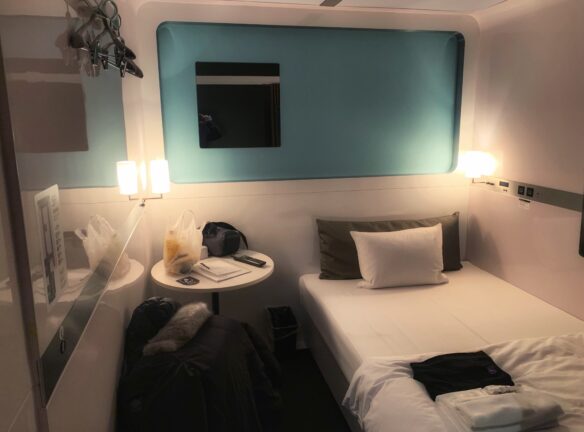
Global Hotel Tokyo
The Global Hotel Tokyo has 74 capsule rooms that are fitted with all the necessities for a comfortable budget stay. While the capsule rooms are small in comparison to first class cabins or premium capsules, they’re cozy. Capsules feature free WiFi, and amenities like toothbrushes and toothpaste and soaps. Rooms are around ¥ 3,500 ($34 USD) a night.
Global Hotel Tokyo offers an ideal location for exploring Tokyo. It’s a 5 minute walk from the Shin-Okubo Railway Station on the Yamanote Line in Shinjuku. The Yamanote line is Tokyo’s circular line so you can easily visit places in the world’s biggest city with a stay there. It’s also a close walk to Kabukicho entertainment district and 20 minutes to Shinjuku train station, the world’s busiest train station.
Kyoto – 4 Days
Kyoto is smaller than Tokyo and Osaka, but the greater area is still home to 2.6 million people. It is the traditional heart of Japan, with a staggering 17 UNESCO World Heritage Sites! You need time to experience Kyoto, also because the worthwhile temples and palaces are quite spread out. If you only visit two cities in Japan, fly into Tokyo and then catch the bullet train to Kyoto. It is an absolute must on a Japan itinerary.
Kyoto Highlights
Fushimi inari-taisha shrine and the torii gates.
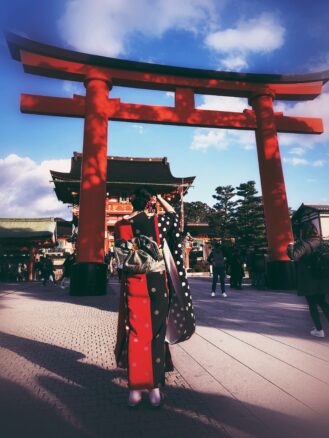
One of the most iconic images of Japan are the Torii gates at the Fushimi Inari-taisha Shrine in Kyoto. The important Shinto shrine is located just outside Kyoto, and can be easily reached on a short train ride. Thousands of vermilion Torii gates line a network of trails that zig zag up the mountain. Traditional teahouses and small shrines dot the trails. And the hike offers a refreshing reprieve from the congested crowds of densely packed Japanese cities. This is one of the 17 UNESCO World Heritage Sites in Kyoto.
Gion, Kyoto’s traditional neighborhood
Dotted with wooden buildings, Gion is Kyoto’s most famous neighborhood. There is a great range of traditional Japanese restaurants, teahouses and bars along alleyways and side streets. This is also the best place in Japan to spot a geisha making her way to an appointment. Gion exemplifies a traditional Japanese urban neighborhood splintered from towering modern high rise buildings. I visited this district on a quiet mid-January day. During peak tourism season, it can be crowded. Gion is a significant highlight of a Japan itinerary!
Kinkaku-Ji (Golden Pavilion)
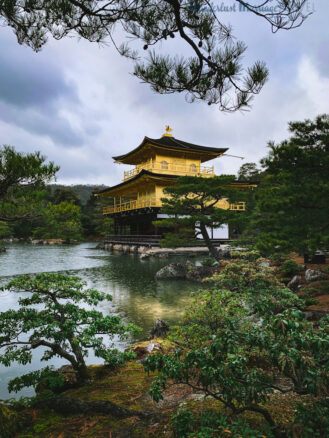
The Golden Pavilion of Kinkaku-Ji is a unique Zen Buddhist Temple. Tucked away in the northwest quadrant of Kyoto, this UNESCO World Heritage Site is a must see in Kyoto. The top two floors of Kinkaku-Ji are completely covered in golf leaf. Its picturesque lakeside setting conjures images of a Japanese Shangri-La. I visited Kinkaku-Ji on a misty mid-January day and there were still quite a few other tourists. Try and avoid going during busy summer weekends!
Nijō Castle
Nijō Castle was built in 1679 and is one of the 17 UNESCO World Heritage Sites in Kyoto. The Ninomaru Palace, ruins of the Honmaru Palace, along with supporting buildings and gardens span 275,000 square meters (68 acres). The castle consists of two concentric rings of fortifications, each made up with a wall and wide moat. While the area is vast, many of the buildings are closed to the public. Plan to a couple hours at Nijō Castle, as that will give you enough time to walk the grounds and take photos.
Kiyomizu-dera Temple
Kiyomizu-dera Temple is a Buddhist temple in Eastern Kyoto. Built to the honor the Kannon, the goddess of mercy, this is one of the most visited temples in Kyoto. It dates to 780 and its mountaintop location offers great views of Kyoto. Kiyomizu-dera Temple is one of the 17 UNESCO World Heritage Sites in Kyoto.
Kyoto Hotels
The 5-star Ritz-Carlton Kyoto is located along the Kamogawa River, showcasing iconic Kyoto views. Featuring traditional Kyoto decor, elegant guest rooms are fitted with a large flat-screen TV, Blu-ray player and a Nespresso coffee maker. Mizuki restaurant offers Japanese kaiseki multi-course meals and sushi. Other on-site dining options include Italian and French. Nijo-jo Castle, a UNESCO World Heritage Site, is a 3-minute subway ride from Ritz-Carlton Kyoto.
The Hyatt Regency Kyoto offers a luxury stay at a more affordable price than the Ritz-Carlton. Elegant rooms are decorated in light natural tones, and furnished with a 32-inch plasma TV, DVD player and safe. A mini-bar, nightwear and slippers are provided. Guests can pamper themselves with shiatsu massage, acupuncture, aromatherapy and other treatments at Riraku Spa. There are three onsite restaurants; The Grill, offers French grill dishes, Touzan serves Japanese cuisine and Trattoria Sette has Italian food. The Hyatt also has a bar, pastry shop and room service.
Tune Stay Kyoto is a great choice for a comfortable and well priced stay. The newly built modern hotel features an expansive library, common area and bar serving boutique Japanese spirits. Rooms have modern private bathrooms, TV, air conditioning and comfortable mattresses for a restful night’s sleep. I enjoyed my stay there!
WeBase Kyoto offers a clean budget stay in Kyoto. You can book dorm and private rooms. Continental and à la carte breakfast options are available each morning at the hostel.
Osaka – 2 Days
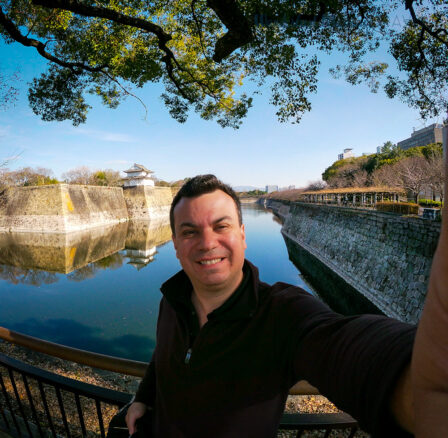
Greater Osaka is home to around 8.8 million people and is Japan’s 3rd largest city. For most travelers with limited time, do not attempt to see all the sites. It is best to focus on the Dontonburi district. This area runs along the Dotonbori canal from Nipponbashi Bridge to Dotonboribashi Bridge in the Namba district of Osaka’s Chuo ward.
Osaka is worth visiting, but many travelers, including myself, commonly say “I liked Osaka, but I preferred Tokyo and Kyoto.” I spent 3 days in Osaka, but wish I had spent 2 days there, and an extra day in Kyoto. So I factored that into this 12 day Japan itinerary for you!
Highlights of Osaka
Osaka castle.
Osaka Castle played a major role in the unification of Japan during the sixteenth century. This makes it one of Japan’s most famous landmarks and culturally, the most significant highlight in Osaka. Osaka Castle was built in 1583 and spans 2 square kilometers of beautiful architecture and green park space. The museum in the Main Tower documents the history and features great artifacts. If you visit one place outside the Dotonburi district of Osaka, you have to go there.
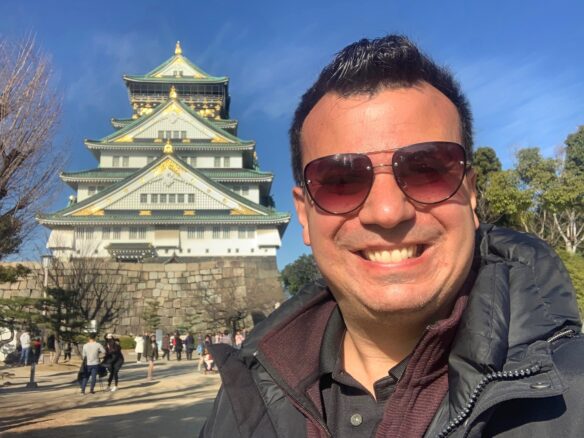
Dōtonbori (or Dōtombori), located in the Namba district of the city’s Chuo ward, is one of the highlights of a visit to Osaka, Japan. The district runs along the Dōtonbori canal from Dōtonboribashi Bridge to Nipponbashi Bridge. This area offers a huge selection of restaurants, bars, cafes, shops and markets.
You can enjoy everything from swanky Kobe beef steak to Takoyaki (octopus balls) fried fresh in a variety of street stalls along Dōtonbori canal. Check reviews carefully if you sit down for Kobe beef, as it is extremely expensive and there are some tourist traps in Dōtonbori. Takoyaki is a local specialty that originated in Osaka. It is inexpensive Japanese fast food and well worth trying.
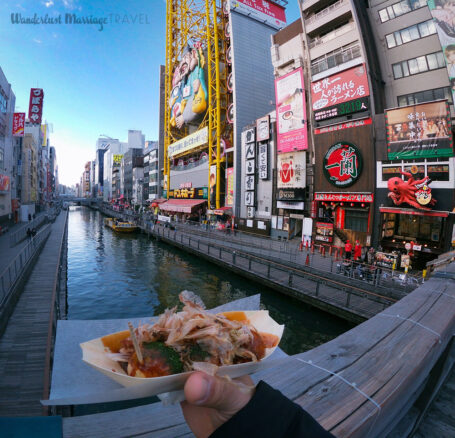
The selection of restaurants, street stalls and market food options in Dōtonbori is overwhelming. It would take well over a year of meals to try every establishment just in this district of Osaka.
Another Osaka born favorite you have to try is Okonomiyaki. It is a savory Japanese pancake made with flour, eggs, shredded cabbage, and your choice of a wide variety of protein and condiments. The name derives from the words okonomi, meaning “how you like,” and yaki meaning “cooked.”
Osaka Hotels
Conrad Osaka offers stunning views of Osaka in their modern and luxurious rooms. Spacious guest rooms include a flat-screen TV with satellite channels and mini-bar. Featuring various spa and wellness facilities on site, the hotel also has a heated indoor pool. Four on-site dining options include European, Asian fusion and Japanese. Enjoy a tasty cocktail atop their stylish 40 Sky Bar and Lounge.
Tokyo Stay Osaka Hommachi makes for a comfortable stay, with city views, that won’t break the bank. Buffet and Asian breakfast options are available each morning. The hotel is located a short distance from attractions such as Namba Shrine, Asahi Seimei Hall, Shinsaibashi Shopping Arcade and Hongan-ji Temple Tsumura Betsuin.
Hotel Cargo Shinsaibashi is an excellent premium capsule hotel in Osaka, Japan. If you want a comfortable stay that doesn’t break the bank, stay there. It’s only around a 20 minute walk to the Dotonbori district, the most interesting area of Osaka for tourists.
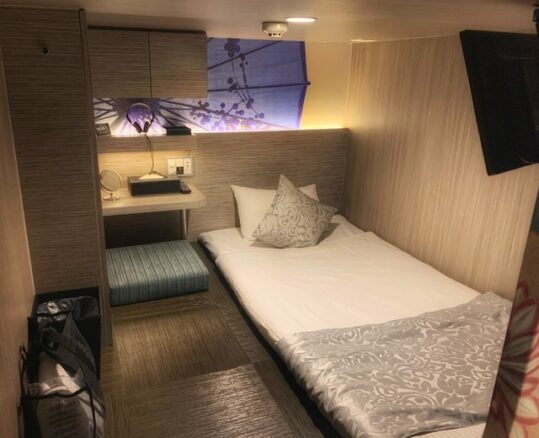
Luxury capsule rooms start at are around ¥ 3,500 ($34 USD) per night. Capsule rooms include 24 inch TV’s with free on-demand channels. A public bath and open-air bath are available in addition to shared private showers on each floor. And of course, there are the famous multi-function high-tech toilets with warm seats!
Hakone (Near Mt Fuji) – 2 Days
Hakone is a vacation destination located just 55 miles (88km) southwest of Tokyo in the Fuji-Hakone-Izu National Park. It is known for its many ryokans, traditional Japanese inns, renowned for the ultimate zen experience. They typically offer comfortable rooms, traditional kaiseki dining, mineral baths (onsen) and world class customer service. Visitors should definitely plan to stay in a ryokan for a portion of their 12 day Japan itinerary. Read my article on What to Expect at a Ryokan in Hakone .
Hakone Highlights
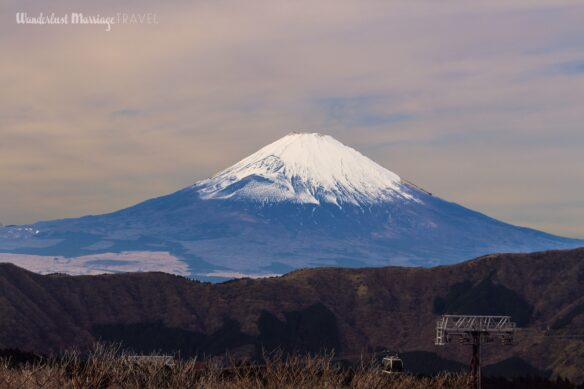
On a clear day, you can see Mt Fuji from Tokyo, from certain vantage points. But you are much closer to the famous volcanic mountain in Hakone!
Catch the Hakone Ropeway cable car for epic views of Mount Fuji. The Owakudani stop offers the most dramatic views of Mount Fuji. You also get a great glimpse of volcanic activity in the area.
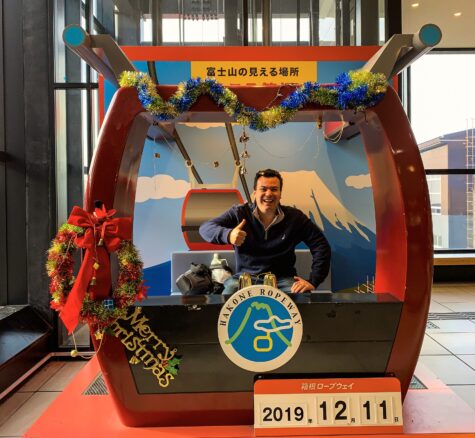
On a clear day you can see Mt Fuji from the Hakone Sightseeing Cruise across Lake Ashi. You also get wonderful views of the torii gates and shinto shrines that dot the lake. You can take the 25-minute sightseeing cruise one way, or roundtrip.
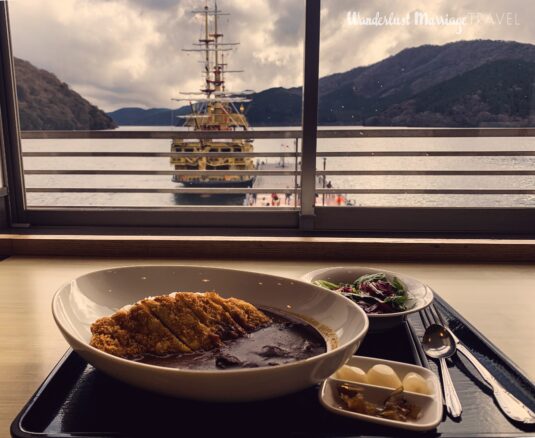
Onsen (Mineral Spa)
Hakone sits atop 40 hot mineral springs. So the town’s resorts feature onsen, with indoor and outdoor mineral pools. They are a great reprieve after a long international flight and navigating the huge crowds of large Japanese cities. It is also a great part of the cultural experience.
Kaseiki Dining
Kaiseki dining is high-end multi-course Japanese cuisine, similar to western haute cuisine. There is an emphasis on seasonality, freshness and excellent presentation. It typically consists of around 9 courses of small dishes, with various meats, seafood and vegetables. It is very detail-oriented and the food dazzles the eyes and palate.
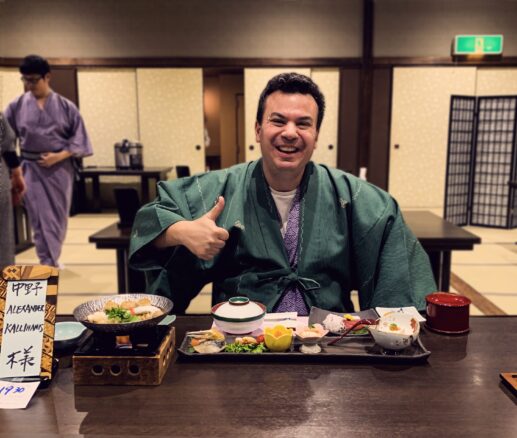
You can enjoy traditional Kaiseki dining elsewhere in Japan, but it is nice to do in a resort town. Slip on the yukata (casual komono) and slippers provided in your room and head down to the dining room for a culinary feast. The kaseiki dinner I enjoyed in Hakone was probably the best $34 USD I have ever spent on a meal.
Hakone Hotels
Hotel Musashiya is one of the best ryokans to stay in Hakone. Their hot spring baths look right out at picturesque Lake Ashi. Every room is fitted with tatami (woven-straw) flooring and traditional futon beds. Rooms are also equipped with refrigerators, TV and an electric kettle.
Hakone Airu is another of the best ryokans to stay in Hakone. Rooms have balconies with lovely mountain views. They also have air conditioning and satellite TV’s. Guests can choose between a western or Asian breakfast. Traditional kaiseki multi-course meals are served at dinner.
Mount View Hakone is a charming moderately priced traditional Japanese inn with onsen. Unlimited use of the onsen is included in the price. Dining is a la carte. I liked that concept because during my two-night stay, I enjoyed a lavish kaiseki dinner and breakfast the first day. Then I dined at some of the local izakayas (casual Japanese bar-restaurants) for ramen and katsu for other meals. From around ¥10 ,300 ($100 USD) a night per person in off-season, Mount View Hakone is the best value ryokan near Mount Fuji. During busy times like summer and holidays, expect to pay higher prices. I really enjoyed my two-night stay there! It was the most relaxing part of my 12 day Japan itinerary.
Emblem Flow is a stylish hostel in Hakone. This is a great choice for backpackers looking for a ryokan experience on a budget. The hostel offers 4 and 6 bed bunk rooms, along with private rooms. The property features a hot mineral bath. Continental breakfasts are served in the mornings.
12 Day Japan Itinerary Recap
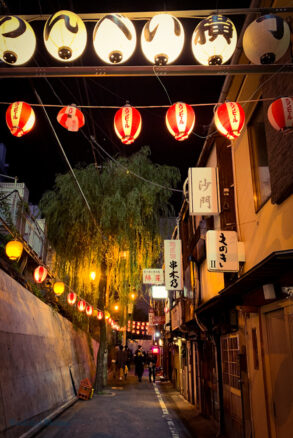
Tokyo is the world’s largest city and an exciting gateway to the nation. You need at least four days in Tokyo just to see a fraction of the highlights. Kyoto’s 17 UNESCO World Heritage Sites are spread out, so you should also allow yourself four days to explore the traditional heart of the country. Some consider Osaka the culinary heart of Japan (but you will find equally fantastic food in Tokyo and Kyoto). Plan for just a couple days in Osaka to get a taste.
Enjoy a couple days in Hakone, at the foot of volcanic Mt. Fuji for a relaxing reprieve from the crowds. Hakone is dotted with traditional Japanese inns (ryokans) with spas (onsen) and Japanese haute cusine (kaseiki). Hakone also offers spectacular views of Mt Fuji!
And voila, there is a great 12 day itinerary for Japan that won’t leave you running around too frantically. If you have questions about planning a trip to Japan, leave a comment below or email me at alex(at)wanderlustmarriage.com. I can even help you save money on your trip!
Disclosure: This 12 day Japan itinerary article contains some affiliate links. We earn a small commission when you book travel directly through them. Thank you for supporting independent travel journalism!
More from Wanderlust Marriage
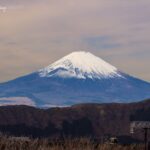
Alex Kallimanis is an award winning travel journalist and travel planner who has visited 67+ different countries, including all 27 European Union countries across all continents except Antarctica. He has resided around the world, living in countries like Australia, the Netherlands and Ireland for over 7 years combined. Currently residing in the Tampa, Florida, area with his wife Bell, he still spends much of his time in Europe as a dual Greek citizen. Alex is a graduate of the University of Central Florida with a bachelor of arts degree in history, and was the president of Phi Alpha Theta (Honors History Society) during his senior year there. Alex is an avid enthusiast of sports, spas, delicious food, the outdoors, craft beverages, history and culture.
View all posts
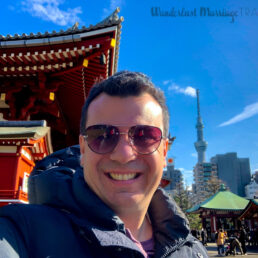
Previous Post
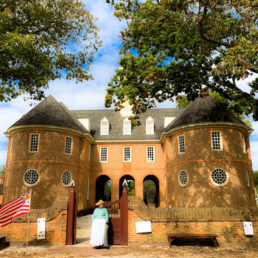
5 thoughts on “ Japan Itinerary: 12 Days in Tokyo, Kyoto, Osaka & Hakone ”
Such an amazing post please visit our blog it’s very informative Gay travel guides
Thanks, glad you found my article on planning a trip to Japan useful!
It’s very helpful thanks for sharing a great post Lgbtq
Thanks for sharing sample itineraries for Japan. My 3 adult sons are planning a 12 night visit from March 25-April 8, 2024 and as a retired teacher I am the planner. However, I was beginning to feel a little overwhelmed upon watch You Tube videos and reading blogs so I appreciated your article/ advice.
Hi Connie. Thank for your comment! So happy to hear you found this post helpful! I hope your 3 sons have an amazing trip to Japan and I’m sure they will. Wonderful that you’ve been planning their trip. Let me know if any questions arise. Happy travels!
Leave a Reply Cancel reply
Your email address will not be published. Required fields are marked *
Yes, add me to your mailing list
This site uses Akismet to reduce spam. Learn how your comment data is processed .
Nomadic Matt's Travel Site
Travel Better, Cheaper, Longer
The Ultimate Japan Itinerary for First-Timers: From 1 to 3 Weeks

I’ve yet to meet a traveler who didn’t love their time in Japan . It’s just one of those countries that everyone loves. How can you not? The food is carefully crafted and delicious; the history and culture are both rich and long; the landscape breathtaking; and the people super friendly and polite.
Japan remains one of my favorite countries. No matter how long I visit, it’s never enough. I always leave wanting more.
But the country always seems forbidding to many travelers. It definitely still has that “exotic” stereotype that makes people think it’s hard to travel around.
Where should you go? What should you include in your Japan itinerary? Should you buy a JR Pass to help you get around?
To help you out, here are a few suggested itineraries based on my years of visiting that will ensure you see the best sites on your Japan trip — as well as get off the beaten path and get a real sense of Japanese culture!
Table of Contents
Japan Itinerary: Know Before You Go
Japan itinerary: one week, japan itinerary: two weeks, japan itinerary: three weeks.

Just be sure to get one BEFORE you go as you cannot purchase them on arrival. For more information on the pass, including how much they cost and how you can get one, read this blog post . It has everything you need to know!
Mobile Data in Japan In Japan, English isn’t widely spoken (especially outside of the major cities) so having access to the internet is vital for checking addresses, using translation apps, and looking up things to see and do. The easiest way to get data is through an international eSIM for Japan .
An eSIM allows you to access mobile data via a QR code so you can have internet wherever you are, without worrying about physical SIM cards or roaming charges. This will save you a lot of time and hassle when using apps like Google Maps, Google Translate, Instagram, and YouTube. It will also come in handy for checking menus at restaurants (since they are rarely in english).

Day 1 & 2: Tokyo Chances are you’ll be starting your trip in Tokyo , since it’s home to the country’s biggest international airport. If your trip is seven days long, activate your JR Pass right away, so that you can take advantage of the free JR trains that run through the city.
While you could easily spend your entire week in Tokyo and not get bored, here are some of the highlights:
Visit the fish market – Toyosu is the world’s largest fish market. The daily auction here powers much of the world’s sushi supply, and it is truly an absolute must-see! You can go for free, but food and drink tours of the Tsukiji Outer Market are available for around 14,500 JPY.
See Sensoji Temple – Sensoji is beautifully painted and sits in a scenic spot near a five-story pagoda and the famous Kaminari Gate. There’s a huge statue of Kannon, the goddess of mercy, inside the main hall. It’s always busy but is worth seeing with your own eyes. The temple is free to visit.
Drink in Golden Gai – This alleyway of back-street bars is a lively place to drink at night and has a bit of a red-light-district feel to it. It is not to be missed. Even if you don’t drink, be sure to wander about. Arigato Tours offers tours of the area where you’ll learn about the neighborhood while stopping to sample Japanese classics like sushi, yakitori, and ramen. Tours are 23,900 JPY and include a drink and dishes at four food stops.
Visit the Imperial Palace – The home of the emperor of Japan was built in the 15th century, and while you can’t go inside, the palace and its grounds are a peaceful place for a stroll.
Watch a sumo match – If you’re in town at the right time, this is a must-do . Tickets sell out quickly, so book early. Expect to pay around 11,000-13,000 JPY.
If you have more time, consider taking a day trip to Kamakura to see the giant Buddha statue (Daibutsu). It is over 13 meters (42 feet) tall and dates back to the 13th century. The journey is around 90 minutes each way — and free with the JR Pass !
For delicious food, some of my favorite bars and restaurants include: Uogashi Nihon-Ichi (Standing Sushi Bar), Nemuro Hanamaru KITTE Marunouchi, Motodane, Tokyo Whisky Library, Ichiran Shibuya, and Uohama.
WHERE TO STAY IN TOKYO : Hostel Chapter Two – A small, family-run hostel not far from Skytree Station in Asakusa. I really like the shared kitchen and common room, as there’s a real social feel to them.

With its beauty come lots of crowds though, so try to visit outside of the busy summer months. Even with lots of tourists, though, the city is still magnificent and has a lot to offer. Some things to see and do that you shouldn’t miss are the following:
Visit the Golden Pavilion – This famous (and picturesque) temple dates to the 1950s, when a monk burned down the previous temple (from the 14th century) while trying to commit suicide. It’s a UNESCO World Heritage Site and one of the most-visited destinations in the country!
Explore Gion – Gion is the historic geisha district. Stroll along the main street and see ochaya s (teahouses where geishas entertain), the small shops, and the many restaurants that line the district’s streets. You can take a walking tour of Gion for 1,800 JPY.
Wander in the Bamboo Forest – For a relaxing break, head to Arashiyama and let the calm swaying of the forest envelop you. Located near the famous Tenryu-ji temple, it’s one of the most beautiful places in the entire country. Arrive early if you want to enjoy it without the crowds. Kyoto Bike Tours offers an early-bird bike tour for a guided way to do just that.
Admire Ryoan-ji temple – This is my favorite temple in Kyoto. It’s a UNESCO World Heritage Site and home to a mausoleum that houses the remains of seven emperors. The traditional rock and sand garden is considered one of the best in the country.
For a half-day trip, you can also visit Nara. It’s a small city just one hour from Kyoto. Nara was the capital of Japan in the eighth century, so there are lots of buildings and temples here that are upwards of a thousand years old (which is rare in Japan, due to fires, as well as World War II). But the real draw in Nara are the deer.
Since the 17th century, those in and around the city have been considered sacred. You can buy crackers to feed them or just watch them stroll around carefree. A guided half-day walking tour that includes all of Nara’s highlights as well as a traditional lunch is 11,500 JPY.
While you’re here, don’t miss a visit to Todai-ji. It’s the world’s largest wooden building and is home to a 16-meter (52-foot) Buddha statue. It was built in 738 CE and is now a UNESCO World Heritage Site. Admission is 600 JPY.
WHERE TO STAY IN KYOTO : Backpacker Hostel K’s House – A fun, social backpacker hostel in a great central location. The rooftop terrace is a cool spot to hangout and meet other travelers after a day of exploring.

Don’t miss Osaka Castle though. While it’s not the original (this version dates to 1931), it’s nevertheless an impressive sight. It’s home to a small but insightful museum and an observation deck that offers some picturesque city views.
And be sure to stroll down Dotonbori (ideally at night), the main street, which is lined with restaurants, stores, and tons of neon lights and signs. A guided walking tour that includes Dotonbori as well adjacent neighborhoods is 6,500 JPY.

Today, Hiroshima is thriving . Don’t miss the Atomic Bomb Museum, which depicts the history of the city before and after that fateful day. It has photos, artifacts, videos, and information about the effect of radiation on the population. It’s a sobering experience but one that should not be missed.
If you feel like getting out of town afterward, head to Miyajima , an island that offers a place to hike and enjoy nature. You can also take a cable car to the peak of the mountain to take in the view. A one-way ferry ride to the island takes 10 minutes and is free to JR Pass holders.
WHERE TO STAY IN HIROSHIMA : Roku Hostel – A cozy, small hostel with a rustic atmosphere and design. It feels like you’re staying with a friend here, and the beds are super comfy too.

If you like history, don’t miss the Hida Minzoku Mura Folk Village, home to a collection of traditional thatch-roof houses that you can enter to further immerse yourself in the country’s past.
This city (and region, really) is famous for its Hida beef, a high-fat variety that’s even better than any A5 Wagyu you might have. It just melts in your mouth. Be sure to have some while you are here!
The Japanese Alps are not far from here as well, so if you love hiking and want to extend your time in the region, head to Kamikochi for a day hike or overnight trip. It’s just an hour away and has both easy and moderate trails, which are open from April to November. Hiking trails can also be found in Hakusan National Park (also just one hour away by car).

One of the more unique temples in Japan is here too: Ninja (Myoryuji) Temple. While the temple wasn’t home to actual ninjas, Myoryuji was built as a defensive structure (strict laws forbade local lords from building defenses, so they were hidden in the temple to circumvent the rules). These include hidden rooms, secret tunnels, and a maze of staircases and halls to confuse enemies.
If you need a break from exploring cities, Hakusan National Park, home to Mount Haku, one of the three holy mountains, is just an hour south of town.

If you’re here in April, there are incredible cherry blossom displays that are famous in the region. And, just like Takayama, Matsumoto is close to the Japanese Alps, so you’re just a stone’s throw from some of the best hiking in the country.

There are tons of hotels (both modern and traditional) that have their own hot springs (often both indoors and outdoors). It’s the perfect place to wrap up a trip, relax, and take in the views.
In addition to getting a copious amount of R&R, be sure to ride the cable car up the mountain for even more amazing views. The area is surrounded by craters from an inactive volcano that erupted 80,000 years ago (not to be confused with nearby Mount Fuji, which is an active volcano), and you’ll find lots of vendors at the top selling eggs cooked in the sulfurous waters. It’s said the eggs prolong one’s life by seven years, so feel free to give them a try!
If you prefer to hike up instead, the trail is open between July and September, with the trek taking anywhere from 5 to 12 hours, depending on your level of fitness. Typically, hikers leave at night in order to arrive at the summit by dawn. There are little shops along the way that sell food and even beds you can rent in advance if you want to split your journey up. Just make sure you do your research and prepare in advance as it’s a tough hike!
If you really want to play tourist, you can also ride a mock pirate ship around the lake for more views of the mountains, and Mount Fuji in particular.
Full-day tours around Hakone that include all the main sights cost 14,800 JPY.
WHERE TO STAY IN HAKONE : Hotel Green Plaza – With gorgeous views of Mount Fuji, a huge buffet dinner (with both Western and Japanese options), and a private onsen where you can relax and enjoy the view, this is one of the best places to stay in Hakone if you want value but don’t want to break the bank.

Using the suggestions above, here’s how I would organize your itinerary:
- Days 1-3 : Tokyo
- Day 4 : Mount Fuji or Hakone
- Day 5 : Takayama
- Days 6 & 7 : Kanazawa
- Days 8 & 9 : Matsumoto
- Days 10-12 : Kyoto
- Days 13 & 14 : Osaka
- Days 15 & 16 : Hiroshima

If you do want to spend a few hours in Hakodate, don’t miss the Morning Market, where you can find lots of fresh seafood. You can also visit Fort Goryokaku, the first “Western”-style fort in the country.

Be sure to stop in at the local Beer Museum too, owned by Sapporo Breweries (the oldest beer company in the country). It showcases the history of beer in Japan and how the business got its start. If you’re a whiskey fan, stop by The Bow Bar, home to some rare (and expensive) whiskeys and considered one of the best such bars in the world.
What I love about the city is its location. This region has some of the best hiking in the country. There are plenty of hills and mountains, offering options for both day hikes as well as overnight trips. Some highlights include Mount Me-akan, Mount Asahim, Mount Mashu, and Nishibetsu-dake. For the best views of the city, head to Mount Moiwayama. It’s just a 30-60-minute hike to the top, though there is a cable car you can take as well.
And if you’re visiting in the winter, hit the slopes! There are over a hundred ski resorts in Hokkaido. You can rent skis (or a snowboard) for around 10,000-18,000 JPY. Lift prices are usually 4,000-6,000 JPY per day. In the winter, don’t miss the annual Sapporo Snow Festival. It’s held every February and draws over two million visitors. There are ice sculptures, igloos, live music, and delicious local foods on offer.
Additionally, be sure to take a day trip to Otaru, where you’ll find some of the freshest uni in the whole country (this is the main area where the famed Hokkaido uni is caught). Go hungry and visit the markets, stalls, and shops around there.
WHERE TO STAY IN SAPPORO : Waya Hostel – This is a laid-back, colorful hostel with a social atmosphere that makes meeting people a breeze. It has a homey, DIY feel and is perfect for budget travelers looking for a no-frills place to crash.

There is a ton to see and do in Japan , and you could easily spend another month here and still just scratch the surface (we didn’t even get to Okinawa and the islands!). And while these itineraries are a bit fast-paced, Japan isn’t cheap, so budget travelers need to move around the country quickly to avoid breaking the bank.
But no matter how long you visit, you won’t be disappointed. Japan is an amazing, beautiful, and unique destination that I never get tired of visiting. While it’s not as affordable as its neighbors, there are still plenty of ways to save money , and it’s definitely worth spending the time (and money) visiting. You won’t be disappointed!
Just make sure to get your Japan Rail Pass before you go!
Book Your Trip to Japan: Logistical Tips and Tricks
Book Your Flight Find a cheap flight by using Skyscanner . They are my two favorite search engines, because they search websites and airlines around the globe, so you always know no stone is left unturned!
Book Your Accommodation You can book your hostel with Hostelworld as they have the most comprehensive inventory so they are best for booking a hostel. If you want to stay in a hotel or guesthouse in Japan, use Booking.com as it consistently returns the cheapest rates for guesthouses and hotels.
Don’t Forget Travel Insurance Travel insurance will protect you against illness, injury, theft, and cancelations. It’s comprehensive protection in case anything goes wrong. I never go on a trip without it, as I’ve had to use it many times in the past. My favorite companies that offer the best service and value are:
- Safety Wing (best for everyone)
- Insure My Trip (for those over 70)
- Medjet (for additional evacuation coverage)
Looking for the Best Companies to Save Money With? Check out my resource page for the best companies to use when you travel! I list all the ones I use to save money when I travel — and I think they will help you too!
Be sure to check out the Japan Rail Pass if you’ll be traveling around the country. It comes in 7-, 14-, and 21-day passes and can save you a ton of money!
Looking for More Travel Tips for Japan? Check out my in-depth Japan travel guide for more ways to save money; information on costs; tips on what to see and do; suggested itineraries, reading, and packing lists; and much, much more!
Got a comment on this article? Join the conversation on Facebook , Instagram , or Twitter and share your thoughts!
Disclosure: Please note that some of the links above may be affiliate links, and at no additional cost to you, I earn a commission if you make a purchase. I recommend only products and companies I use and the income goes to keeping the site community supported and ad free.
Related Posts

Get my best stuff sent straight to you!
Pin it on pinterest.
Boutique Japan
Japan Cities, Mountains & Art (12 Days)
An active and eclectic 12-day Japan itinerary featuring the Tokyo metropolis, the Snow Monkeys in the Japanese Alps, a scenic hike on the historic Nakasendo Road, the ancient capital Kyoto, the art island Naoshima, and food-obsessed Osaka.
Let us create your trip completely from scratch.
Our sample itineraries are here to inspire, but this is not a fixed itinerary and is designed to be customized around you.

Judy Lau, Australia
Boutique Japan has made our trip to Japan brilliant and totally unforgettable. I have been to Japan many times, even studied there for some time. The experience from this trip is still right at the top of my list, in terms of accommodation, arrangement (everyone's happy!), and food (two thumbs up!!). Thank you very much… Read More
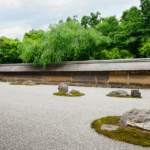
Ithka Laws & David Gabrovec, Abu Dhabi
My amazing husband worked with Boutique Japan (behind my back!) to help put together the most amazing surprise birthday trip ever. Having had the benefit of not doing any of the work but only enjoying the experience, I have to say there could not have been a more perfectly planned trip. Boutique Japan was incredibly… Read More
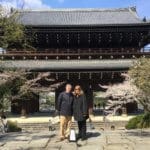
Graham & Fiona Kane, London
First of all we wish to thank you, your colleagues and all the team on the ground for a truly wonderful experience. We really enjoyed ourselves and loved Japan, its people, culture and sights. Your pre trip questioning and input helped us to put together an itinerary which fully reflected our interests whilst opening our… Read More
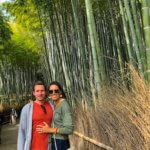
Ally Vain & Chris Tillotson, Dallas
Boutique Japan brought our dream Honeymoon Trip to life. My husband and I visited Japan to celebrate our Honeymoon and the experience Boutique Japan provided for us was more than we could have imagined. I cannot reiterate enough, we could not have done this without them! The staff was extremely responsive, professional and accommodating every… Read More
Sample Trip Highlights
- An immersive private itinerary, crafted with love by Boutique Japan
- Tokyo , one of the world’s most exciting cities
- Historic Nagano and the Snow Monkeys in the Japan Alps
- The Nakasendo Way and the picture-perfect village of Tsumago in the rural Kiso Valley
- Kyoto , the heart and soul of traditional Japan
- Stunning art and architecture on Naoshima , including a stay at Benesse House
- The fun-loving, food-obsessed city of Osaka
- All your accommodations, in boutique and luxury hotels and ryokans to match your taste and priorities
- Unique private tours and experiences with fun and knowledgeable local experts
- Seamless logistics and in-country transport via the shinkansen (bullet train) and more
- Extensive pre-departure information to help you prepare for your trip
- Access to our in-depth Japan expertise, relationships, and firsthand experience
- A Japan specialist to answer your questions, and thoughtful customer service
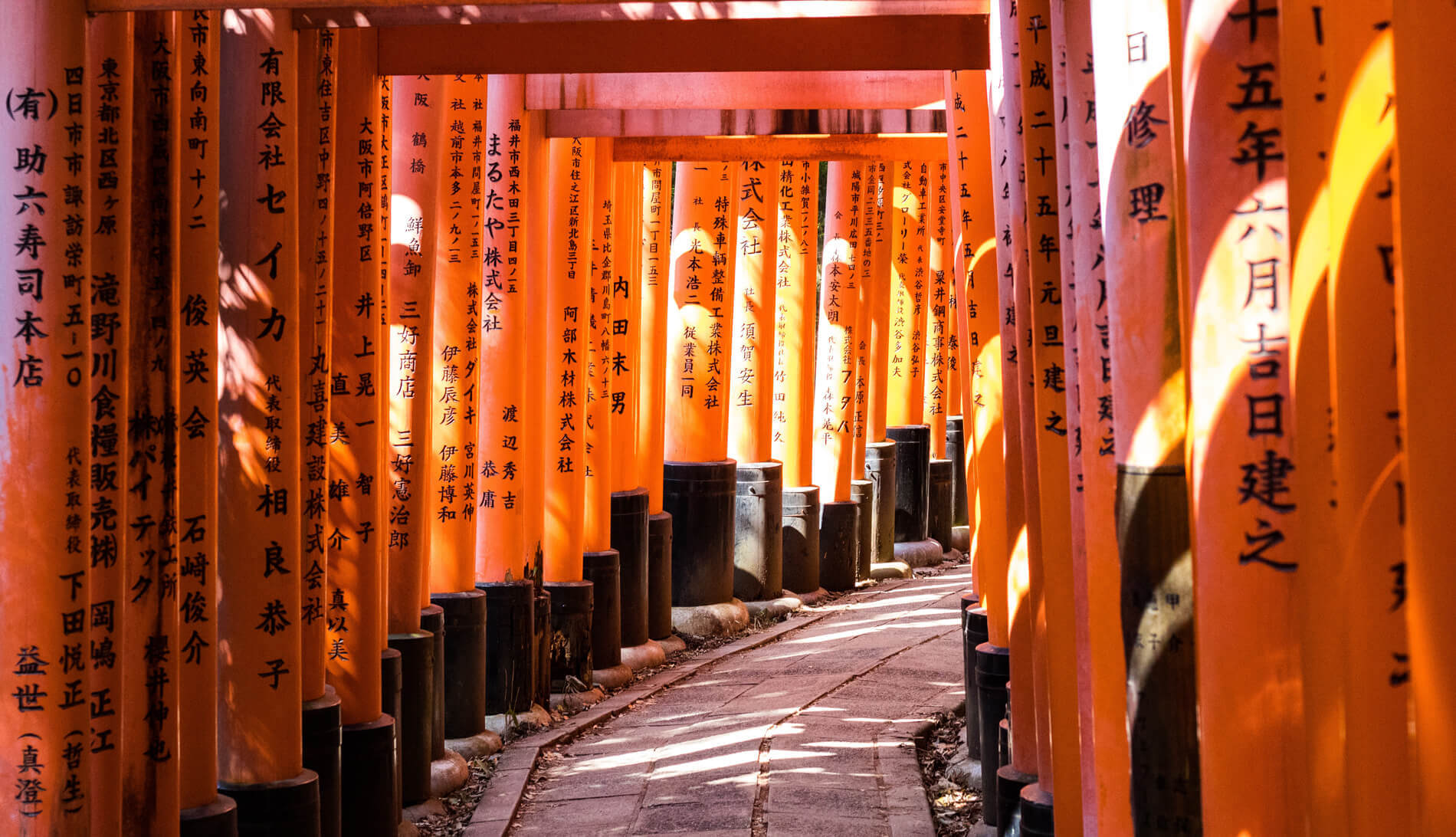
Itinerary Overview
Fly into either of Tokyo’s airports, Narita (NRT) or Haneda (HND).
This sample itinerary can also be customized to begin in the Kansai region (where Kyoto and Osaka are located), flying into either of Osaka’s two major airports, Kansai (KIX) or Itami (ITM).
Day 1: Arrive in Tokyo, Japan Day 2: Modern Tokyo Highlights & Evening Whisky Tasting Day 3: Backstreets Cycling Tour of Tokyo Day 4: Shinkansen (Bullet Train) to Nagano & the Japanese Alps Day 5: Morning Snow Monkeys & Afternoon Travel to the Kiso Valley Day 6: Walk Along the Nakasendo Way from Magome to Tsumago Day 7: Morning in Tsumago & Travel to Kyoto Day 8: Unique Highlights of Kyoto (On & Off The Beaten Path) Day 9: Day Trip to Shigaraki for the Miho Museum & Pottery Day 10: Fushimi Inari Shrine & Travel to Naoshima Day 11: Daytime Explorations of Naoshima & Evening Culinary Outing in Osaka Day 12: Depart Japan
Depart from either of Osaka’s airports, or customize this trip to end with departure from Tokyo or elsewhere in Japan.
Itinerary Details
Day 1: arrive in tokyo, japan.
Welcome to Japan! On arrival in Tokyo, you’ll be met and transferred by private vehicle to your luxurious accommodations.
Depending on your flight’s scheduled arrival time we typically recommend keeping your first evening free, both in case of unexpected flight delays, and also to account for possible fatigue from the long journey.
Settle in, adjust to your exciting new surroundings, and get ready for your adventure ahead!
Your Tokyo hotel : Palace Hotel Tokyo or Andaz Tokyo
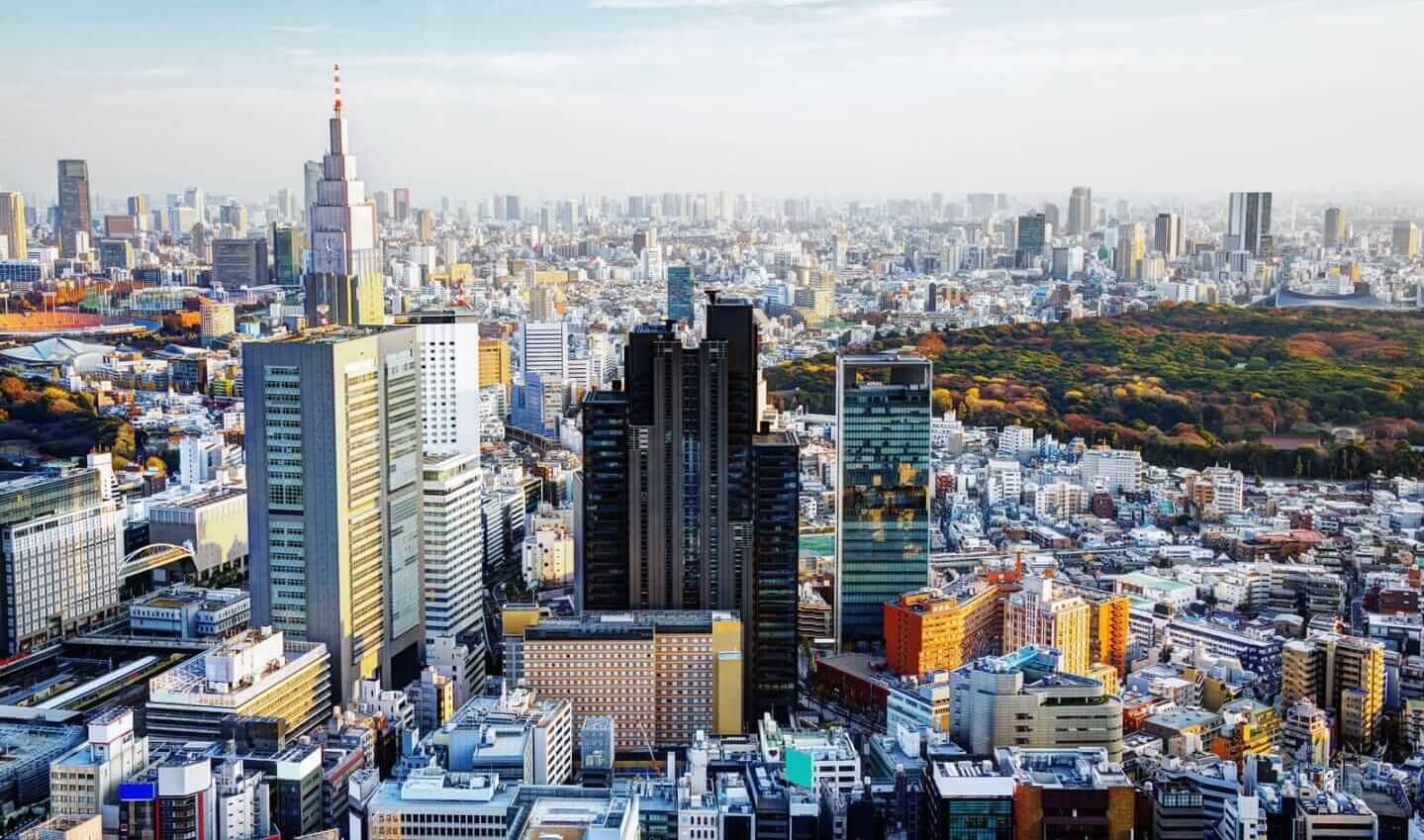
Day 2: Modern Tokyo Highlights & Evening Whisky Tasting
Ohayou gozaimasu (good morning)!
Today is your first full day to begin taking in the Tokyo metropolis. You’ll begin with an immersive half-day tour introducing you to the city, and end with a memorable Japanese whisky tasting.
After a delicious breakfast at your hotel, you’ll be met by your insightful private guide. While Tokyo can certainly be enjoyed without a guide, exploring with a fun and knowledgeable expert by your side will dramatically enhance your experience.
At Boutique Japan, we have exceedingly high standards when it comes to private guides, and carefully design each private tour to cater to your unique priorities and interests.
Tokyo is one of the world’s liveliest cities, full of amazing restaurants, beautiful gardens, stunning modern architecture, charming backstreets, and a glittering neon-filled cityscape. Beyond the city lights and crowds, Tokyo is also full of quiet neighborhoods where you’ll find locals going about their daily lives, and countless hidden gems in the form of unsung yet wonderful little shops and restaurants.
Explore unique neighborhoods such as (for example) Naka-Meguro, Yanaka, Aoyama, Omotesando, and Asakusa; along with one or more excellent museums, shrines, or gardens such as the Tokyo National Museum, Meiji Jingu Shrine, and Shinjuku Gyoen National Garden (explore more of our favorite Tokyo neighborhoods ).
Following your fascinating tour, you’ll have some time to relax at your hotel and recover from any remaining jet lag you may have, or continue exploring independently. For your free time, you’ll be able to take advantage of the pre-departure materials we provide to each of our travelers.
This evening you’ll venture out on an immersive Japanese whisky tour. Japanese whisky is world-renowned for good reason, and there are few better places to drink it than in Tokyo, which is home to some of the best whisky bars on the planet. As part of your outing you’ll visit a couple of different bars, where you’ll have the chance to sample a variety of excellent Japanese whiskies.
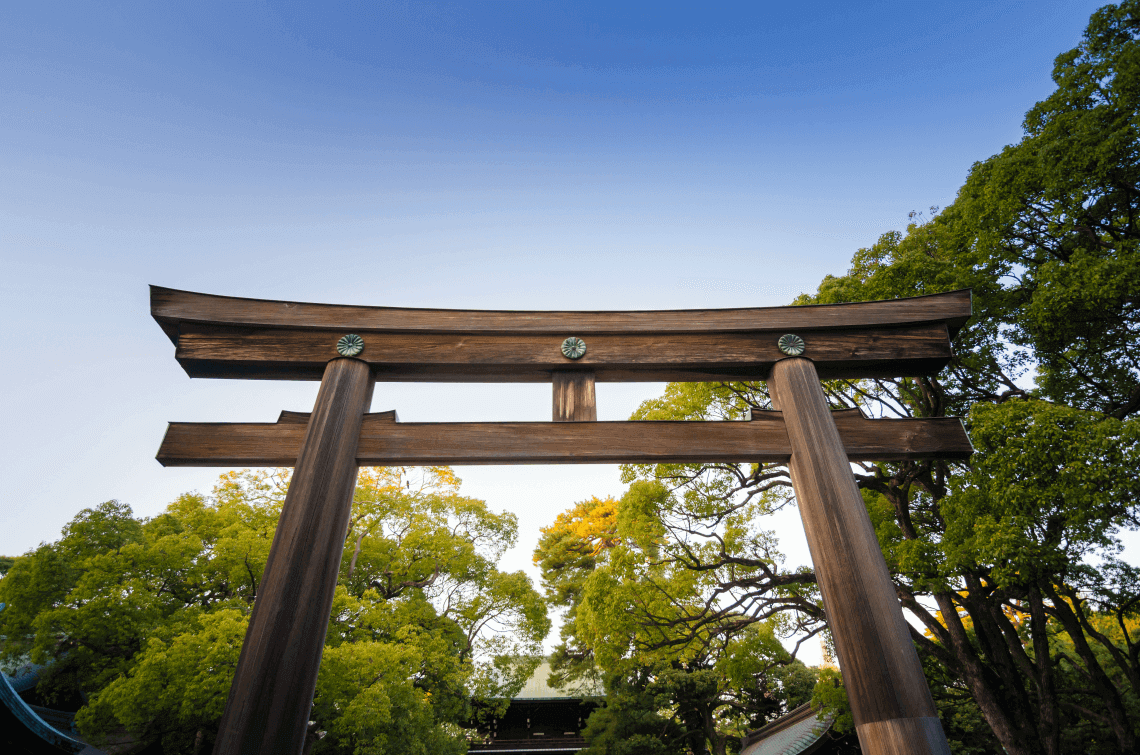
Day 3: Backstreets Cycling Tour of Tokyo
Most first-time visitors envision Tokyo as an ultra-dense, crowded metropolis. While it’s certainly true that some of Tokyo’s neighborhoods do live up to this neon-filled hype, much of the city is composed of surprisingly quiet and charming districts.
Today you’ll experience the quieter side of Tokyo as you embark on a leisurely private cycling tour of the city (urban cycling experience not required). Tokyo is a truly wonderful city for cycling, filled with eclectic neighborhoods along with polite and orderly drivers.
If you’re not interested in cycling, this tour can be modified and made into a backstreets walking tour instead.
Under the guidance of your expert private guide, you’ll wind your way through the slow-paced backstreets of a selection of colorful, off-the-beaten-path neighborhoods. As you explore these non-touristy areas, you’ll also have the chance to stop for casual street snacks along the way.
Your tour will conclude in a lively neighborhood, the perfect place to spend a couple of hours strolling, eating, people watching, or shopping. After some downtime this afternoon, head out for an incredible sushi meal or a taste of Tokyo’s legendary nightlife .

Day 4: Shinkansen (Bullet Train) to Nagano & the Japanese Alps
Enjoy a final morning free in Tokyo with the chance to visit Tokyo’s Tsukiji Market if you wish. While the wholesale section of the fish market moved to Toyosu in 2018, Tsukiji’s lively outer market remains an incredible place to immerse yourself in Japanese cuisine.
Then it’s time to leave the city for the mountains.
Today you’ll have your first experience traveling on Japan’s remarkable trains . To begin your journey into the Japanese Alps, you’ll be speeding northwest into central Japan via Japan’s iconic shinkansen (bullet train), a wonderfully pleasant way to travel. Before you depart, take some time to shop for a beautiful bento box lunch to enjoy on the journey (major train stations in Japan offer an astounding variety of delicious seasonal bentos).
On arrival at Nagano Station, you’ll make the easy change to a local train headed deeper into the Alps. But before you continue on your journey, you will have a couple of hours to stroll the charming streets of Nagano City itself.
It’s a nice walk (or short taxi ride) from Nagano Station to the magnificent Zenko-ji, one of Japan’s most important temples, with a history of 1,400 years. The small city of Nagano developed around the temple complex, and the streets leading to Zenko-ji are lined with old-fashioned shops.
Leaving Nagano, it’s a short trip by local rail to your destination for the evening. You have the option to stay in a traditional Japanese-style ryokan in a quaint onsen (hot springs) town, or a small and stylish boutique hotel in the beautiful little historical town of Obuse.
Enjoy a relaxing evening in rural Japan in preparation to visit the Snow Monkeys tomorrow morning.
Your Alps hotel : Masuichi Kyakuden

Day 5: Morning Snow Monkeys & Afternoon Travel to the Kiso Valley
This morning you will have the chance to visit Japan’s iconic Snow Monkeys, before spending the night in the picturesque village of Tsumago in the Kiso Valley.
From the entrance to the Snow Monkey Park (Jigokudani Yaen Koen), it’s about a half-hour walk to the onsen where the famous Japanese Macaques bathe. In winter the trail is often covered in deep snow, so you’ll need to dress appropriately!
Following your morning adventure, this afternoon you’ll make the easy trip south by rail into the scenic and historic Kiso Valley.
This afternoon and evening settle into the gentle pace of your rural accommodations, located in the idyllic outskirts of Tsumago village. Enjoy a rejuvenating soak in the healing onsen, a healthy and delicious dinner featuring local and seasonal specialties, and the chance to stargaze before bed.
Your Tsumago ryokan : Takimi no Ie or Fuki no Mori
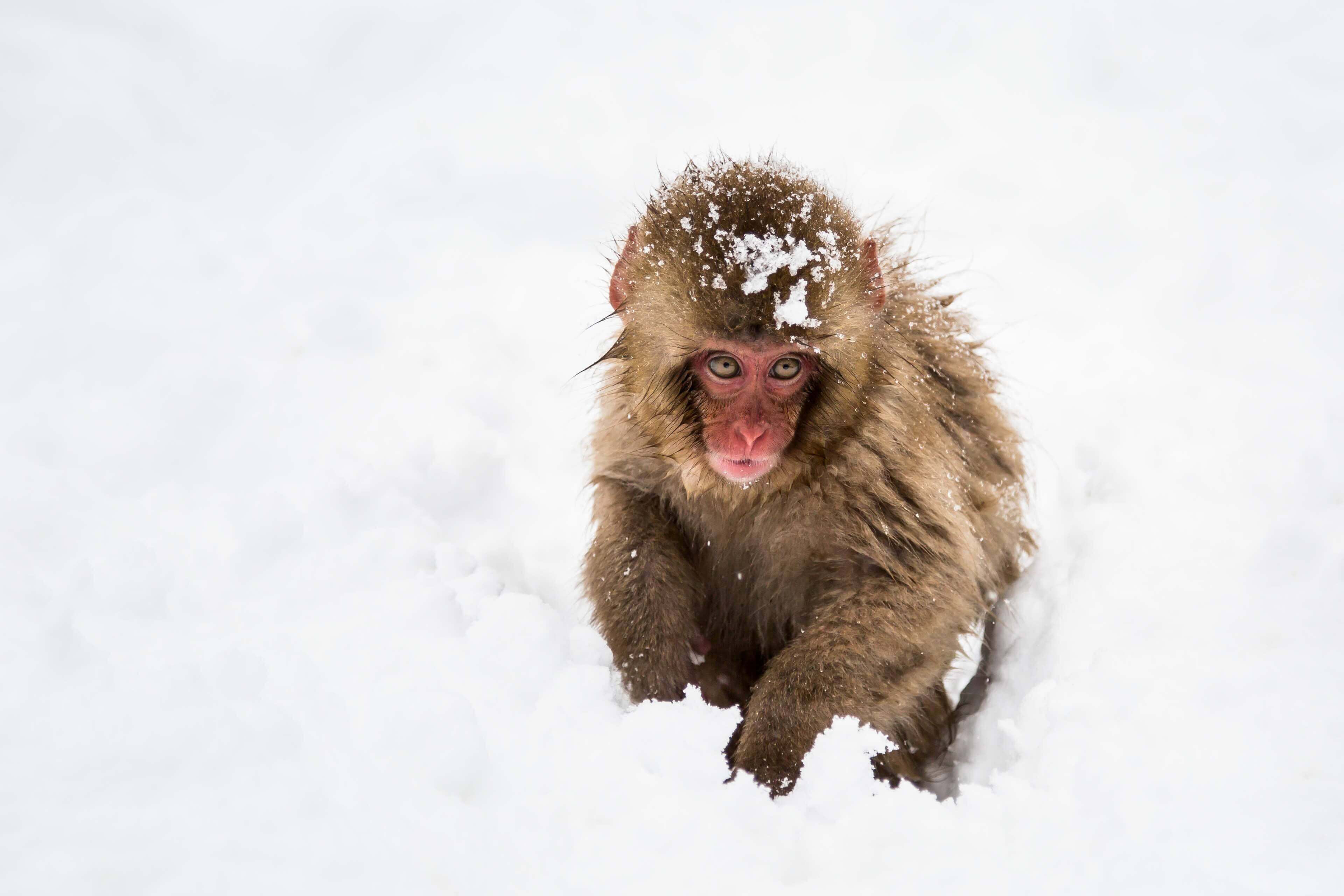
Day 6: Walk Along the Nakasendo Way from Magome to Tsumago
Enjoy an early morning soak in the onsen and a simple Japanese breakfast before your day hike. Today you’ll have the chance to walk along the Nakasendo Road, one of five routes used by samurai to travel between Tokyo and Kyoto during the Edo period.
You’ll begin in the quaint post town of Magome, which lies on a steep slope and is one of the best-preserved towns in the Kiso Valley. From here, you’ll embark on your hike to Tsumago along one of the most carefully preserved stretches of the Nakasendo (a hike of approximately 3-4 hours).
On arrival back in Tsumago, you’ll have the remainder of the afternoon free. Tsumago is one of the Nakasendo’s most beloved post towns, with good reason. The village’s residents have done their utmost to preserve an Edo-era atmosphere, resulting in one of Japan’s most delightful historical villages.
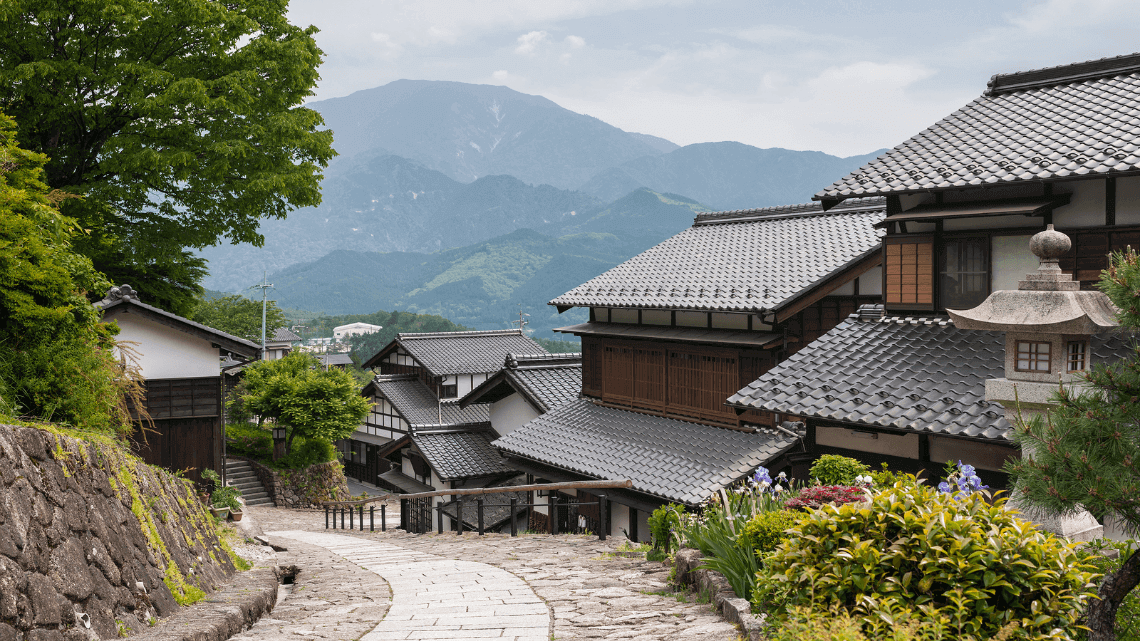
Day 7: Morning in Tsumago & Travel to Kyoto
Enjoy your final morning in the Kiso Valley. When it’s time to depart, you’ll travel by rail (including another ride on the shinkansen) to the ancient capital, Kyoto.
Kyoto is one of the most culturally rich cities in the world, and the place most travelers dream of when envisioning Japan. Home to 17 UNESCO World Heritage sites, Kyoto was the capital of Japan for over a thousand years and remains the heart and soul of traditional Japan.
Today it is a large modern city of over a million residents, and at first glance looks almost like any other Japanese town. But the city retains many of its long-established traditions, and despite the neon and concrete prevalent in many parts of town, Kyoto is teeming with beautiful and well-preserved pockets where time seems to move more slowly.
You’ll have part of the afternoon free to settle in and adjust to your new surroundings.
In the early evening, you’ll head out on a fascinating private walking tour through the backstreets of Kyoto’s best-known geisha district, Gion. As you slowly meander your way through the narrow lanes and hidden alleys of this enigmatic district, your expert guide will teach you about the history and reality of Kyoto’s geiko (as geisha are called in Kyoto) and maiko (apprentice geisha).
This is a great way to learn about Japan’s most misunderstood traditional profession, and it’s likely you’ll come across geiko or maiko en route to their evening appointments.
Your Kyoto hotel : Hotel Kanra Kyoto or Hyatt Regency Kyoto

Day 8: Unique Highlights of Kyoto (On & Off The Beaten Path)
Kyoto is full of famous sights, but to experience the city on a deeper level it’s also essential to spend time wandering off the beaten path.
No trip to Kyoto would be complete without visiting some of its remarkable temples, shrines, and gardens. For your time in the ancient capital, you will have the chance to take in an exceptional selection of Kyoto’s gems, carefully curated around your unique priorities and interests.
Explore Kyoto highlights such as (for example) the historic Higashiyama district, the charming Philosopher’s Path, and the picturesque Arashiyama district, along with off-the-beaten-path strolls through lesser-known Kyoto areas with your expert guide.
Kyoto is also rightly renowned for its cuisine and artisans. The colorful Nishiki Market is crowded but a must-visit for food and market lovers. For travelers interested in the arts and traditional crafts, the chance to visit with a shokunin (master craftsperson) in their private workshop is an unforgettable experience.
Beyond the extraordinary sights and wealth of traditional culture, Kyoto is also home to a booming creative scene, and throughout the ancient capital you’ll also find stunning modern design in museums and galleries, along with shops and cafes.
Following your private tour you’ll have the remainder of your day to relax at your lovely hotel, or continue exploring independently making use of the pre-departure materials we provide to each of our travelers.

Day 9: Day Trip to Shigaraki for the Miho Museum & Pottery
You will not run out of things to see and do in Kyoto, but rural Shigaraki in Kyoto’s outskirts makes for a wonderful day trip.
Begin at the gorgeous Miho Museum , located on a scenic mountainside. Designed by architect I.M. Pei, the striking Miho Museum houses the private collection of Mihoko Koyama, and includes Asian and Western antiques, as well as works from various ancient civilizations (the museum is closed for a large part of every year).
Afterwards, explore Shigaraki , one of Japan’s most important centers for pottery. Renowned as one of Japan’s six ancient kilns, Shigaraki is famous for the quality of its clay, evident in the lovely shigaraki-yaki (Shigaraki ware).
Day 10: Fushimi Inari Shrine & Travel to Naoshima
Before traveling to Naoshima this morning, you’ll have one final early-morning adventure in Kyoto.
An early start is necessary, as you’ll be visiting Fushimi Inari Taisha, one of Japan’s most famous sightseeing spots. Fushimi Inari is worth visiting even for people who generally avoid “touristy” places, and the easiest way to avoid crowds is by arriving early!
Afterwards, begin the easy trip to the art island of Naoshima, a must-visit destination for art and architecture lovers. The island offers a truly beguiling combination of beautiful natural scenery, charming fishing villages, and cutting-edge modern art and architecture that blend into the coastal landscape.
The journey to Naoshima is easy, with a smooth ride on the shinkansen, an effortless private transfer to the tiny Uno Port, and a short ferry across to the island. As a guest of the one-of-a-kind Benesse House, which doubles as a hotel and museum, you’ll have access to the convenient hotel shuttle making the rounds of the island’s various art sites.
Enjoy the afternoon taking in the island’s museums, galleries, and installations. Among Naoshima’s many highlights are the stunning Chichu Art Museum, the Art House Project, the Lee Ufan Museum, and Benesse House itself.
You’ll spend the night at the Tadao Ando-designed Benesse House, which overlooks the Seto Inland Sea. Guest rooms in each of the hotel’s unique buildings (Museum, Oval, Beach, and Park) feature different works of art, and — among other perks — guests of the hotel enjoy special after-hours access to Benesse House Museum.
Enjoy a peaceful evening in the laid-back Setouchi region of Japan.
Your Naoshima hotel : Benesse House
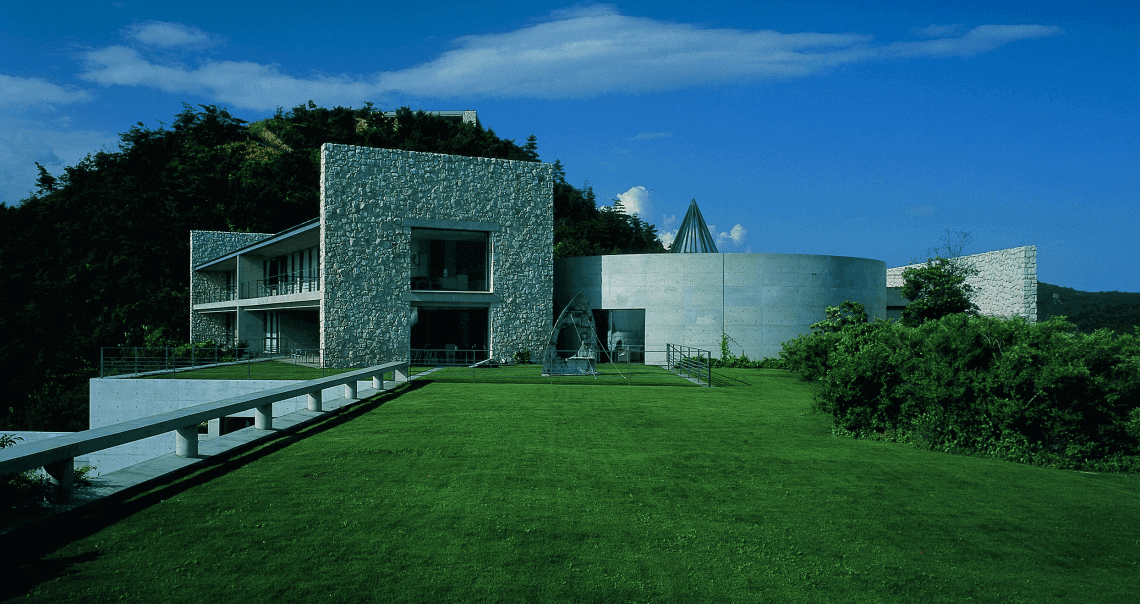
Day 11: Daytime Explorations of Naoshima & Evening Culinary Outing in Osaka
You will have the full morning and part of the early afternoon to enjoy all Naoshima offers.
After a morning of art, architecture, and island landscapes you will depart for the city of Osaka, retracing your steps by ferry and private transfer, followed by a quick ride on the shinkansen. On arrival in dynamic Osaka, make your way to your luxurious hotel in the heart of the city.
Osaka is perhaps Japan’s most food-obsessed city, and home to Japan’s most outgoing citizens. There is no better way to experience this fun-loving city than through its countless restaurants, street side stalls, izakayas , and hole-in-the-wall bars.
This evening you’ll be met by a local culinary expert who will take you on an immersive private Osaka food and sake crawl. As part of this unique outing, you’ll be sampling food and drink at a small selection of casual and delicious establishments designed to give you an authentic Osaka experience.
The perfect way to celebrate your final evening in Japan!
Your Osaka hotel : The St. Regis Osaka or Conrad Osaka
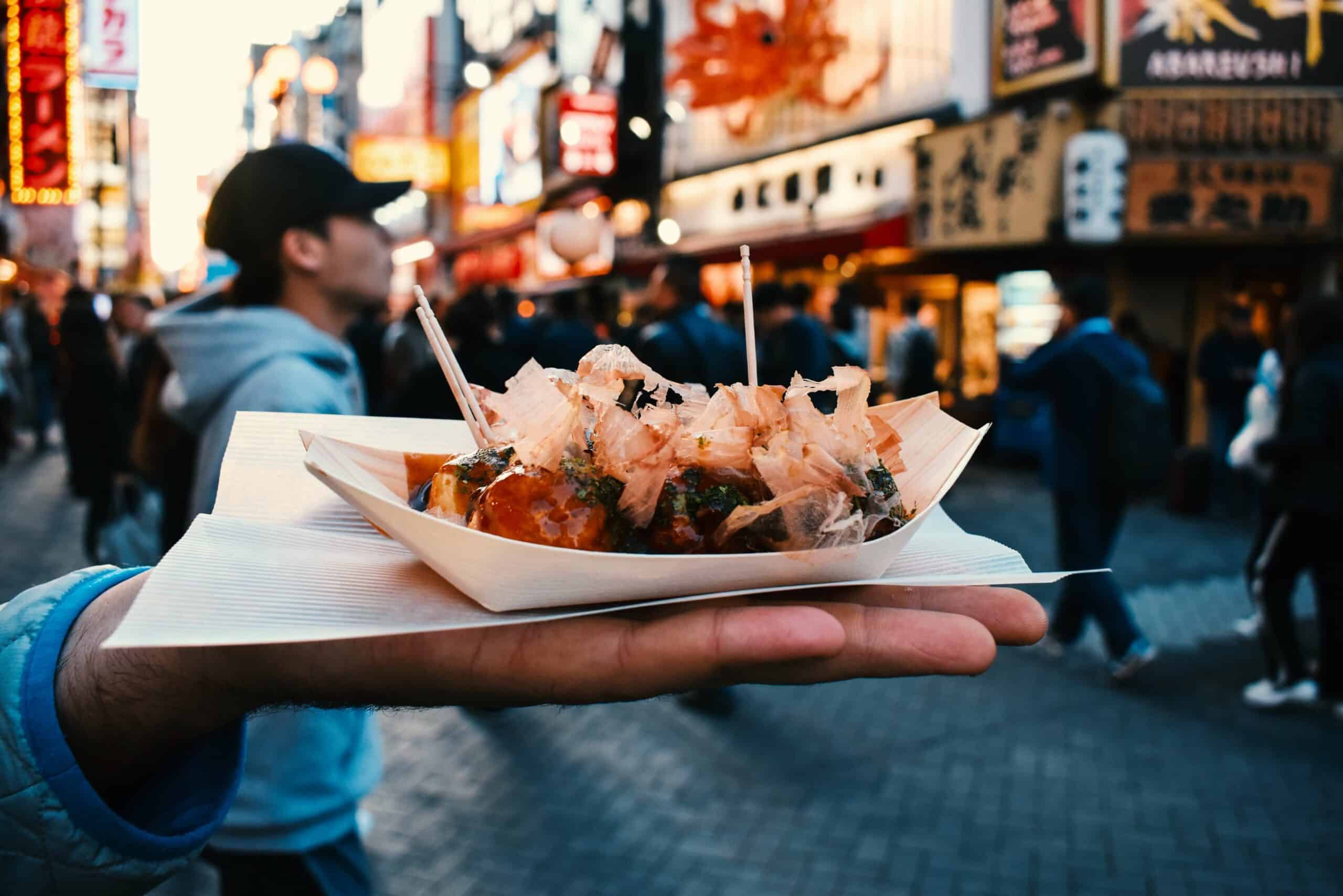
Day 12: Depart Japan
You’ll be free until departure. Depending on your flight time, you may have time for some last-minute explorations (and eating!).
In good time for your departure flight, you’ll be picked up at your accommodations for the comfortable private transfer to your departure airport.
Come back to Japan soon!
Plan Your Japan Trip
Learn more and contact us to discuss your unique trip.
Get Started
- The Process
- Testimonials
Japan trip itinerary: 12 days in Tokyo, Kyoto, and Osaka
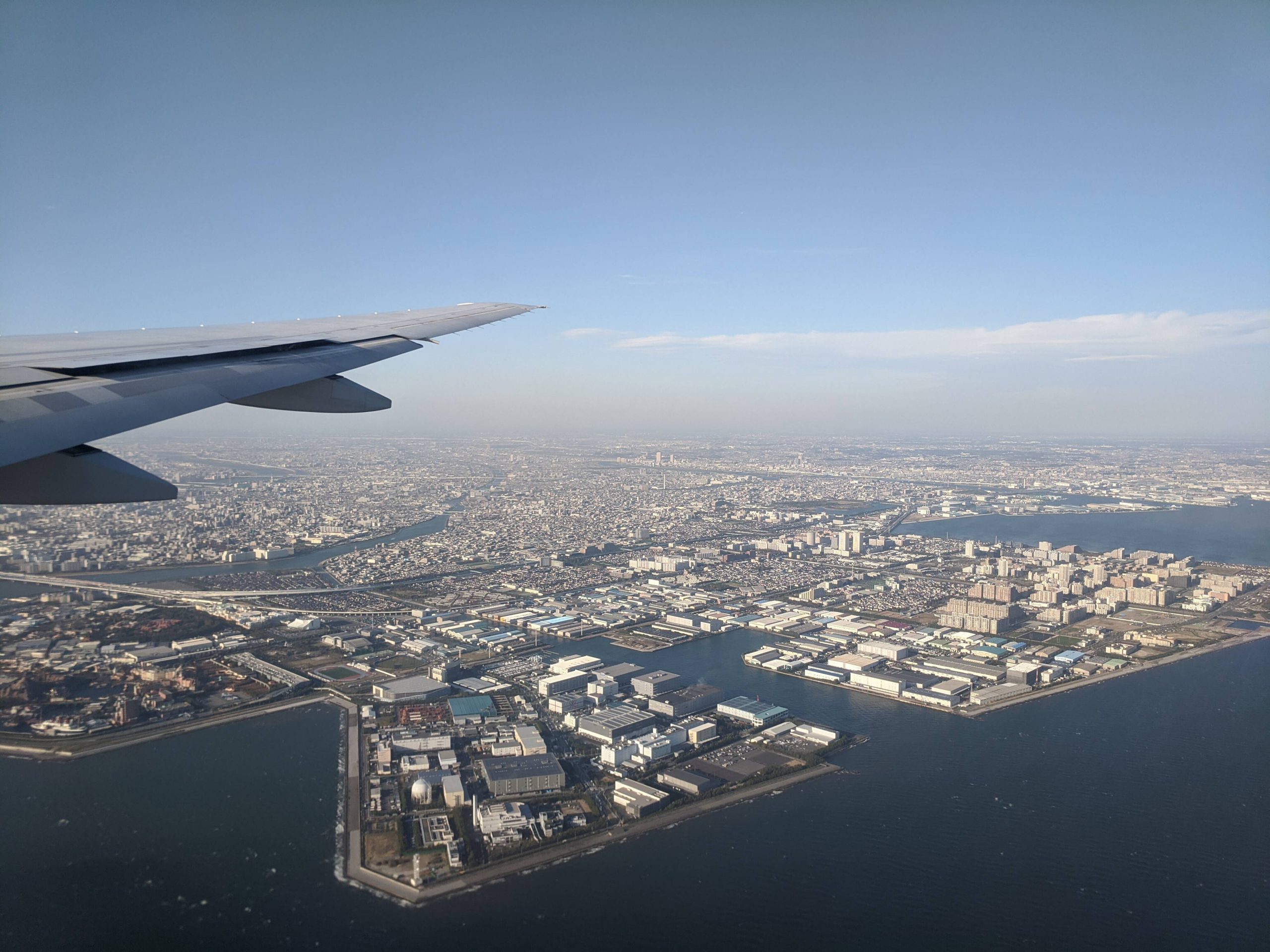
I first began writing this as a draft in December 2019, but never ended up finishing the post. Still, better late than never, I guess.
As of now, it’s been more than three years since my vacation in Japan. I couldn’t have asked for a better place to embark on my last major pre-pandemic travels. Japan is an amazing place and it was an incredible time. From November 18 to November 29, 2019, I traveled around Japan for 12 days with a friend, beginning in Tokyo, then visiting Kyoto, Osaka, and Tokyo again. Here, I want to document my day-by-day itinerary in detail (I jotted down notes every other night during the trip), so as to better remember my time there.
The trip consisted of three main legs:
Day 1: Arrival in Tokyo
Day 2: shibuya and shinjuku, day 3: more shibuya and shinjuku, day 4: shinkansen to kyoto, day 4: kawaramachi, day 5: osaka, day 6: castles and shrines, day 7: shinkansen to tokyo, day 7: asakusa, day 8: akihabara, day 9: yokohama, day 10: odaiba, day 11: nakano and kichijoji, day 12: farewell tour.
General Observations Conclusion
Part I: Tokyo (Day 1 – Day 4)
Shibuya at night
- November 18
- Arrived at Haneda airport at 3:30pm local time
- Got a Pasmo card and exchanged JR Pass voucher
- Hopped on the subway right before rush hour; messed up by not getting off at Keikyu Katawa and had to double back from Kawasaki (facepalm)
- Walked around Shibuya Station
- Walked through an overpass; was mildly lost as I had intended to visit the Phantom Thieves overpass by the Ginza line entrance but ended up in a different one
- Visited Hachiko statue and crossed Shibuya Scramble
- Settled in at the Airbnb in Shibuya
- More general walking around; ate tonkotsu ramen at Ichiran
- (Mild rain during all this, made everything very glisteny which was cool)
- November 19
- Meiji Jingu – already hella tourists by 9 am, cool big gates and shrine though
- Yoyogi Park – big and beautiful, low key hangout; not many tourists in the morning
- Walked around Shimokitazawa (very old school Tokyo vibes, and one of the few areas where I saw actual grocery stores)
- Brief visit to Sangenjaya ; Rain on the Roof was closed for lunch :(, but I saw the famed laundromat/bathhouse entrance… abided by the “no photograph” sign which I thought was funny it was there
- Shinjuku Gyoen National Garden – cool place with some beautifully juxtaposed views of nature and the city skyline, but too many tourists
- Walked around Isetan briefly (ugh, 3fancy5me)
- Looked at street food near Golden Gai but didn’t get anything (so crowded!)
- Tonkatsu/wasabi sandwich from 7/11 near the Airbnb (very solid taste)
- Met up with my friend and grabbed a casual midnight dinner (curry bowl) at a Sukiya near the Airbnb
- November 20
- Harajuku (completely dead in the morning)
- Omotesando Avenue (very upscale stores; vibes vaguely similar to Unter den Linden in Berlin; could hear quite a few Chinese tourists, as usual)
- Visited Meiji Jingu again, since my friend missed out on it yesterday
- Ate at random café in a cellar near Shibuya Scramble for lunch after failing to find a teppanyaki place at the address provided by Google Maps (in its place was some kind of beauty salon, where I inadvertently terrified the receptionist with my broken Japanese lol)
- Satei Hato coffee shop – had the Hato original blend and orange chiffon cake (amazing atmosphere and coffee and cake; unique decor for each table)
- Walked around Shinjuku and Kabuchiko (ayy lmao; sketchy “peep shows,” quasi-brothels, and love hotels—to be clear, I did not set foot or partake in any of these)
- Briefly stopped in Isetan to use the bathroom (fancy heated seats and bidet spray lol)
- Entered Sega arcade (huge; arcade upstairs, claw machines downstairs; only took a few tries to win big blue doge from the claw machine even though a few other machines took my coins and did nothing lol)
- Saw the Godzilla Head on top of Hotel Gracery (was in the afternoon so no lighting/smoke effects yet)
- Walked around more and shopped at Don Quijote (Waterfront umbrellas and Kit Kats, ayyy)
- Hit up pre-dinner street food near Golden Gai (my buddy got a fish-on-a-stick thing; nothing appealed to me much so I didn’t get anything, same as yesterday)
- Walked around shops on B1 of Shinjuku Station (huge expanse wtf)
- Visited Kiddyland (disappointing, boring and overpriced) and walked along Omotesando at night
- Briefly revisited Harajuku to see if it was more poppin at night (not at all, still very few people)
- Dinner at Tonteki near Shibuya Station
- November 21
- Shinkansen to Kyoto
- Picked up ekiben from a shop called ecute in Shinagawa Station (I chose a duck entree, which tasted great)
Part II: Kyoto (Day 4 – Day 7)
Kyoto’s Kamogawa
- Walked from Kyoto Station to fancy yet reasonably priced Airbnb (Elitz Inn) in Kawaramachi
- Walked along the banks of the Kamo River
- Stopped by Ikariya coffee for an afternoon snack (craft latte and salted milk kinako, yum)
- Explored Shijo and Teramachi until nighttime
- Walked along Pontocho at night
- Got Kobe wagyu sirloin at Pontocho Kyoshikian (delicious buttery melt-in-mouth; chef was a tall dude who made friendly conversation with us)
- Stopped at Pontocho Whiskey Museum , drank the eponymous beverage (tasted decent)
- Crossed the river and walked around Gion
- Explored Yasaka Shrine and Maruyama Park (very serene at night)
- Snackies from FamilyMart (as usual… Ohayo Jersey Milk = best pudding; wagyu steak flavored Lays chips are legit too)
- November 22
- Hankyu line to Osaka in the morning (got omegadelayed, ended up taking like 3.5 hours; also, at first we accidentally stumbled into a women-only car for a minute lol)
- Passed by the Umeda building but didn’t get out of Umeda Station , instead continued to Dotonbori
- Walked around Dotonbori (like toned down Shibuya) and grabbed some takoyaki
- Grabbed spicy miso ramen at Tonkotsu Ramen Hakata Furyu Sennichimae in Shinsaibashi (very delicious, hella big portions/refills)
- Walked to/around Tsutenkaku (did not go up the tower due to the huge line of students)
- (I think we inadvertently walked through part of Denden town to get to Tsutenkaku, but the streets were pretty quiet… didn’t see anything crazy except some mild weeb posters)
- Walked on the bridge past the Osaka Zoo / Art Museum to Tennoji Park
- Walked out of the park into an alley with random sketchy motels, then accidentally stumbled into a peace memorial/shrine which had a cool secluded overlook of the river
- Visited Osaka Castle Park (huge and amazing views, worth dealing with the large crowds of tourists)
- Went to some famed sushi place on the 5th floor of Keihan Mall Kyobashi for an early bite (solid sushi but not blown away)
- Took the Keihan line back to Kyoto (no delays this time; saloon double-decker train was cool)
Fushimi Inari at night
- November 23
- Nishiki Market in the morning for various snackies and gift shopping
- Stopped by Weekenders Coffee (random chill little spot at the back of a parking lot)
- Walked to Nijo Castle , entered castle and walked around (looked at replica paintings like the bootleg tigers lol) then walked around outside
- Stopped at random ramen place across the street from Nijojo (aight but not as good as Ichiran or the place in Osaka)
- Walked to Kyoto Gyoen National Garden , walked around the garden and entered Kyoto Imperial Palace
- Took a taxi to the south end of the Philosopher’s Path (very nice older driver, surprisingly I was able to converse with him a bit in Japanese)
- Walked north along the Philosopher’s Path (hella tourists, place was like the High Line in NY; still, beautiful little stream with fluffy duckies and red-orange-yellow foliage)
- Decided not to continue to Ginkakuji due to how ridiculously crowded the path to it was
- Chilled for a bit at Bambi Café (got blueberry tea and matcha parfait, both delicious)
- Walked west along Imadegawa-dori to a subway station and took a train back to Elitz
- Fushimi Inari at night – hiked all the way to the top and back (it was a great idea to go at night: beautiful weather, clear skies, amazing views, not crowded at all)
- Got hella expensive Kobe beef at Steak and Wine Pontocho ($200 Chateaubriand; it was really good, but Kyoshikian was much better value)
- Ultimately never got to try out the elusive ChaoChao Gyoza (always lines, then closed early; sadge)
- November 24
- Nishiki Market food tour, part 2 (got big fried shrimp, soymilk croquette, soymilk ice cream and soymilk donuts; YEET)
- Ikariya coffee, part 2 (fruit latte was really good)
- ChaoChao Gyoza for lunch!!! Classic ChaoChao gyoza, pork curry gyoza (my favorite) and shrimp gyoza, awesome sweet matcha tea
- Walked along Kamogawa then went to Kiyomizu-dera (hella crowded though)
- Walked to the outside of Kodaiji but didn’t go in
- Walked around the streets of Gion proper (skipped over it a bit the other night)
- Shinkansen back to Tokyo
Part III: Tokyo Again (Day 7 – Day 12)
Sensoji Temple at night
- Airbnb in Asakusa is awesome, right next to the Skytree (never ceases to amaze me how cool it looks, and how close we are to it)
- Wandered the streets of Asakusa at night (very chill/mellow vibes, polar opposite of Shibuya/Shinjuku) – briefly walked around Sumida Park (smaller than expected, ground was muddy from rain, and it was very misty which created a “too quiet” vibe; reminded me of when I randomly walked around at night in Barcelona) then crossed the bridge over the Sumida River (subdued/serene lighting but beautiful nonetheless)
- Walked to Sensoji Temple (beautifully lit up at night, relatively few tourists at this hour, so got some nice photos)
- Walked down empty Nakamise-dori and continued to the crazy big Vegas-esque looking 24h Don Quixote (ridiculously busy at 10pm on a Sunday… like an NY Trader Joe’s), grabbed various snackies (pudding, Cheetos, Kit Kats, etc.)
- Walked back to the Airbnb across the same bridge (absolutely stunning direct view of Skytree… I couldn’t stop looking up the entire way)
- November 25
- Late start to the day to rest up
- Walked all the way to Akihabara
- Checked out the outside of Radio Kaikan (lots of maids at every street corner trying to hand out ads for their cafés)
- Had lunch at Aoshima Shokudo (long line but was worth it, best broth I ever had and the chashu and ramen were amazing)
- Stopped for some coffee at Keys Café
- Explored Yodobashi Camera (spent way more time here than I expected, the afternoon just flew by; also, video games in YC were way more expensive than they are in the US)
- Explored Radio Kaikan (building was way smaller and had a much different layout than I expected based on Steins;Gate ; still cool though)
- Walked to Ueno Park (cool big plaza with reflecting pool, which was memorable in the night lighting; parked police car’s orange flashing lights would make for a great cinemagraph)
- Further walking to Ueno Pond (completely filled with lilies, could barely even tell there was water there) and small temple in the middle
- Rested at Airbnb for a bit then headed to Steakhouse Matsunami for a 10-course dinner (excellent service and lots of good food)
- Walked to Donki again and picked up some snackies (got some nice pics/cinemagraphic video from the Kototoi Bridge on the way there; took Azumabashi on the way back)
- November 26
- Mid-morning start to the day, took the train down to Yokohama
- Explored Chinatown and had a really fancy lunch experience at Manchinro Honten (seriously, place was huge and super fancy, very extravagant and liberal use of plates/utensils; the food was quite unique from Chinese food in the US or China, kind of like “conservative” or “streamlined” versions of authentic Chinese dishes, but not quite diluted in a cheap way like some Ameri-Chinese fusion… I liked it a lot)
- Walked around Chinatown a bit more and dropped in a gift shop to buy some souvenirs (i.e. panda merch)
- Walked along Yamashita Park for some great harbor views (random large group of girl scouts/students were walking there at the same time as us lol)
- Walked to the Red Brick Warehouse and experienced an interesting Japanese take on a Christkindlmarkt (no Lebkuchen or glühwein to be found though, darn… there were, however, lots of schnitzel and wurst advertised on flyers hung profligately from every stall)
- Went into the warehouse and explored the different shops in there
- Continued on to Minatomirai , which we explored briefly before taking the train back to Tokyo ( Roppongi )
- Arrived at Roppongi Hills and went into Mori Tower , up to the 52F observation deck (fantastic night view of the city, despite it being too dark to see Mount Fuji)
- Walked to Sakurai for a traditional tea ceremony (very cool and extremely zen, really “realized” the concept of setsuna as I smelled/sipped the delicious hojicha)
- During our 15-minute wait for Sakurai, we went to the stationery shop on the second floor (cool but hella pricey items)
- Checked out the Porter store in Omotesando (was hoping to find a bag under $150 but no such luck, these things are mad expensive)
- Super tired at this point so subwayed back to the Airbnb to call it an early night (grabbed some Karaage-kun from the neighboring Lawson , good stuff)
Odaiba at night
- November 27
- Late morning start to the day, went to Odaiba
- Got off at the Daiba stop and took in the views of the big bridge, Fuji TV building, and bootleg Statue of Liberty (lol)
- Walked past Diver City and the Gundam Unicorn statue
- Checked out the Mega Web history gallery and VenusFort (got suckered into the hyakuenya (100 yen shop) Seria , kind of fun to hunt for the Made in Japan stuff)
- Met up with my friend, continued to explore VenusFort a little bit then went to the main Toyota Mega Web Showcase (yuge space, pretty cool)
- Got lunch at Sojibo in Diver City (delicious chicken curry soba)
- Teamlab Borderless for the afternoon for some very trippy digital art experiences (will have to try Planets next time)
- Walked along the shores of Daiba Park (wanted to walk across the Rainbow Bridge but it was closed at 6) for some awesome evening views of Tokyo
- Split paths with my friend, checked out Joypolis/Decks mall briefly
- Shopping at Muji Akiba (awesome, very neat department store, but I guess they exist in a few US cities to, so not really a Japan-exclusive thing)
- Returned to Airbnb and hung out with my friend a bit before bidding him farewell (he’s flying back to the States the next morning)
- Went to Lawson to stock up on some indulgent snacks and walked to the Skytree Makku (McDonald’s) for a “Gran Clubhouse” burger, some fries, and a coke (latter two were remarkably consistent with US McDonald’s; former was much better quality than the average US Mickey D’s though)
- November 28
- Yet another late morning start to the day, went to Nakano
- Walked around SunPlaza and the area around Nakano Station , explored the Sun Mall briefly
- Spent a lot of time in Nakano Broadway (like the weebmalls in Akiba, except in an older jankier building and less crowded, which was good; there were hella Mandarake stores in this building; I kind of felt bad for spending so much time inside, until I stepped outside again and remembered how rainy and gross it was today)
- Ended up weebing out with a few random capsule machine purchases and a Jack Frost doll from Mandarake (I also wanted to try out the 8-scoop ice cream cone from Daily Chico but just wasn’t really feeling up to it, will have to save it for next time)
- Walked from Nakano to Koenji , passing by Nakano Central Park (cool view; the whole area along the walk felt not like super old old school, but had an 80s/90s vibe which I thought was cool; there was also quite a bit of art deco influence on the architecture, which was interesting)
- Grabbed a quick bite/rest at a FamilyMart in Koenji (made a bootleg strawberry FamiChiki sandwich, yum); also stopped in a Dorama to buy a few cheap Vita/DS games
- Koenji felt super hipster and was cool to walk around despite the rain (to be honest, the clothing street near Koenji Station was similar to what I had expected Harajuku to be)
- Took the train to Inokashira Park and walked around the pond (was wavering on whether to do this, and I’m really glad I did—even though it was dark and raining, the park was beautiful, true to Persona 5’s portrayal; there was a random guy playing guitar and singing and it was pretty moving)
- Took the long train ride back to the Airbnb (experienced the infamous sardine crowding for the first time on the Asakusa line from Nihonbashi; the Chuo/Tozai line had been completely empty from Kichijoji to there)
- Wandered around inside Skytree Solamachi (was originally going to get tickets to go up Skytree, but didn’t want to wait in line so went into Solamachi instead – place is YUGE, like the SouthPark mall but bigger, classier, and somehow less annoying… I ended up buying a Porter bag from Loft lol; it’s interesting that this shopping complex inside the Skytree tower was like a bustling hub of commerce when the rest of Asakusa is so quiet at night)
- Got snackies and karaage-kun from Lawson again to cap off the night
- November 29
- Beautiful, perfectly sunny morning for my last day in Japan :'(
- Stored my luggage in a coin locker in Oshiage Station then chilled on the side balcony of Solamachi for a few minutes while sipping a Dr. Pepper
- Strolled through the side alleys and main streets of Asakusa to Kappabashi to browse various interesting kitchenware (ended up buying a few more chopsticks lol)
- Strolled to Suzukien and got a bowl of grade 7 matcha ice cream (very rich taste) and bought some tea souvenirs
- Walked back to Skytree and took the Keisei line to Narita airport (was so fast getting through security though, I could have spent a couple more hours in Asakusa)
General Observations
Here is a very non-exhaustive list of my observations during my travels in Japan, in no particular order. These were my impressions as of 2019; obviously, the world has changed a lot since then, so some of these might not be as accurate anymore.
- Japan’s reputation for hospitality and top-notch service is well deserved. Everyone I interacted with was very courteous and professional.
- I don’t regret spending so much of the trip in Tokyo; it’s such a large amalgam of cities, I never felt like I was even close to completing my explorations of it.
- Three days felt like the right amount of time to allocate to Kyoto; however, I probably could have spent at least another full day in Osaka.
- Tokyo’s subway system is freaking awesome, and not crowded at all. With the exception of a couple of train lines, most still had very comfortable spacing during rush hour, and I rarely had to wait for a train for more than a few minutes.
- Staying in Shibuya first was a great decision; it’s quite centrally located, which makes it easy to get to just about everywhere else in Tokyo.
- The JR Pass is so worth it.
- Even in the most popular tourist spots (e.g. Osaka Castle), there are some beautiful niches with almost no other people around.
- It’s a good idea to go to super popular destinations at night (e.g. Fushimi Inari, Sensoji Temple). It’s much less crowded and the vibes are immaculate.
- Japan is obsessed with Christmas (decorative lights and Santas everywhere).
- The sound-proofing of side streets and alleys (esp. in Kyoto) is amazing.
- FamilyMart is the best konbini #FamGang4Life. I probably relied a bit too much on konbini food, though.
- Ohayo Jersey Milk is the best pudding.
- The wagyu beef at Pontocho Kyoshikian ($34 for a serving in 2019) is much better value than the $200+ Kobe beef from other restaurants.
- Retail places open quite late in the morning and close quite early in the evening.
- As a visibly East Asian man, I blended into the crowds everywhere, and flew under the radar of tourist-scammers (there weren’t a ton of them, but they exist). Because locals always assumed I was also Japanese, I got to practice speaking Japanese, which was awesome! (Of course, in cases when the conversation carried on for more than a minute or two, it inevitably became obvious to my conversation partners that I was not a native speaker lol.)
- Everywhere is so clean; I really admire how serious everyone is about no littering.
- Public restrooms are awesome; don’t understand why Toto’s high-tech toilets are not widely adopted in the US.
- It’s really important to have good socks and shoes; I walked between 10 to 12 miles a day on average.
- It’s okay to start the day a little later and turn in a bit earlier than a “full” day, as the active part of the day tends to be jam packed. It’s necessary to rest, and I didn’t feel too bad about the opportunity cost, as it felt like I was still seeing/doing a ton every day.
Japan is probably my favorite place that I’ve ever traveled to, and I certainly hope to visit again someday. I was incredibly lucky to have been able to take this trip, unaware that Covid-19 was going to shut everything down within the next few months. The total cost of the trip, including lodging, airfare, food, entertainment, souvenirs, etc. was upwards of $3,000. Totally worth it.
Not gonna lie: when I got back home in the States, I was in withdrawal for a while. But, it gave me motivation to continue studying Japanese (which, at present, I need to get back on it) and plan for the eventual next trip. Also, watching The Devil is a Part-Timer! while munching on the Japanese snacks I brought home was a good “chaser” to the trip.
Charlotte, NC
[email protected]
Blog | About
© 2024 Calvin Ke All Rights Reserved

The Perfect 14-Day Japan Travel Itinerary for First Timers
By: Author Kris
Posted on Last updated: April 25, 2023
Are you planning a 14-day trip to Japan? You came to the right place. Japan is a fascinating destination that has much to offer. But when you have just 2 weeks in Japan you will have to make choices.
That’s why we compiled this 14 days Japan travel itinerary based on the highlights and the things we loved the most during our Japan itinerary.
We want to inspire you with this 2 week Japan itinerary and hope you will love your Japan trip as much as we did.
There is a really good chance that this post contains affiliate links. If you click one of them, we may receive a small commission (for which we are deeply grateful) at no extra cost to you.
Table of Contents
Tip: Be sure to become a member of our brand new Japan Travel Planning and Tips Facebook group . The purpose of this group is to help you plan an amazing vacation to Japan. You can ask questions and exchange tips with fellow travelers.
Japan Essentials
We almost always find the best flights to Tokyo and Osaka on Momondo . It may be worthwhile to compare these with Skyscanner and a new but promising flight aggregator, WayAway .
Don’t lose time upon arrival at the airport and order your Japan travel SIM or portable WiFi device in advance so that it’s ready and waiting for you at the airport when you arrive.
Find out which JR Pass will save you the most for your trip to Japan.
Check out our ultimate Japan travel blog where you can find many more interesting Japan articles to prepare for your trip.
Need help with your Japan trip planning? Check out this post on how to plan your trip to Japan.
Japan Travel Planner
If this is your first Japan trip, we totally understand if you’re feeling a little overwhelmed with your travel planning. There is so much to see and to do and Japan’s train network is excellent but at the same time very different from what most of us know from our home country. That’s why we created our Japan travel planner . A document that will help you with all the details of your travel plan. Follow the link for the full details .

Our Japan Itinerary For 14 days
Day 1-2: tokyo.
Most international flights will take you to Tokyo so this is where you’re 2 weeks in Japan adventure starts.
- 5 days in Japan
- 7 days in Japan
- 3 weeks in Japan, the perfect itinerary for first-time visitors.
Getting from the Airport to Tokyo
When somebody is referring to Tokyo International Airport they refer to Haneda airport but in reality, Tokyo has 2 international airports: Haneda and Narita airport.
The general rule is that Narita is the airport for low cost carriers while premium connections are grouped at Haneda. But even if you don’t fly low-cost, you have a good chance of arriving at Narita. Narita handles 3 times as many international flights than Haneda. Domestic flights are mostly leaving from Haneda.
In reality you will notice that there isn’t really any logic in how the flights are divided between the 2 airports. Because there are not enough landing slots in Haneda, ANA sometimes has to look to Narita when it adds extra weekly flights to a certain destination. As a result the flight from Washington arrives in Narita on Wednesday, Thursday, and Sunday and on Haneda on the other days of the week.
Which of the 2 airports is best for you as a passenger? Probably Haneda because it is closer to the city. It takes less time to get from the airport to the city and it is also cheaper.
Below is additional information about both airports.
Haneda International Airport
Haneda International Airport is located 14 kilometers south of Tokyo Station. It is the oldest of the two airports.
It used to mainly handle domestic flights after Narita airport opened but with the addition of a new international terminal in 2010, it now handles most business routes while Narita focuses more on leisure routes.
The two main ways to reach central Tokyo from Haneda Airport are the Keikyu Line and the Tokyo Monorail. Both require a transfer to the JR Yamanote Line to reach major stations in central Tokyo.
Depending on the location of your hotel and the length of your flight (and the amount of sleep you could get) you might not be looking forward to train and subway rides in your first hours in Tokyo.
After a long flight, a direct transfer from the airport to your hotel will be a lot more comfortable.
You can find more information about a shared transfer here:
Shared Transfer
Private Transfer
Narita Airport
Narita is the smallest of the 2 airports but it is the gateway to Tokyo for many international tourists.
It lies 60 km east of central Tokyo. Although it is located further from central Tokyo it is also well-connected to the city. Compared to Haneda, you even have more options.
There are plenty of public transportation options to reach central Tokyo from the airport. You could take the JR Narita Express, the Keisei Skyliner, buses and taxis. Those who like to make a grand entrance can even choose for a helicopter transfer.
The JR Narita Express
The JR Narita Express , abbreviated as N’EX, is covered by the Japan Rail Pass. This makes N’EX your best option if you have a JR Pass.
To use this train with your Japan Rail Pass you need to exchange your voucher for the actual pass at the airport.
Once exchanged you will also need to reserve seats as N’EX is one of the few trains that only has reserved cars.
Japan Rail Pass is it worth it?
The Keisei Skyliner
The Keisei Skyliner is a good alternative to N’EX if you have no Japan Rail Pass.
The prices, the comfort and the train schedule of both trains are comparable.
The main difference is that N’EX will take you to Tokyo station, Shinagawa, Shibuya, Shinjuku, Ikebukuro & Yokohama. The Keisei Skyliner heads to Nippori station and Keisei Ueno (close to Ueno station).
Both trains offer easy transfer to the JR Yamanote Line, the main loop line in Tokyo.
As with Haneda, you can also book private or shared transfers from Narita to central Tokyo.
Find more information about a shared transfer here: Shared Transfer
or you can opt for a private transfer here: Private Transfer

Getting Around in Tokyo
If you have a japan rail pass.
If you have a Japan Rail Pass you can use this pass on the JR trains that run on the inner-city network in Tokyo, a very extensive network that can be compared with a metro network.
If You Don’t have a Japan Rail Pass
If you don’t have a Japan rail pass or you choose to activate your Japan rail pass after your visit to Tokyo, a Tokyo subway pass might be a good alternative. You can buy this pass at tourist information centers, BIC camera shops, and certain hotels.
There’s a list of selling points on the Tokyo Metro website . Be sure to bring cash as credit or debit cards are usually not accepted.
The pass can also be bought online which is even more convenient.
When you buy your pass online you will receive a voucher that you can use to quickly and easily collect your pass at the airport and seconds later you will be on your way to your hotel. Your pass can be used immediately, so you can use it if you would have to change to the metro en route to your hotel.
Click here to read reviews and buy your Tokyo public transportation pass here: Tokyo Metro Pass
or read our full article about Tokyo’s public transport.
Things to Do in Tokyo
If you visit Tokyo during the cherry blossom season it may be tempting to spend 2 days visiting the parks. There’re many great parks to see the cherry blossoms. We wrote a separate article about the best places to see the cherry blossoms .
The parks are great but there’s so much more to see and do in Tokyo…
Out of all the highlights in Tokyo, we visited the busiest intersection in the world at Shibuya as well as the Imperial Palace, Harajuku, Yoyogi Park, the Sensoji temple, the Asakusa district, the neighborhood around the Skytree and much more. Here you will find our detailed Tokyo 2-5 itinerary.
Organized Tours and recommended activities in Tokyo
Here are 2 top-recommended activities for when you’re in Tokyo.
We’re not a huge fan of organized tours but in this case it’s the best option. The tour will save time and, moreover, the tour guide will enlighten you about the different sights you visit.
We partnered up with GetYourGuide and Klook for these activities.
We love GetYourGuide because they’re flexible. Sometimes your plans change last minute and then you want to be able to cancel your tickets and get your money back. It’s also good to know that GetYourGuide has your back when the local tour operator doesn’t show up or cancels your trip.
Klook is a trustworthy travel company headquartered in Hong Kong that teams up with local operators to offer all kinds of travel experiences.
We selected 2 excellent tours in Tokyo just for you.
Tokyo Skytree skip the Line Tickets

The Tokyo Skytree is, with a height of 634 meters, the highest building in Japan. It’s also the highest free-standing tower in the world.
The tower houses 2 observation platforms that offer a fantastic view of Tokyo.
They are respectively at a height of 350 and 450 meters and are amongst the highest in Japan.
Here you can enjoy a breathtaking view of Tokyo. An absolute Tokyo must-visit when you want to see Tokyo from above.
The lines are often very long so we recommend you to book skip the line tickets.
Read reviews and book: Tokyo Skytree Tickets
If you are looking for a free alternative, you should head to the Metropolitan Government Building. This building has 2 towers that each offer a viewing platform at a height of 202 meters. The northern tower stays open until 11 p.m. and ‘Tokyo By Night’ is really spectacular.
Make a Day trip to Mount Fuji

This is the perfect excursion if you want to escape the hustle and bustle of Tokyo.
You will travel by coach to enjoy Mount Fuji lake Ashi, the must-do ropeway to Owakudani Valley, and a visit to Subashiri 5th station.
An amazing tour with lots of activities.
Read reviews and book: Mount Fuji Day Tour
For an overview of more amazing Mount Fuji Tours from Tokyo, check out this post. If you prefer making a private Mt Fuji tour, click here.
Where to Stay in Tokyo
When you only have 2 days in Tokyo we recommend that you stay centrally in Shinjuku. Then you are close to various highlights and thanks to the Shinjuku train station you have quick access to the other parts of the city and the whole of Japan.
Hilton Tokyo

The Tokyo Hilton is situated in lively Shinjuku. From the hotel, it’s about a 15-minutes walk to Shinjuku train station.
You can also make use of the free hotel shuttle which takes hotel guests to the station every 20 minutes. The airport limousine bus has a stop at this hotel.
There’re multiple restaurants and supermarkets in this area. Last but not least, after a busy day exploring this vibrant city you can relax in the indoor pool or sauna.
Highly recommended if you are looking for a good hotel in the vicinity of public transport.
Check prices and availability:
Booking.com
- Where to stay in Tokyo for the first time to learn how the city is structured. We explain what the busy and quieter neighborhoods are and show you which sights are located where.
- Tired of plain vanilla hotels? We are too sometimes. Check-out these Cool hotels in Tokyo !
- Have a look at the Best Airbnb’s in Tokyo if you prefer a vacation rental over a hotel.
- Hotel rooms can be small in Tokyo. If you’re traveling with a group of friends or as a large family you may want to stay in one of these larger Airbnb properties that can host your whole party.
- Looking for a ryokan with a private onsen in Tokyo, check out this post.

Day 3: Matsumoto
Best things to do in matsumoto.
The next step in our 14-day Japan itinerary is Matsumoto.
There’re many Samurai Castles scattered across Japan and you should visit at least one during your 14 days in Japan.
We opted for the castle in Matsumoto as it is one of the few remaining original castles. Most other castles you will see are reconstructions.
Guides are available at the entrance of the Matsumoto castle. They provide free tours and will share interesting stories about how life used to be in the castle as well as about the different wars that prevailed over Japan.
If you’re short on time you could consider skipping Matsumoto and visit Osaka castle or Hiroshima castle. (both are reconstructions)
All castles are more or less similar so if you only have 14 days there’s not really a reason to visit more than one.
If you have more time, or are fascinated by the rich history of Japan, it’s worthwhile to visit multiple castles. With each visit you learn a little extra about the rich history of the country and the many aspects of these monumental buildings.
Where to Stay in Matsumoto
hotel kagetsu.

This hotel more than exceeded our expectations. Hotel Kagetsu is situated 20 minutes on foot from the train station and really close to Matsumoto Castle and the small but picturesque old town.
The hotel offers free bicycles to explore the area.
The hotel also has a good restaurant and you have more dining options within walking distance.
You get a comfortable and spacious room, certainly by Japanese standards, and your Yukata and slippers will be waiting in your room if you want to use the onsen.
A great option in this charming city.
Check prices and availability on Booking.com: Booking.com

Day 4-5: Yudanaka
Best things to do in yudanaka.
Yudanaka will surely be one of the highlights of your 14 days Japan itinerary.
You can visit the snow monkeys and, just like the monkeys, you can also take some time yourself to relax in one of the many local onsens.
Yudanaka is in the countryside.
Here you see a different side of Japan, different from the crowds in the mega-cities.
Seeing the monkeys takes about half a day. At least that’s how long we, true animal lovers, spent in the park. The park is not that big, but it was very cute to see the monkey’s doing their thing.
The best time to visit the snow monkeys is, of course, the winter. During other periods it’s best to head to the park very early when it’s not yet too warm. The colder it is, the more likely you will see the monkeys warming themselves in the natural onsen.
The best place to relax in the Onsen yourself is Shibu Onsen. You should head to Shibu onsen in the evening.
After you’ve seen the monkeys it’s time to head to the onsen. The best place to do so is Shibu Onsen. This is a village a few minutes walk from Yudanaka.
In the picturesque car-free high street you will find 9 public onsens that are supplied by the hot springs. You can wander from one bathhouse to another in your Yukata and on your traditional wooden sandals.
The baths are open from 6 AM to 10 PM. You can go exploring the onsen in the afternoon but the experience becomes truly magical after sunset.
The baths are always locked so make sure to ask for the key in your Ryokan. Only Ryokans in Shibu Onsen will be able to provide you with a key. If you’re staying somewhere else you can visit the public bath called O-yu which accepts day guests between 10 AM and 4 PM.
Where to stay in Yudanaka
Shimaya ryokan .

Shimaya Ryokan is not a hotel that we typically would recommend. To start with it’s not a hotel but a Ryokan which is more like a B&B.
The rooms are very simple, typical for a Ryokan, and look a bit dated. But the hospitable owners of this Ryokan made up for all of this.
The owner picked us up at the train station, offered us a ride to the monkey park and back, and gave us tons of tips about all the places we would visit next during our trip.
Sleeping in a traditional ryokan is something you should do at least once when you’re in Japan, so why not do it here with these friendly hospitable owners.

Day 6: Kanazawa
Kanazawa charmed us enormously during our first trip to Japan. If you ask us, this is one of the hidden gems of the country that gets too little attention. This city is less touristy and that makes a visit so pleasant.
Things to do in Kanazawa
A visit to Kanazawa is not complete without a visit to the Kenrokuen Garden . The garden is regarded as one of the most beautiful in Japan and it is also one of the best places to see cherry blossoms.
The weather was a bit disappointing during our visit so we couldn’t fully appreciate the park. We certainly thought it was beautiful but not better than what we already saw in Tokyo. Still, we could not get enough of the cherry blossoms.
Right next to the Kenrokuen garden is the reconstructed Kanazawa castle. Visits are free and can easily be combined with a visit to the Kenrokuen Garden.
Another highlight of a visit to Kanazawa is a stroll through the old Geisha district Higashi Chaya , often just called: “Old Town”.
The old town of Takayama is more often mentioned in tourist guides and blogs but we found the old city of Kanazawa to be much more charming. Besides, it was also a lot less crowded.
In Higashi Chaya, you could take a quiet stroll, look around, and enjoy the beautiful old houses. Unfortunately, this was not possible due to the crowds in Takayama.
To complete the experience you can do this hike with a guide. A walk through the geisha district in the evening, where you learn more about the mysteries and intrigues of this old neighborhood, concluded with a traditional dinner, is an unforgettable experience.
You should also go and take a look at Nagamachi , the old Samurai district. There’re some really spectacular villas in this district, but Higashi Chaya impressed us more.
Finally, we recommend that you head to Omicho market to still your hunger. The market is open for both lunch and dinner. There are over 180 stalls selling everything from seafood to fresh fruit and vegetables and there are some restaurants where you can sit down and enjoy a full meal.
Here you can find a complete Kanazawa itinerary.
Where to stay in Kanazawa
Holiday inn ana kanazawa sky.

The Holiday Inn ANA Kanazawa Sky is centrally located within walking distance of the station and just across the Omicho fish market.
The Kanazawa Castle and Kenrokuen Garden are just a few minutes walk away.
You have spectacular views of Kanazawa from the lobby and the restaurant. We couldn’t have imagined a better hotel in Kanazawa.

Day 7-9: Kyoto
Things to do in kyoto.
Kyoto was once the capital of Kyoto and today one can still see how prosperous this city once was and is up till today. There are thousands of temples and many well-preserved historical buildings. And Kyoto is of course also the place to see Geishas. That brings us to Gion.
Gion is an upscale neighborhood of Kyoto and is the oldest Geisha district of Japan.
A must-do experience in Gion is an evening walk in this charming district. You can do this on your own but we recommend doing it with a local guide.
During our walk, we learned a lot about this traditional custom and we still have fond memories of our hike.
It was interesting to learn about the difference in cultures and the icing on the cake was that we did spot some Geishas.
Here you can read the story of our evening walk in the Gion district .
Of course, Kyoto is not just about the Geishas. There are many other sights:
The Inari Shrines where you will find thousands of Torii gates are very touristy but definitely worth a visit. It’s enough to move further away from the entrance, higher up the mountain, to escape the crowds.
The philosopher’s path is known as a place to see the cherry blossoms. But a walk along the path also pays off outside this season. You come across plenty of temples along the path. Unlike Tokyo where all temples are free, there is an entrance fee for all temples in Kyoto. Most of them are however not that different from temples that you will find elsewhere in Japan.
One temple that is certainly worth visiting in Kyoto is Kinkakuji or the Golden temple. This is probably the most beautiful temple we saw in Japan. (Kinkakuji is not situated along the philosopher’s path.)
If you have the time you can also make a side trip to Arashiyama , a district on the outskirts of Kyoto that is well-known for its bamboo forests. Expect a big crowd! Fortunately, it immediately becomes a lot quieter as soon as you make your way away from the center.
We discovered some charming quiet spots in Arashiyama. You can go to the park around the Jojakkoji temple from where you have a stunning view. From there, you can walk further north to Saga-Toriimoto Street.
This is a picturesque street lined with preserved, traditional houses. Best of all, we had the street to ourselves while we were wandering through it.
When you reach the end of the street, you will reach the Adashino Nenbutsuji Temple, and adjacent you will find a bamboo forest that is just as beautiful as the one close to the center where all the tourists are.
When we just got off the train and ended up in the crowd, we were afraid it would be an unpleasant day because of the bustle.
But in the end, we did have a really enjoyable day as we discovered some pleasant quiet spots in and around Arashiyama.
The bus tours seem to limit their visit to the Togetsukyo bridge and the nearby Tenryuji temple and bamboo groves. Other places were not nearly as crowded.
Take a look here for more must-see places in Kyoto or read our detailed 2-day itinerary here. Here are some fun things to do in Kyoto at night.

Where to Stay in Kyoto
Kyoto is the most touristic city in Japan. You will undoubtedly notice this in the hotel prices.
We were confronted with prices upwards of € 800/night during the cherry blossom season.
Because of these high prices, we started looking at alternatives and we decided to book a stay at the Marriott Lake Biwa.
This is a nice hotel that is located 20 minutes outside Kyoto by train, but it meant a serious difference to our wallets.
Below we show two options. 1 good hotel in Kyoto and the Marriott as an alternative.
Marriott Lake Biwa

This Marriott hotel is located alongside the coast of beautiful Lake Biwa, an ideal setting if you want to escape busy Kyoto at night.
The hotel offers a free shuttle service to the train station where you can catch the train to Kyoto station.
The only drawback of this hotel is that you have to take into account the schedule of the shuttle which only runs once every hour.
But considering what you get in return and the price difference in the peak season, this hotel can be a good deal.
Royal Park Hotel Kyoto

If you have only 3 days in Kyoto it might be better to stay in the center of Kyoto.
In that case, the Royal Park Hotel Kyoto is an excellent choice.
It is within walking distance of the Gion district, two metro stations, and various temples.
The rooms are neat and the bathroom is fully equipped. You can enjoy a nice breakfast at the bakery next to the hotel.
Check prices and availability on Booking.com : Booking.com
- Here’s an overview of Kyoto’s various districts including some excellent hotels
- We’ve also handpicked some highly-rated Airbnb’s in Kyoto
- Kyoto might be the best place to stay in a Ryokan so we also have a great selection of Kyoto Ryokans and Ryokans in Kyoto with a private onsen.

Day 10-11: Hiroshima and Miyajima
Best things to do in hiroshima and miyajima.
When you are here, don’t miss the peace park in Hiroshima .
There is a special atmosphere in the peace park. You will find an interesting museum about the atomic bomb and touching stories about how the survivors had to rebuild their city and their lives.
It is also worth making a small detour to have a look at the castle.
If you have a Japan Rail Pass, you can make free use of the hop-on-hop-off bus operated by JR. When you arrive at the station, just drop in with the tourist office. They have route maps of the buses and can explain which bus to take and which stop to get off to get to your hotel.
You can get from Hiroshima to Miyajima in about half an hour both by tram or by JR train. The train is covered by the Japan Rail Pass , the tram is not. Once you arrive at the train station in Miyajima, it is nothing more but a short 5-minute walk to the harbor where you then take the ferry to Miyajima island.
2 ferries go to the island, one of which is operated by JR and also covered by the JR pass.
On Miyajima island or rather just in front you will find the photogenic Torii gate which seems to float on the water during high tide.
The times of high and low tide are signposted at the entrance of the ferry terminal. The Torii gate is the tourist attraction of the island, but also the colorful Daisyoin Temple is worth a visit.
We took the time to wander around this temple and it seemed like we found a hidden gem on this island.
Here you can find our detailed Hiroshima itinerary.
Where to Stay in Hiroshima
Ana crowne plaza hiroshima.

The Ana Crowne Plaza is within walking distance of the peace park and near shops and restaurants. The rooms are not too big but clean and fully equipped. The staff also speak good English.

Day 12-13: Osaka
As soon as you arrive in Osaka you will notice that you are back in a metropolis. We loved the atmosphere in this city, it’s alive 24/7 and is night and day compared to neighboring Kyoto.
Best Things to do in Osaka
The Namba district is alive day and night but is probably at its best at night. The least you can say about this district is that it is simply spectacular. You can find our complete article on the best things to do in Osaka at night here.
Osaka is also known as the kitchen of Japan. For an overview of the best Osaka food tours, click here.
Or why not attend a cooking class and learn how to prepare this delicious food yourself.
Osaka Castle is a restored castle but that doesn’t mean it’s not impressive. It’s a popular tourist attraction and a good spot to enjoy the Sakura.
If you’re visiting Osaka during the Sakura season you can walk along the river from the castle to the Kema Sakuranomiya Park, another beautiful park with lots of cherry trees.
Shinsekai is another district that is worth a visit.
You can also make a day trip to Nara . In times long gone this city was the capital of Japan. It still houses a large number of historical temples, impressive landmarks, and national monuments from that day.
In the Todaiji Temple, you will find the largest wooden building in the world, the Daibutsuden (“big Buddha hall”).
As its name says inside the building you will find a gigantic Buddha. Don’t limit yourself to this temple only. Venture up the mountain to “Nigatsu-do” for a breathtaking view.
Children will also love a visit to Nara because of the deer that roam freely in the park and no doubt will come begging for cookies.
You can read our full 2 days Osaka itinerary here.

Where to Stay in Osaka
Holiday Inn Osaka Namba

This Holiday Inn is close to Namba station and just a few minutes on foot from the famous Glico bridge, probably the most famous sight in Dotonbori.
This neighborhood is alive day and night and as a result, the rooms can be somewhat noisy at night.
The rooms offer all comfort but are rather small. The biggest asset of this hotel is its superb location.
Holiday Inn
- Read our detailed “ Best Place to Stay in Osaka ” article to discover the best locations
- See a selection of recommended Airbnb’s is Osaka
- Or go for a traditional stay in a Ryokan in Osaka . If you prefer a ryokan in Osaka with a private onsen, click here.
- For a cheap stay in Osaka, check out our list of cheap capsule hotels in Osaka.

Day 14: Tokyo
We end our Japan itinerary back in Tokyo.
If you would end your trip on a Sunday you could head to Akihabara . The main street that runs through the Akihabara district is closed for cars on Sundays.
This makes a visit to Akihabara much more fun. Foresee enough time. Browsing through the shops like Mandarake is what makes a visit to Akihabara worthwhile but you will quickly spend several hours snooping around these stores, looking at all the curiosities.
If you’re looking for something completely different then we recommend a relaxing day in Tokyo DisneySea . Next to Tokyo DisneySea is Tokyo Disneyland but we recommend the first because Disneyland is a sort of replica of all the other Disneyland Parks in the world. And above all, DisneySea won an award for its design.
The park can be busy at times but it is possible to visit the majority of the attractions in one day by using the Fastpass system.
We visited the park during the “Golden week” and we could do all the major attractions.
If we can do that during the Golden Week, so can you at any other time of the year. 🙂
We loved the design of the park and there were some great attractions. It was also fun to see how some Japanese completely dress up in the Disney magic.
Click here to get more information about the Disney tickets:

Japan Travel Tips
Here we share our best Japan travel tips that will help you plan your Japan itinerary and have an unforgettable tip.
Best Time to Visit Japan
It is difficult to specify one particular season as the best to visit all of Japan.
The best season will depend on the region you’re going, the activities you want to experience, and the things you want to see.
But in general spring and autumn come to mind for a trip through Japan .
There is little rainfall, overall pleasant temperatures, and clear skies.
The stunning cherry blossoms are a real tourist attraction in spring and the vivid hues of the autumn leaves ensure a colorful experience in autumn.
Here is some more information about the different seasons and some specific regions.
Our ultimate Japan travel guide where you can find all our Japan articles.
Spring is an excellent season to visit Japan as early in spring the cherry blossoms (Sakura) will start appearing in Southern Japan.
They start blossoming in the South and gradually make their way Northwards.
It is a natural event so the exact blossoming period is different each year but the Japanese tourist board keeps predictions on its website .
Spring is also the most touristy season.
The Sakura not only draws tourists from all over the world but also Japanese go crazy over this yearly event.
Late April and early May also mark the “Golden Week”, a week with 4 Japanese holidays in which many Japanese take a local trip.
We found it was still OK in terms of crowds but we definitely advise to book your accommodation well upfront because the prices go through the roof.
Over summer the temperatures can rise up to 35 degrees Celsius but it may feel even hotter due to the humidity.
Big cities like Tokyo, Kyoto, and Osaka become uncomfortably hot.
June and July is also the rainy season.
The rainy season ends by the end of July but the days continue to be hot and humid and generally unpleasant if you’re not used to this kind of weather.
“To Travel is to Live”
During August and September, you also have the biggest risk of seeing (part of) your travel plans ruined by a typhoon.
Hokkaido is the only region in Japan that escapes the stifling heat. Here you have mild temperatures all summer long.
During summer Japanese organize a number of popular festivals (called ‘Matsuri’). Each festival is different but they’re all very brisk and impressive.

Autumn is another lovely option to discover Japan. Colorful autumn leaves, known as Koyo in Japanese, draw just as many visitors in autumn as the cherry blossoms do during spring.
The best time to view the colorful foliage is subject to weather conditions and, as Japan is surprisingly vast, it also differs greatly between the various regions.
The Japanese tourist board has an overview of the best times to visit the popular Koyo spots .
It starts to get cooler by the end of September.
October offers pleasant temperatures slightly above 20 degrees Celsius.
November tends to be somewhat cooler but thanks to the clear blue and sunny skies it is still a lovely month to travel.
Winter in Japan is a time for snow sports in Hokkaido but it is low season in most other regions in Japan.
Temperatures range from cool to cold, there may be some snowfall in and around Tokyo in January and February but the snow usually melts as soon as it falls.

Japan Top Sites
Mt. Fuji, one of the most beautiful natural places in Japan and Japan’s highest mountain, can be best viewed on a clear day from Hakone.
The cooler months offer the best chance of seeing the volcanic mountain.
The biggest chance to see the mountain in all its glory is from November to February. March, April, and October also offer reasonably good chances of a complete view but during the other months, your chances are slim.
The season to climb Mt. Fuji is July to mid-September when the mountain is generally snow-free.
The easiest way to see Mount Fuji is with a day tour. Here is a complete overview of the Mount Fuji day trips from Tokyo.
Looking for a place to stay in Hakone? Check out the following posts:
- Best Airbnbs and vacation rentals in Hakone.
- Best ryokan with private onsen in Hakone.

Yudanaka Snow Monkeys
The Yudanaka Snow Monkeys are so cute if you can see them bathe in their hot springs.
They take these baths to warm up which means you have to plan your visit during the colder months.
Winter is without any doubt the best season but early spring is still OK as long as you make sure you go early in the day.
We went late March, first thing in the morning, and could still catch a few monkeys in the hot springs.

Okinawa has a subtropical and humid climate.
Summers are hot and wet with temperatures up to 30 degrees Celsius, in the winter months, the day temperature on these islands still reaches a comfortable 20 degrees Celsius.
Often called the Hawaii of Japan this place is popular for snorkeling.
The water temperatures range from about 18 degrees Celsius in winter to 29 degrees during summer.

Cheap Flights to Japan
If you want to score cheap flights to Japan we recommend using Momondo and Skyscanner .
Both are flight aggregators that compare several hundreds of booking sites and give you an overview of the best flights and the cheapest sites to book them.
Momondo and Skyscanner are both very good at finding good deals, of the two, Momondo is probably the one with the most intuitive user interface.
Read our full review about 10 booking sites here.
Going Independent or Joining an Organized Tour
We found it easy and straightforward to create our own travel itinerary.
It was also fairly easy to travel through Japan independently. Despite the fact that the Japanese don’t always speak English very well, they are enormously helpful.
But if you want the company of a group, don’t have the time to create your own itinerary, or just don’t want to go independent, you could also join an organized tour.
Tourradar is a trustworthy company where you can book an organized tour to Japan to make it easy on yourself.
Here you can find all organized tours to Japan: Organized Tours Japan
Here’s an overview of Japan package tours . We also made a selection of 5-day tours of Japan and 7 days Japan tours.
If you prefer a self-guided Japan tour, click here.

Do I need Travel Insurance for Japan
Travel Insurance is something that can be overlooked when you prepare for your vacation. Certainly when you’re traveling to a safe and civilized country.
We didn’t get travel insurance for our first holidays.
A few years later we both took out new credit cards that came with travel insurance and relied on those. We know better now…
Overall, chances are slim that you will encounter any problems while traveling through a civilized country such as Japan. But when things go wrong in civilized countries, the medical costs can be high.
We learned it the hard way when we once had to visit a hospital in the United States.
The medical care was excellent but we had high out-of-pocket expenses as it turned out the insurance that came without credit cards didn’t cover these costs. It turned out we were underinsured.
Drawing up a travel insurance policy may seem expensive at first but it can potentially save you a significant sum, significantly more than the small insurance fee.
Good travel insurance covers things like medical expenses, trip cancellation, overseas medical costs, evacuation, baggage damage or loss, and theft.
Get a free quote:
or read our in-depth post with everything you need to know about Japan travel insurance.
What’s the Best Way to Pay in Japan
We took a little bit of cash with us but most things we paid with our credit card.
Expenses abroad can be seriously inflated by fees from your bank or credit card. That’s why I’m a huge fan of my N26 account.
The account is available to most EU residents.
The checking account is free as well as the associated Mastercard and there’s no exchange rate provision when you use to card for payments abroad.
There’s a 1,7% exchange rate provision when you withdraw money abroad but even that is free with the premium Black Mastercard.
The app is another great feature of the card, you can follow your expenses in real-time and instantly block your card if you see any signs of fraud.

Local SIM card or a Pocket WiFi Device
A local SIM card or pocket WiFI device comes in handy. We have often used Google Maps to find our way around major cities.
When looking for a Japanese SIM card, there are so many options that you cannot see the forest for the trees, therefore we created this useful article so you can choose the best Japanese SIM card for you . If you prefer a pocket WiFi device, you can read our detailed post about the best WiFI pocket device here .

Luggage Forwarding Service
When you’re traveling by train it’s also a good idea to forward your baggage. You can read these tips and much more in our separate article about traveling to Japan for the first time .
From May 2020 you need a reserved seat if you travel with large suitcases on the Tokaido-Sanyo-Kyushu Shinkansen.

Traveling Around Japan
We traveled around Japan by train and could save a few bucks by buying a Japan Rail Pass in advance.
Get more information on the Japan Railpass here: Japan Railpass
Or read this article in which we describe how you can find out whether you would also benefit from a Japan Rail Pass .
General Japan Travel Tips
Wondering what to wear in Japan? Take a look at our complete Japan packing list.
If you are looking to buy some souvenirs? These are the best Japanese souvenirs.
If you have less than 2 weeks to spend in Japan, take a look at this 5 day Japan itinerary or at this ultimate Japan bucket list to get inspiration for your trip.
We hope we have inspired you with this 14-day Japan travel itinerary. Japan has a lot to offer and unfortunately, there’re a number of things we had to omit in this Japan 14 days itinerary but this trip takes you along the highlights and the things we loved most.
Are you ready to discover the best of Japan in 14 days?
If you like this article, pin it

Saturday 10th of August 2019
This is highly detailed post about Japan. I hardly found such a detailed post on Google.
Monday 12th of August 2019
Thanks, we do our best to provide in-depth information.

- Meet the Team
- Work With Us
- Itineraries
- Italy Travel Guide
- Hawaii Travel Guide
- Travel Tips

The Perfect Japan 2 Week Itinerary: 10-14 Days in Japan
Planning a trip to Japan can be very overwhelming, because there are so many place to go and things to see. Where do you start planning the perfect Japan vacation?
You want to make sure you see everything possible in your 2 weeks in Japan, so planning each step of the way is very important. That’s why we’ve prepared the perfect Japan 2-week itinerary for you, so you have a starting point to build your dream trip from.
» Also read about Japanese Food: 45 Traditional Dishes to Look for in Japan.

You can use our itinerary to build your own independent trip to Japan, or you can leave the planning to the pros and go on a guided tour. Either way you choose, you’ll find all the information you need in this post.
Planning Your Japan Trip?
Buy flights. We recommend using Skyscanner or Expedia to find the best flight deals. Check out our guide to finding the best airfare for additional tips.
Get your Japan Rail Pass. You can buy it online here
Hotels See all hotel options
- In Tokyo: The Strings by InterContinental Tokyo
- In Kyoto: ACE Hotel Kyoto
- In Osaka: Intercontinental Osaka
Best Tours to Book
- Fully escorted 8-day Intro to Japan tour
- Private Custom Tour: Tokyo in a Day
- Tsukiji Fish Market Food and Culture Walking Tour
Table of Contents
Japan Itineraries
If you have longer to spend in Japan, you can expand this itinerary to any length you wish.
- We have a 7-day itinerary and a 2-week Japan itinerary so you can choose which length of trip suits you best.
- If you will only be visiting Tokyo, here’s a shortened 3-day itinerary for Tokyo .
- Want to add more days outside of Tokyo? Here’s a 3-day Kyoto itinerary and a 2-day Osaka itinerary .
Traveling in Japan can be expensive, but we’ve put together a list of the best budget travel tips for Japan to ease the strain.
Also keep in mind that it takes a considerable amount of time to travel between destinations and cities. So you have to be very wise in your planning to make everything fit together perfectly.

Where to Go in Japan
Japan is full of mesmerizing landscapes, incredible sights and – my favorite – amazing food!
There are a good number of tourist destinations that just about anyone planning a trip to Japan will want to include in the itinerary. Obviously, with just 10-14 days in Japan, there’s no way you can cover them all, so for this itinerary we’ve chosen the top destinations that we feel you can fit comfortably into 10+ days.
Here are the top destinations we recommend visiting in 10+ days in Japan: Tokyo , Hakone, Osaka, Kyoto, Nara, Hiroshima and Miyajima, and Kamakura.
Japan Vacation Options
There are two perfectly acceptable choices for your vacation in Japan: a self-planned individual trip or a guided trip. Either way can be quite rewarding, but which you should choose depends greatly on your travel style and how much energy you want to put into planning.
While Japan is very easy to get around and well suited for independent travelers, it can be difficult to do it on your own due to the language barrier, difficult train schedules you’ll have to navigate, and different foods and customs you’ll come across.
A pre-planned tour won’t give you the same freedom to do what you want, but it is completely planned out for you and you will always have a guide along to help you with anything you need.

1. Guided Tours of Japan
The tour company we recommend, Japan and More , offers fully escorted, small group and private tours of Japan that can be from 8 to 15 days in length.
The company is run by Japan travel specialists, Becki and Shawn, who have over 20 years of experience living, working, and traveling in Japan. They know where to go, what to see, and how to get there.
They are Americans who know Japan, understand Japanese culture, and speak the language. Their group tours book fast! So secure your place at least a year in advance.
Discover Japan Tour – 15 days
- Start out in Tokyo, then travel to Nagoya and Kiso Valley
- Stay in a traditional Japanese Ryokan
- Visit the ancient capital of Nara
- Hiroshima Peace Memorial Park
- See the famous floating torii gate at Miyajima
- Ride a cable car up Mount Koya
- Soak in a Japanese onsen bath in Hakone
- Discover Kyoto and Osaka
Intro to Japan Tour – 8 days
- Visit one of the last remaining original castles at Inuyama
- See the preserved mountain village of Takayama
- Explore Kyoto and have a traditional kaiseki dinner in Gion
For more information, check out Japan and More’s website . You’ll get $100 off the cost of your tour by using our coupon code.
Not sure about a guide tour? Read this review by someone who’s taken the trip.
Japan 13-Day Adventure
Another option we love for a guided Japan tour is this 13-day adventure by Intro Travel.
You’ll walk the streets of one of the world’s busiest and most futuristic cities, watch monkeys bathe in hot springs, roll your own sushi, visit ancient shrines and castles, get taught to wield a sword by a Samurai master, stay overnight with monks in a 1000 year old Buddhist temple, experience incredible and unique accommodation and much more!
» See more details of this trip
2. Self-Guided Two Weeks in Japan
If you want to plan your own trip and be in charge of your own trip, then a self-guided tour is the way to go.
With a good plan of action, your Japan 2-week itinerary will run smoothly and provide you with a stunning overview of this beautiful country.
If this schedule seems too ambitious for just 14 days in Japan, you can always extend your stay in the areas that interest you most and cut out a destination or two that you can save for your next trip.
There’s no right or wrong way to do it. It’s entirely up to you.

2-Week Schedule
Day 1-3: tokyo, day 4: kamakura, day 5-6: hakone and mount fuji, day 7-8: kyoto, day 9: nara, day 10-11: osaka, day 12: kobe, day 13-14: setouchi, hiroshima & miyajima.

Arrive in Tokyo. Keep in mind that Tokyo is a huge city with many different areas to explore. You won’t want to stay put in one area, but travel around and see as much as possible.
We recommend seeing these major sites:
- Tokyo Skytree
- Tsukiji outer fish market
- Hamarikyu Gardens
- Asakusa area
- Meiji Shinto Shrine
- Imperial Palace
- Shibuya Crossing
One of the best ways to see all the sights in a few days is on a day tour with a guide. We recommend this private customizable walking tour with Japan Wonder Travel. You can fit in whatever you want to see in one day or book them for a second to see even more.
Besides the main sights listed above, you have to save time for food! Tokyo is one of the best food cities in the world and there are dozens of food experiences to have. My favorites include:
- Ramen Tasting
- Tokyo Pub Crawl
- Hidden Izakaya and Sake Small-Group Pub Tour
- Sake Tasting & Seminar
⇒ Make it easy on yourself and follow this 3-day Tokyo itinerary for food lovers.
If you’ve got more time, check out these day trips from Tokyo that will get your further out into the countryside and to surrounding cities.
Where to Stay in Tokyo
We recommend the Intercontinental The Strings Tokyo Hotel. It’s a really large hotel with nice rooms, located in Shinagawa, which is really close to shopping, eating and transportation. If this doesn’t suit you, check out our full list of Tokyo hotels we recommend .
⇒ Read reviews on Trip Advisor .

For a change in pace, visit Kamakura, a seaside town south of Tokyo. It was the political center of medieval Japan, but is now a popular resort town, with dozens of Buddhist temples and Shinto shrines.
The most recognizable of these is the Great Buddha, a 42-foot-high bronze statue that has withstood the test of time.
Spend the day visiting the temples and shrines, hiking one of the many trails, enjoying Shichirigahama Beach, and the many museums around town.
Where to stay in Kamakura
For a lovely stay on the beach with a view of the ocean from your room, stay at the Kamakura Prince Hotel . ⇒ Read reviews on Trip Advisor .
▶ Transfer to Hakone via the Tokaido-Sanyo Shinkansen

Known for its traditional onsen, or hotsprings, Hakone is part of the Fuji-Hakone-Izu National Park and it has incredible mountain scenery and hikes, as well as art museums and shrines to see.
You can also take the cable car to catch a glimpse of Mt. Fuji. You’ll want a full day here to explore and stay overnight. With just one day it’s not practical to hike up Mt. Fuji. Did you know that the best time to see Mt. Fiji is in winter because of the crisp clear days? Check out other things you didn’t know about winter in Japan .
If you don’t have enough time for hiking, the best activity for visitors with only 1-2 days in the area is Lake Kawaguchiko.
One of the best views of Mt. Fuji can be found at Lake Kawaguchi, one of the largest of the 5 lakes in the region. It’s a great resort area with museums, a concert hall, and a museum shop. You can walk around it, go boating, fishing, and shopping.
- Take the JR Chuo Line from Shinjuku Station (Tokyo) to Otsuki Station
- From Otsuki, take Fujikyu Railway to Kawaguchiko Station (not covered by the JR Pass)
You can also catch amazing glimpses of Mt. Fuji from Arakurayama Sengen Park, which is located halfway up Mount Arakura.
Where to Stay in Hakone
Hyatt Regency Hakone Resort and Spa is within walking distance of the cable car that takes you toward Mt. Fuji. The hotel has very nice, classy rooms, with great views. ⇒ Read reviews on Trip Advisor .
We also recommend Hakone Mount View for a traditional Japanese ryokan experience with nice accommodations and good food. They have a rare volcanic hot spring called Nigori-yu – a fun and unique experience, especially for couples. ⇒ Read reviews on Trip Advisor .
Transfer to Kyoto.

There are many iconic and eye-catching shrines and temples in Kyoto that you’ll want to see, including the Fushimi Inari Shrine, Kinkaku-ji Golden Temple, and Kiyomizu-dera. (More in depth info on the temples of Kyoto.)
You can’t leave without visiting Nishiki Market, Arashiyama Bamboo Groves, seeing the geishas walking around the city center, participating in a tea ceremony, and eating at a traditional kaiseki restaurant for lunch or dinner.
At the right time of year – usually from early to mid-April – you can also see the cherry blossoms, which are gorgeous in Kyoto.
» See our full guide on how to spend 2-3 days in Kyoto , and then tack on these extra day trips from Kyoto if you have extra time.
Where to Stay in Kyoto
We recommend the Hyatt Regency , because it has a reliable standard for Western accommodations, however it’s not as close to the main sights as we’d like to be.
We found it more convenient to stay near Kyoto Station, since everywhere we visited we needed to go in and out of there. Our preferred hotel is the Hotel Granvia Kyoto .
Have a look at all Kyoto hotels for comparison.

Nara Park: Take a JR train to Nara Park at the base of Mount Wakakusa. The park is home to more than 1200 freely roaming deer that are domesticated enough to let you feed them.
You will also see the world’s largest bronze Buddha statue and one of the tallest pagodas in Japan, among other historic structures. Take the JR train onward to Osaka.
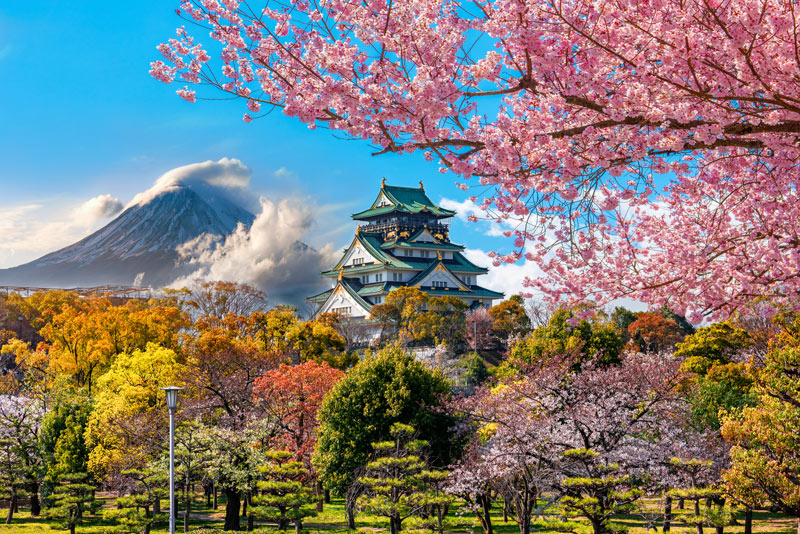
For foodies, there’s nothing quite as exciting as Dotonbori Street during the evening hours. The street comes alive with every kind of Japanese specialty street food, like okonomiyaki and takoyaki.
A great way to see a lot of Osaka during the day is on an Osaka Walking Tour . You’ll see Dotonbori during the day, visit the Hozenji temple, ride the subway, sample a local specialty, Kushikatsu, and explore traditional Shinsekai.
On your own, you can visit Osaka Castle, and check out the Instant Ramen Museum. If you have time, visit the food-focused Kuromon Ichiba Market and shop for a Japanese knife.
If you want to try the best izakaya food such as Okonomiyaki and Takoyaki and drink in Osaka, try this Osaka Bar Hopping Food Tour or go on a Foodie Walking Tour in Dotonbori and Shinsekai.
>> Read this post for an in-depth 2-day Osaka itinerary and here are some great day trips to take from Osaka if you have more time.
Where to Stay in Osaka
One of my favorite hotels is the Osaka Marriott Miyako Hotel . It is conveniently located for transportation, so you can easily get around to the top sights in Osaka and beyond. It’s got an insane view and really comfortable rooms. ⇒ Read reviews of the Osaka Marriott on Trip Advisor .
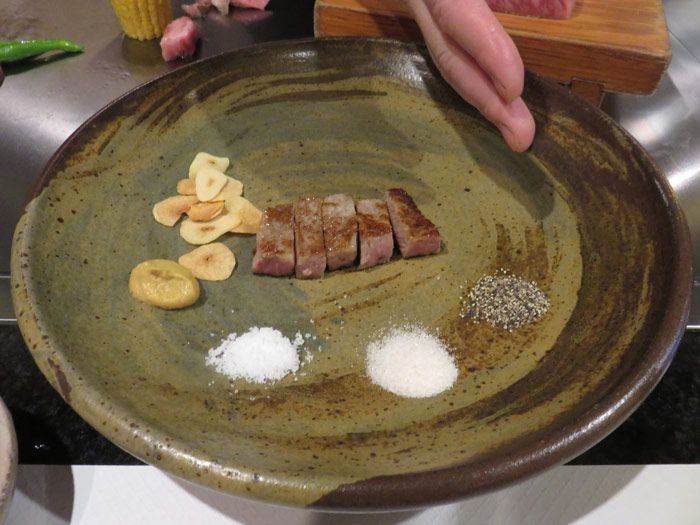
Take a 30-minute train ride to Kobe to try the famous Kobe beef. You will thank yourself for doing it – there’s nothing quite like it, and as a foodie, you owe it to yourself!
On the way back to Osaka, you can stop off in Kobe’s Nada district for a tasting and history about the making of sake at a few sake breweries . If you aren’t a sake drinker, check out the Himeji Castle, just 30 mins outside Kobe.
Stay overnight again in Osaka.
Transfer to Setouchi: Take the train from Shin-Osaka Station to Okayama Station, then the Ako line to Oku Station

The more off-the-beaten-path Setouchi region in Japan is a gem that many travelers miss in their typical itinerary, except those who make a point to visit Hiroshima (which we’ll talk about next). Setouchi has 350 islands that flank the Seto Inland Sea, so there are many hidden gems to explore.
For foodies, you don’t want to miss the oysters and the udon. With the proximity to the sea, oysters are a specialty in the area, with all-you-can-eat shacks open throughout the season.
Ritsurin Garden and Korakuen are two of the most beautiful of Japanese gardens and a must-see in Setouchi.
Hiroshima & Miyajima
Knowing that Hiroshima was effectively leveled in 1945, you will be in awe to see the city now. Hiroshima preserves the memory of the atomic bombing in the Peace Memorial Park and Museum .
Other popular sights to see in the city are the Hiroshima Castle, the city’s family shrines and temples, the Museum of Art and the Flame of Peace garden.
You can also go out to Miyajima, where the orange Great Torii Gate sits at the entrance to the Itsukushima temple, and is partially submerged in water during high tide.
If you have a Japan Rail Pass , it will cover the train and ferry between Hiroshima and Miyajima on the Japan Rail ferry.
Where to stay in Hiroshima
The Sheraton Grand Hotel in Hiroshima. The hotel is connected to Hiroshima Shinkansen station by a short, covered walkway, providing easy transportation around the city and out to Miyajima. ⇒ Read reviews on Trip Advisor .
Return to Tokyo.
Tips for planning a vacation in japan, best time to go to japan.
When you decide to go to Japan should be based on what type of experience you want to have. A lot of people make it a priority to go to Japan in the spring to see the cherry blossoms, while others wouldn’t want to be there during such a high tourist season.
If you want to catch the fireworks season in Japan, you need to go in August, but it’s really steamy and hot at that time of year. The best weather can be found from late March to May.
Another great time to visit is in autumn, when the leaves are changing, from September to November. As it can get very hot in summer in Japan, try to avoid traveling between June and August.
Getting to and Around Japan

Many top airlines have direct flights into Japan. You can check the status of flights into Japan from your home airport, to see which route and airline is best for you.
Top Japan airlines include ANA and Japan Airlines, but you can fly to Japan with most U.S. airlines that fly internationally, like United and American. Once you arrive in Japan – likely in Tokyo – you can get the train into the city center.
The best way to do it is to get on the Japan Rail (JR) Narita Express (called NEX). If you have a Japan Rail Pass , this journey is included in the pass. It goes to Tokyo Station in 60-90 minutes.
You will then likely have to change trains at Tokyo Station for the Yamanote Line, which serves most of the tourist hotels.
The best way to travel around Japan in by train. You’ll want to purchase a 14-day Japan Rail Pass . The pass allows you to travel on all JR trains throughout Japan, including the high-speed Shinkansen bullet trains. It’s the most economical and worry-free way to travel.
Travel in Japan is not cheap and the cost of buying individual tickets will far exceed the cost of the Japan Rail Pass, which you can purchase for 7, 14 or 21 consecutive days.
Just remember , you have to purchase it before entering the country and give time for it to be delivered to you. Read our guide on where to buy a Japan Rail Pass and if it’s worth it.
When planning your Japan itinerary, keep in mind the distance between each destination (for instance, the train from Tokyo to Kyoto takes 3:15). As long as there is a train linking each of your chosen cities, you’ll be able to easily travel around the country.
Traveling in Japan is not cheap, but you can save money in Japan by doing things like buying a Japan Rail Pass and eating street food.
Tipping in Japan
If you’re from the United States , Canada, or another country where tipping is customary, you should be aware that tipping in Japan is not customary.
If you do try to tip, in a restaurant or a hotel for instance, it might even be refused or considered rude. To avoid awkwardness, follow the Japanese custom and do not tip.
Eating in Japan

Japan is a country with a lot of unique foods. You will have the best overall experience if you’re willing to try the food and have an open mind that you mind really like something you’ve never tried before.
Aside from the expected and incredible sushi you’ll find all over the country, there are many specialties you should try. Some of our favorites are okonomiyaki (found mostly in Osaka), takoyaki (also from Osaka), yakitori, gyoza , and Kobe beef (only in Kobe).
You might also want to try kaiseki cuisine in Kyoto, a traditional, yet very modern preparation. Many of the top kaiseki restaurants have been awarded Michelin stars, too!
⇒ Learn the proper way to eat sushi in Japan.
Whether you take a guided tour or do this Japan 2 week itinerary on your own, I am certain it will be one of the most exciting and rewarding trips you’ll ever take. It is a fascinating country full of surprises.
Let us know how your trip to Japan turns out!
Like this post? Why not save it to Pinterest? FOLLOW US on Pinterest , Instagram , Facebook for more great travel inspiration and tips.

Laura Lynch, creator and writer of Savored Journeys, is an avid world traveler, certified wine expert, and international food specialist. She has written about travel and food for over 20 years and has visited over 75 countries. Her work has been published in numerous guidebooks, websites, and magazines.
29 thoughts on “ The Perfect Japan 2 Week Itinerary: 10-14 Days in Japan ”
Hello Nick! Your vacation in Japan is very interesting and very enjoyable. Moreover, you enjoy this holiday with the people closest to you. Thank you for sharing your experience and knowledge.
Hello! I know you wrote that summer isn’t a very ideal time to visit Japan, but my plans don’t allow me to go at any other time unfortunately. Would the beginning of July really be that bad?
Of course it’s still a great time to go as long as you don’t mind the sometimes intense heat and humidity.
Hi, we are in our 60’s so not as energetic as some! We are planning a 2 week trip to Japan in April. We arrive in Narita and initial thoughts are to stay somewhere close to airport on first night to help with jet lag and then head out to Kyoto/Nara for 3 nights, followed by Fuji five lakes for 3 nights. We want to end our stay with 3 nights in Tokyo, where would you suggest we go between our Fuji stay and return to Tokyo?
Hi Louise, I would suggest adding another day to Kyoto for a day trip to Osaka. It’s very much worth it. Then how about adding in Hakone and/or Kamakura before heading back to Tokyo.
Hi, We are a family that loves hiking, biking and outdoor activities in general. Can you suggest some places for us to visit? It’s our first time in Japan and we are staying 14 days. Thanks and I really like your website; it’s easy to understand and full of good information.
Hi Anne. I’m sure you’d love the area around Mt Fuji. There are numerous opportunities for hiking, biking and outdoor activities. Check out our post on day trips from Tokyo for more information.
Interested in a two week tour but we want to go see the snow monkeys north oh Nagano. Is there another spot to see them. We want to go in oct. and we are aware no snow then. Two couples to start tour around 10/12.
Ruth, you can visit the snow monkey park year round. There won’t be snow, but the monkeys are still there!
Hi Laura, I’m from Australia/NZ and want to say THANKS for your itineraries! I was a but lost. My hubby and I & two boys (12 & 14) are trying to plan a late January Japan trip but the boys (ie all but me :-D) want to add in a 3day snow holiday which I’m happy to do, as long as we get to at least do your 7 day itinerary! Can you please help me by suggesting an addition to your fantastic 7day itinerary that would get them their chance to try ski/boarding. Also maybe a spot that has other snow fun and a spa for me?
Hi Andrea. Glad you found the itinerary helpful! If you’re doing the 7-day trip, I would recommend a ski resort near Mt. Fuji. There’s Snowtown Yeti and Fujimi Panorama Resort nearby that are fantastic for International visitors. There are many hot springs and tons of other things to do nearby. Plus amazing views.
Thanks!! So if we add in 3 days at Hakone/Mt Fuji that would work? 10 days total. So excited! Thanks for your help.
Absolutely. And it won’t require additional travel time. Have a great time. Come back and let us know how it was!
Hello Savoredjourneys Team,
I hope you are doing well. I’ve been following your post on “Savoredjourneys.com”, for quite some time now. Every time I read a post, I feel like I’m able to take a single, clear lesson away from it, which is why I think it’s so great. I, Kousik author at “Value Walk”. Working all around the globe. We are always looking for many resources for our business development.
Our goal is an only satisfied client. I saw your post on “Savoredjourneys”, It looks good. So I contact you for this purpose if you want to work for our company. When we can always increase when we grow:)
Looking forward to working with you.
Warm Regards! Kousik
Oh, this itinerary is everything I was looking for. Thanks for coming up with this comprehensive itinerary.
Regards Anshul www.dailypassengerr.com
So I am planning a trip to go to Japan with my coworker and friend. Basically we want to go when there when is less tourists is that possible? We are planning to stay for two weeks as well. Also really good itinerary it is very helpful.
Paul – the main tourist spots will always be very busy, but those are likely the places you’ll want to see. I suggest following our 2 week plan and adjusting it to fit your interests. You can get off the beaten path in those places sometimes.
Hi Laura, thanks for the great guide! there’s just one thing that consearns me about this. How did you go all around with all the luggages? Since most hotels only check in at 12pm, that leaves you touristing with a lot of backpacks and luggages. If we stop to shop, that would just go heavier and heavier to go from place to place. How did you solved this? Thanks
Hi Thiago. Even if you can’t check into the hotel before afternoon, you can always check your bags with the hotel and go out exploring. We tend to pack really light so we don’t have a lot of luggage to trek around. It gets old when you’re on the train. I suggest taking a single piece of luggage, if possible.
Hi there! My trip is in October and we wanted buy the JR pass. I’m wondering if the JR pass will get us to all of these locations without purchasing extra train tickets? I woukd greatly appreciate hearing from you.
Hi Jouberte. All of the places in the itinerary are covered by the JR Pass. You would only need to purchase extra tickets if you want to take a train that isn’t a JR train, but there is a way to get to each place using JR trains.
Hi! We are heading to Japan in April 2020. We arrive in Tokyo on the 3rd and leave on the 7th. We are scheduled to be in Okinawa on the 10th to the 15th. We are trying to figure out the “best” place to visit in those 3 days (the 7th to the 10th), and need to keep in mind we need to fly into Okinawa in the 10th. Where do you recommend? We want somewhere either countryside or mountain town, but my wife seems to think Nagano is too “winter focused” so we’re looking elsewhere. We want traditional Japanese culture, a peaceful, country-like setting, and of course, great food and sites! Thanks!!
Hi. Read through your travel guide and would be trying out with my Mum. Would like your advise on how is it like to travel with luggage on train and buses as we would be planning to visit the Hakone for the hot springs. Also on day 7 it says that you in Nara. Did you spend the night there or in Osaka?
Gabriel, The trains and buses are usually packed full. While it’s absolutely possible to travel with luggage, I would advise taking the smallest form or luggage you can. We prefer backpacks, but you can get away with wheeled luggage. The biggest issue is just getting through the crowd easily, so suitcases with spinner wheels are the best option. When going to Nara, we always stay overnight in Osaka or Kyoto. It’s easy to get back and forth.
I am planning on going to Japan for 2 weeks in october this year, I really want to visit rabbit island (Ōkunoshima) but am unsure how to fit this in as it is not included on any online itinerarys I have seen – what would you suggest? Thank you!
Rachelle, it’s fairly easy to get there from Hiroshima, so I’d tack it on as an extra day in that area. You have to skip something else to fit it in, probably Kobe. If you go there directly from Osaka, then on to Hiroshima, it’ll fit right in.
Thank you!!
We are coming this December and have 16 nights between 12/18 – 1/3. Would your two week plan work at that time of year with maybe more time in Tokyo and a few modifications since no way to know the weather. We are from Colorado and our son is doing 1st semester of his Senior Year in College there in Osaka so a truly Once in a Lifetime Christmas Family Vacation! Thank you soo much!
Yes, I think you could do all of our itinerary in the winter time, though maybe not some of the things around Fuji. It’s always great to have more time in Tokyo, I think. Enjoy your trip!
Leave a Reply Cancel reply
Your email address will not be published. Required fields are marked *
Save my name, email, and website in this browser for the next time I comment.
- Travel Resources
How to plan a trip to Japan for 12 days
If you’ve never been to Japan before, it can be quite overwhelming! The country is such a foreign culture to most of us and there are so many beautiful places to see. In addition to this, communication may be a problem, especially if you’re using public modes of transportation. If you’re wondering how to plan a trip to Japan for 12 days , you’re in the right place!
How to plan a trip to Japan
Getting to japan.
If you’re flying in from Dubai, I highly recommend you look into booking flights more than 3 months ahead of time. The reason is, tickets are eyewateringly expensive. If you can, fly into India or any other Asian country and then buy a ticket from there. Air Asia has amazing flight deals.
Getting around Japan
The best way to get around in Japan in an efficient manner is by train or metro. The shinkansen trains are great for intercity travel, and while transportation is quite expensive, there’s a lot to gain by procuring a Japan Rail pass which allows you for unlimited rides. It can also be used on some metro lines in Tokyo and Osaka. You can also purchase a tourist metro pass in Tokyo from major stations in Shinjuku & Shibuya, but make sure you have your passport on you as they need to verify you are a tourist.
Japan Rail Pass
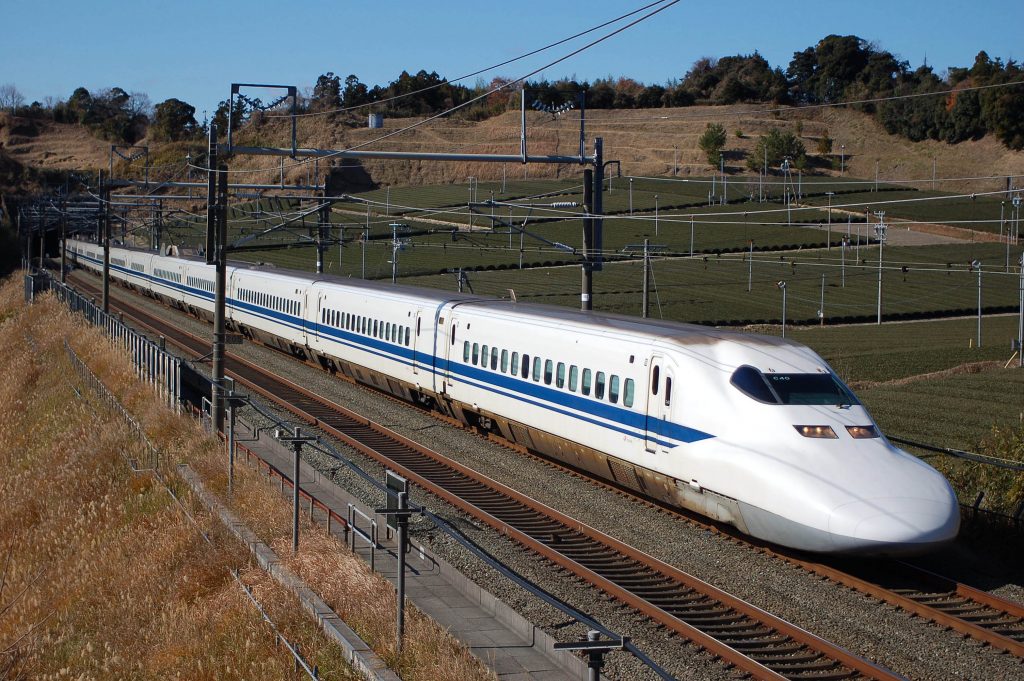
Your Japan trip will truly be easier with a Japan Rail Pass. You don’t need to reserve a seat in advance, which is truly helpful, especially if you don’t particularly want to plan out your itinerary. If you’re there for a longer time than the duration of the pass, I highly recommend you activate the pass before going on the first city you are shifting to. We were there for 16 days in total and only activated it on the day we were leaving from Tokyo to Kyoto. Please note that you will need to buy your Japan Rail Pass in advance and have it delivered to wherever you are. You can purchase one in the country, but it is more expensive. Once you get to Japan, remember to activate your pass for the date of anticipated travel. You will need to flash this pass every time you move from gate to gate. You can purchase a pass here .
Hands-free luggage service & luggage storage
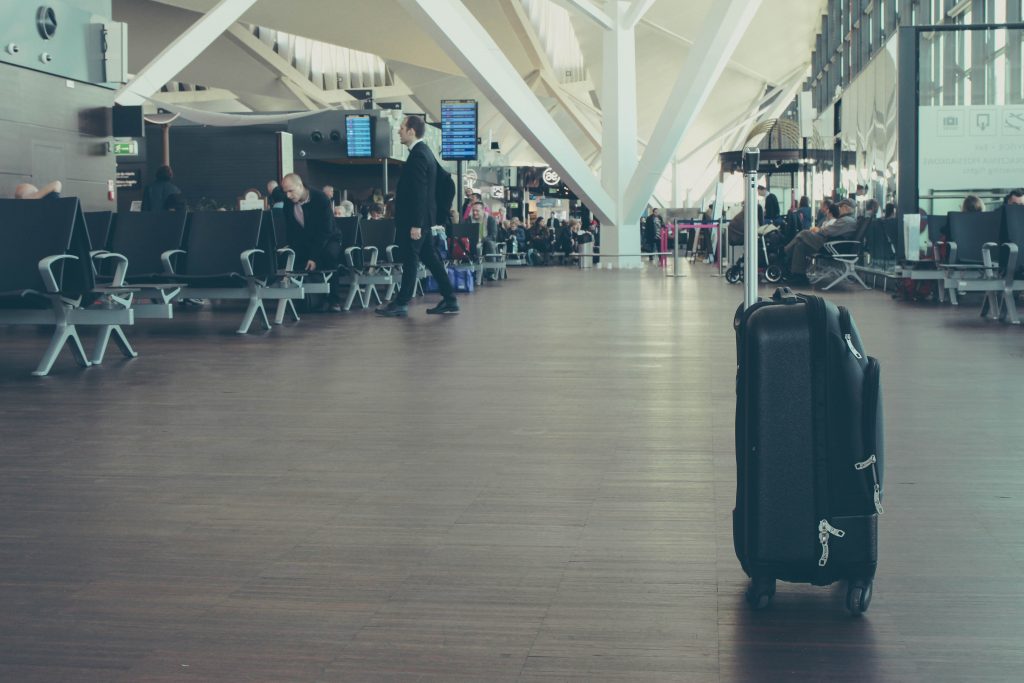
This was a huge boon for us when it came to travelling within Japan from city to city. All major stations and most hotels have the ability to send your baggage to your next hotel, which means you don’t have to be lugging your bags the whole way. In most cases, you are able to store your luggage, but since we are not light packers, it saved us a lot of time not dragging our bags everywhere as well as jumping straight to sightseeing from one place to another. In a lot of cases of day trips, you have the ability to use the storage lockers across several stations with coin-operated lockers.
Tax-free shopping
If you purchase anything retail above 5,000 yen, you’re eligible for a tax rebate on production of your passport and visa. So shop away!
If you’re looking for a good place to buy souvenirs, I’d pick Don Quijote any day. It has everything you’d like to bring for family and friends back home, from Japanese snacks to video games. I’d exercise some caution buying souvenirs from local markets as they can be overpriced.
Japan 12-day itinerary
Day 1 to day 5 – tokyo & kamakura day trip.
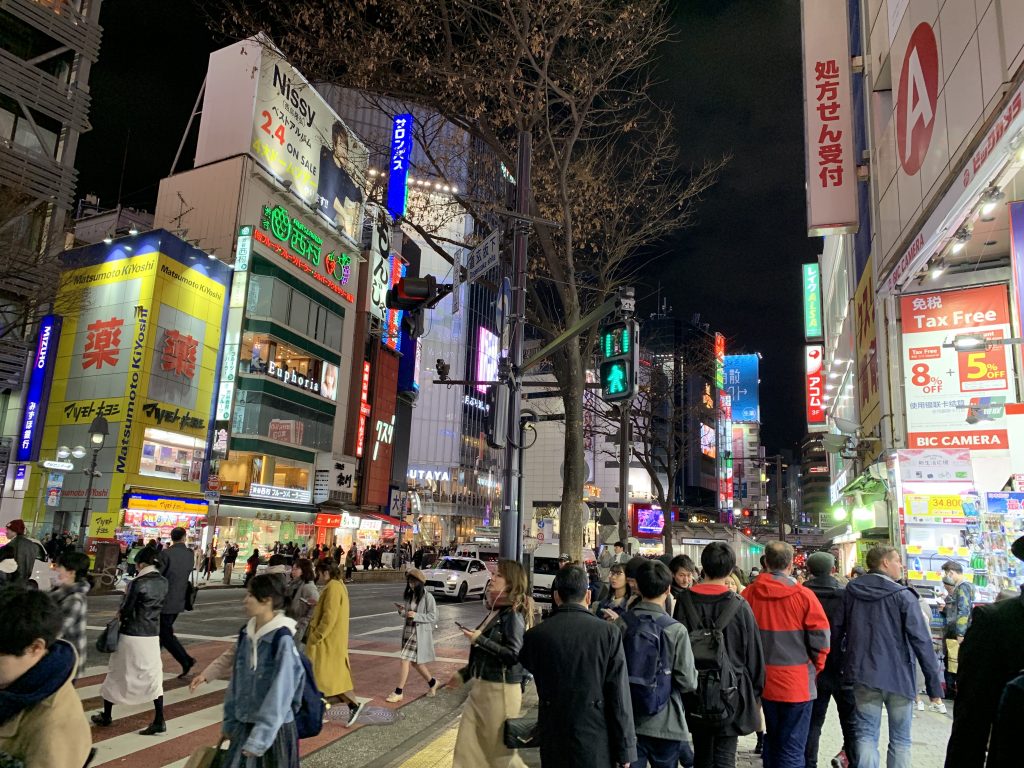
Usually, on the first day, most people end up in Tokyo. Check out my Tokyo guide for more, on covering the best spots in Tokyo for sightseeing, shopping and more. I’ve also collated a Tokyo food guide because quite simply, there’s so much to explore in terms of gastronomy in the city. I’ve also added a short day trip guide to Kamakura , so check that out as well.
Day 6 to Day 8 – Kyoto & Nara day trip
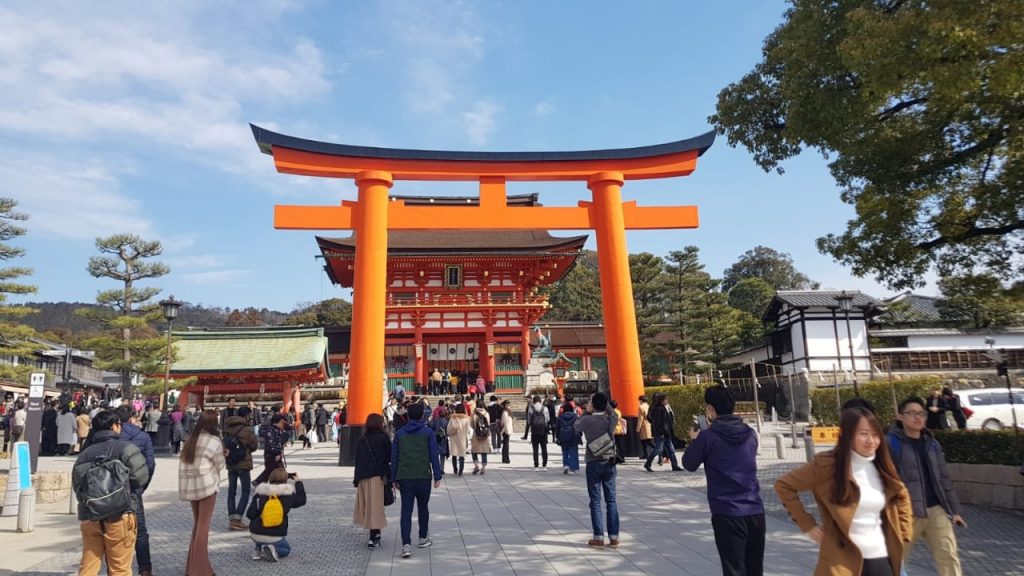
I recommend then taking the shinkansen to Kyoto , which is nothing short of charming. Here’s my Kyoto itinerary and Nara day trip itinerary. Nara can be accessed from either Kyoto or Osaka quite easily.
Day 9 to Day 10 – Osaka
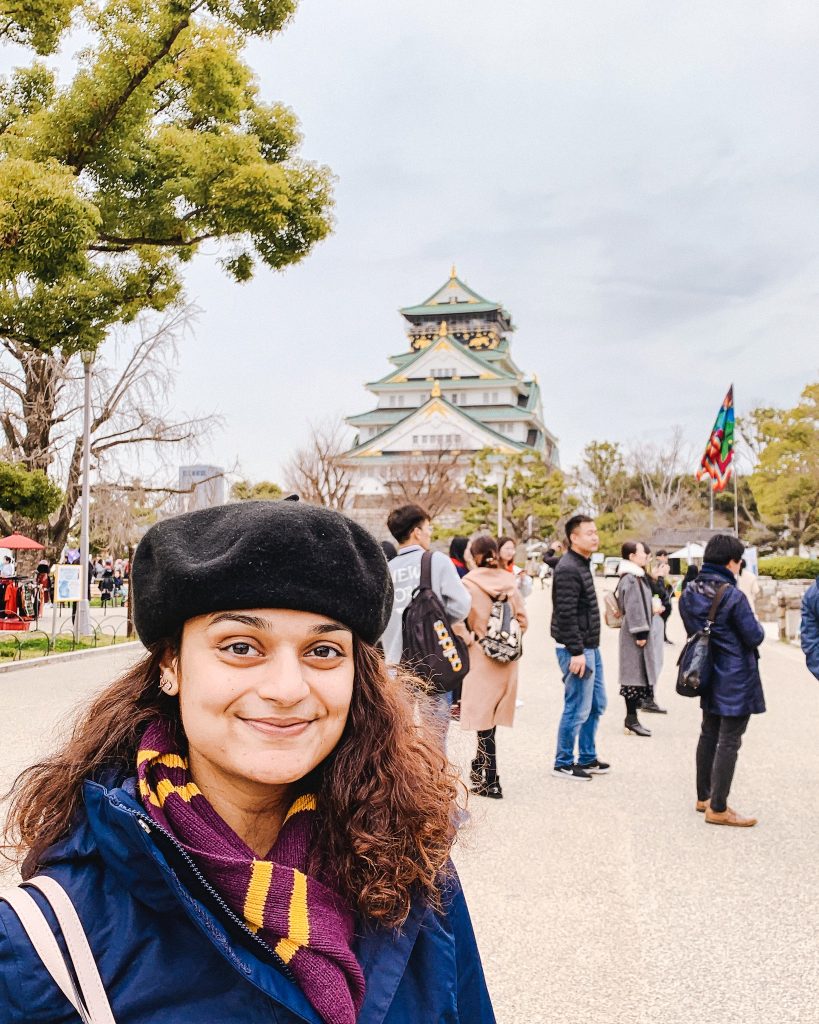
Osaka would be incomplete without a visit to Universal Studios, but I have a few tips on my Osaka itinerary here of alternatives if you’re not too keen on visiting.
Day 11 to Day 12 – Hakone, Mt. Fuji & surrounding areas
To round up your trip before heading back to Tokyo to take your flight out of there (sob), take some time for some R&R at Hakone , complete with onsen and kaiseki style meals.
I hope you enjoyed my tips on how to plan a trip to Japan! Let me know if you have any doubts on the comment section below.
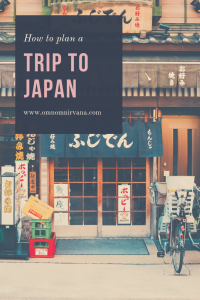
Japan is amazing! I’ve only seen Tokyo and can’t wait to explore more. Hopefully I can put this itinerary to good use soon!
Sounds fantastic How can i book a group tour from Bangkok
I’m not sure how to do that, we planned our trip on our own! I’m sure there are many travel companies out there to arrange tours from Bangkok.
I’ve been to Japan before and I loved it! I haven’t travelled overseas since pre-covid so reading this is making me want to go travelling again soon!
Leave a Reply Cancel reply
Your email address will not be published. Required fields are marked *
This site uses Akismet to reduce spam. Learn how your comment data is processed .
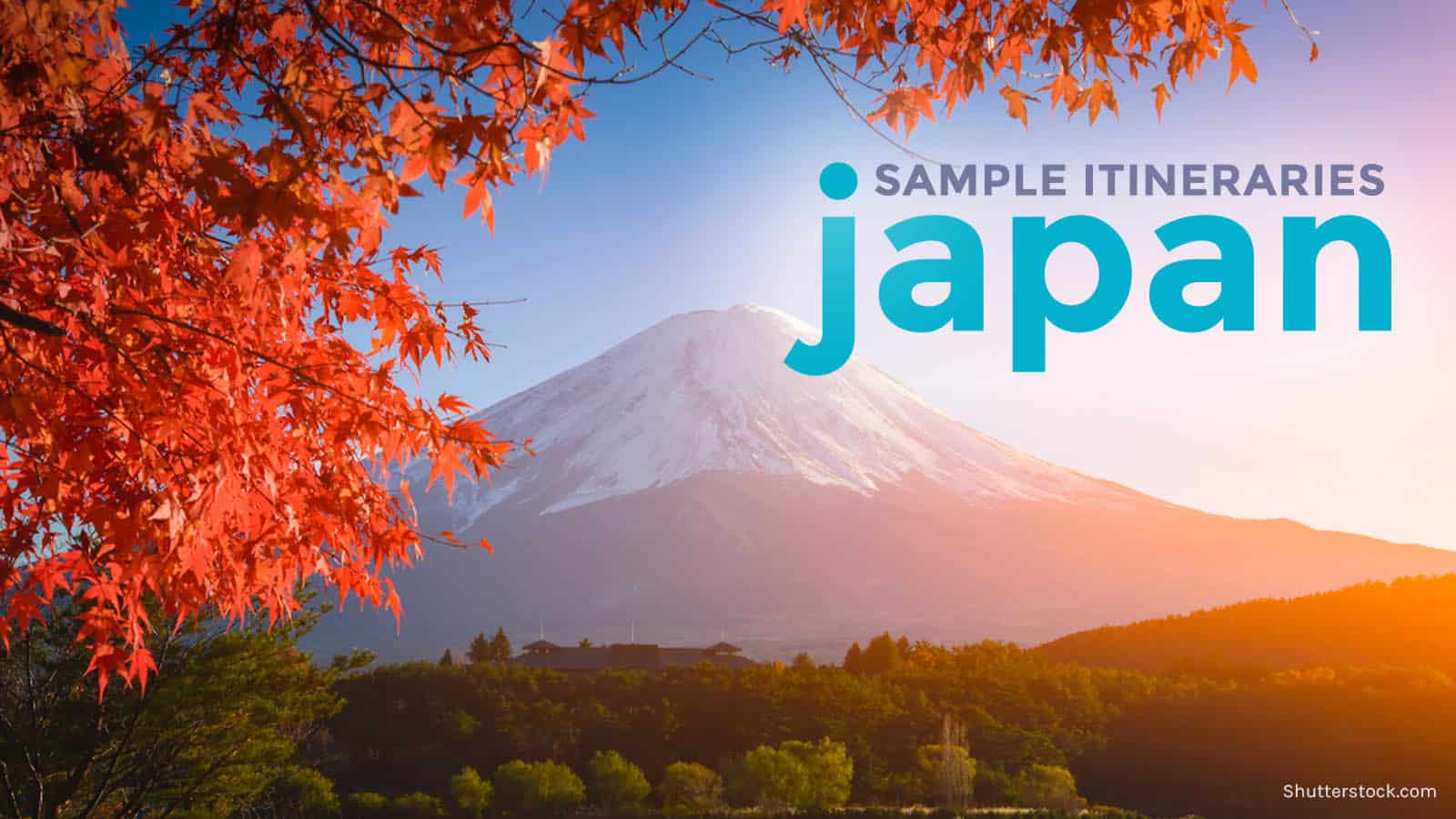
Sample JAPAN ITINERARIES with Estimated Budget: 4, 6, 7, 8, 15 Days

Here are some sample DIY Japan itineraries for Tokyo, Osaka, and Kyoto for 4 DAYS, 6 DAYS, 7 DAYS (1 WEEK), 8 DAYS, and 15 DAYS. Each DIY itinerary has its own recommended minimum budget to help you manage your finances well.
This post covers only Tokyo, Osaka, and Kyoto. If you’re looking for sample itineraries for Sapporo and Nagoya, we have separate samples in the posts below:
- Nagoya Sample Itinerary
- Sapporo Sample Itinerary
If you need help on how to start planning a multi-city tour across Japan, this post might help: Japan Travel Guide
Please take note of the following.
- All the itineraries below assume that you are a party of two , that you will be staying at a double room of a budget hotel or hostel (less than $80 per night), and that you will be splitting costs. The only exception is Tokyo Option 3 and the 15-day backpacking itinerary.
- If your hostel or hotel does not serve free breakfast, visit the supermarket on your first day to buy food (biscuits, drinks, bread).
- Set aside ¥1000 for every unspecified lunch or dinner .
- Airfare is not included in the costing.
- Estimated budget indicated is per person. However, note that this has a big allowance. For example, the ¥1000 budget per meal is often too much because you can actually find a good bowl of ramen, even in Tokyo, for only ¥500. But it’s better to overestimate than under.
WHAT'S COVERED IN THIS GUIDE?
Tokyo Budget Itinerary: 6 Days
Duration : 6 Days, 5 Nights Estimated Budget : ¥35,000 (USD315, PHP15,600)
The BUDGET OPTION. This itinerary replaces the pricey Disneyland visit with a day trip in Odaiba and replaces double room with a bed at a capsule hotel.
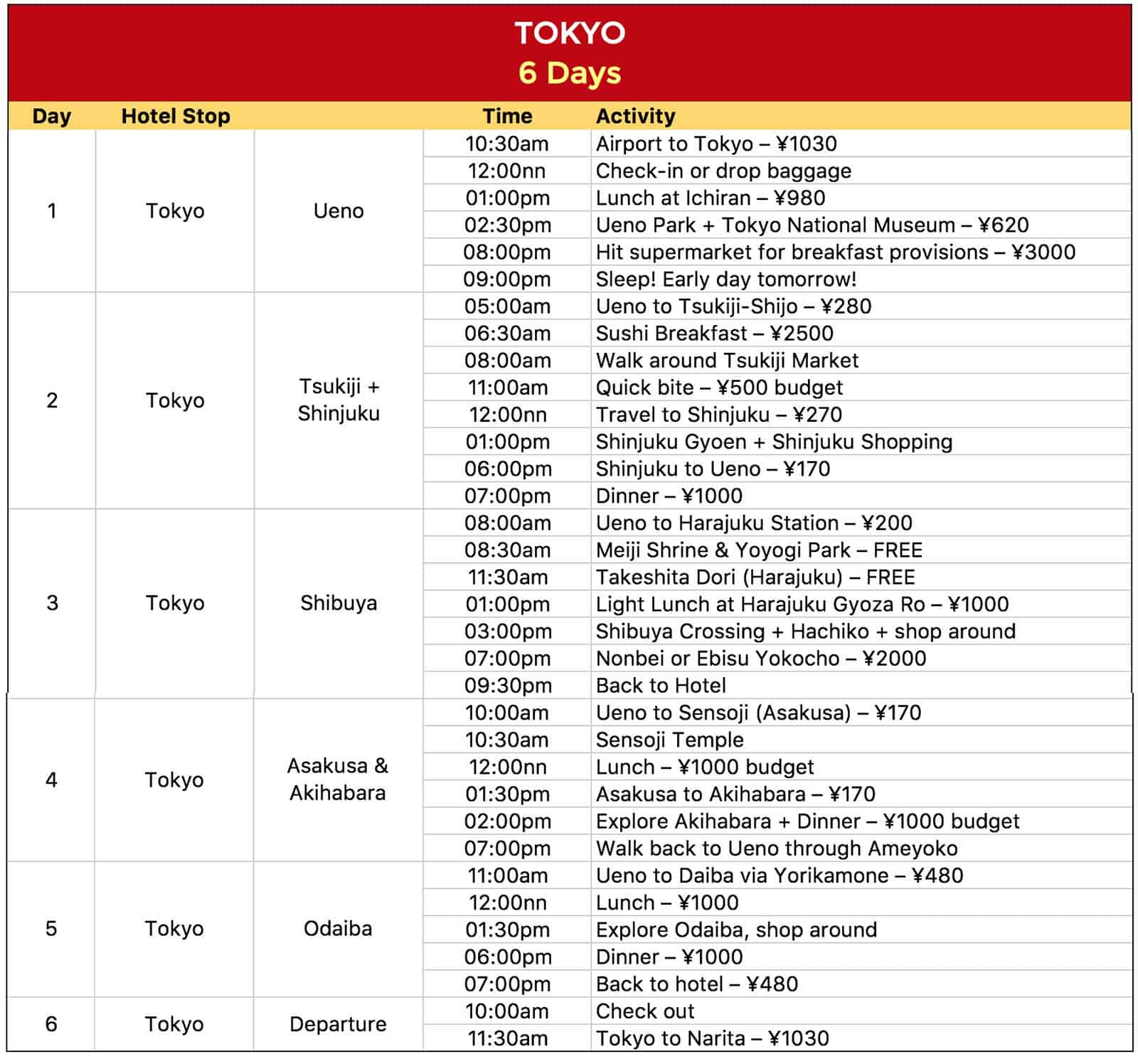
Tokyo + Disneyland Itinerary: 6 Days
Duration : 6 Days, 5 Nights Estimated Budget : ¥53,000 (USD475, PHP23,700)
This itinerary removes the visit to Kamakura and Yokohama and adds a visit to Sensoji Temple.
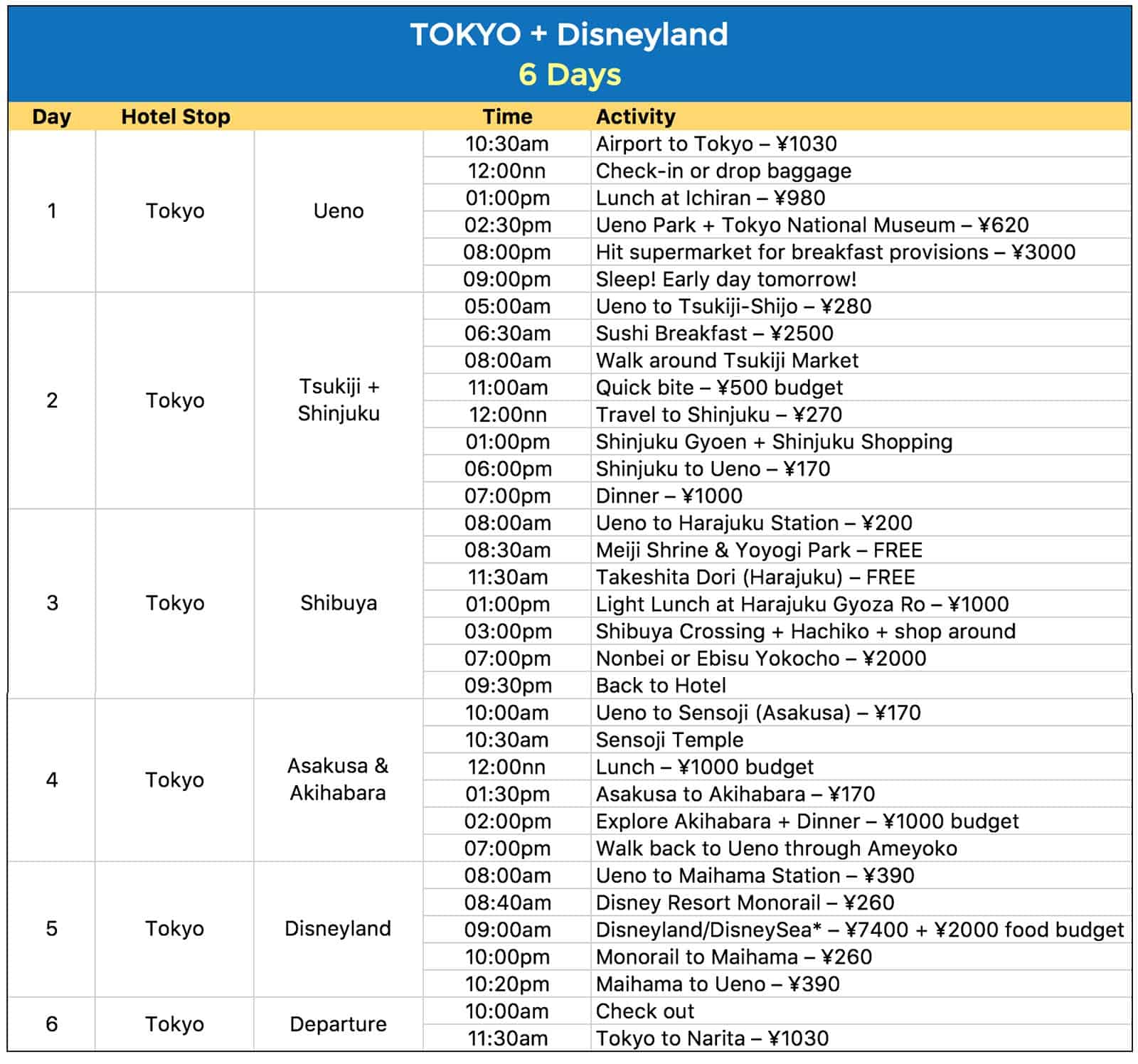
Tokyo + Disneyland + Kamakura and Yokohama Itinerary: 6 Days
Duration : 6 Days, 5 Nights Estimated Budget : ¥56,000 (USD500, PHP25,000)
This is a pretty jampacked itinerary.
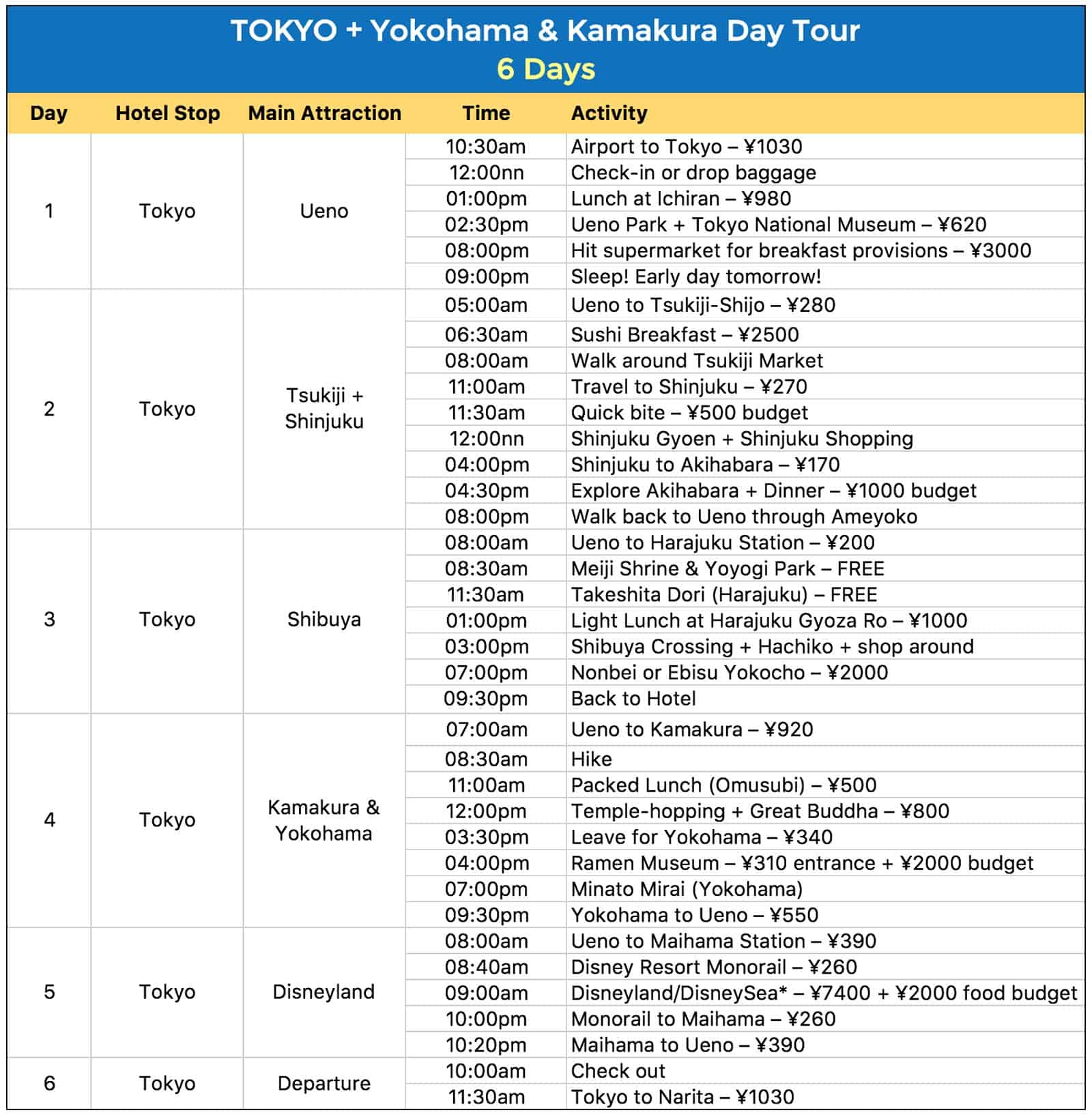
If you need more information about traveling on a budget in Tokyo, check this out: Tokyo Travel Guide
Osaka and Kyoto Itinerary: 4 Days
Duration : 4 Days, 4 Nights Estimated Budget : ¥38,000 (USD340, PHP17,000)
This itinerary assumes you will be landing at Kansai International Airport at night and will be staying in a double room at a budget hotel or hostel for ¥6000/night (¥3000/head).
If you need more help planning your Osaka-Kyoto trip, this post is for you: Osaka and Kyoto Travel Guide
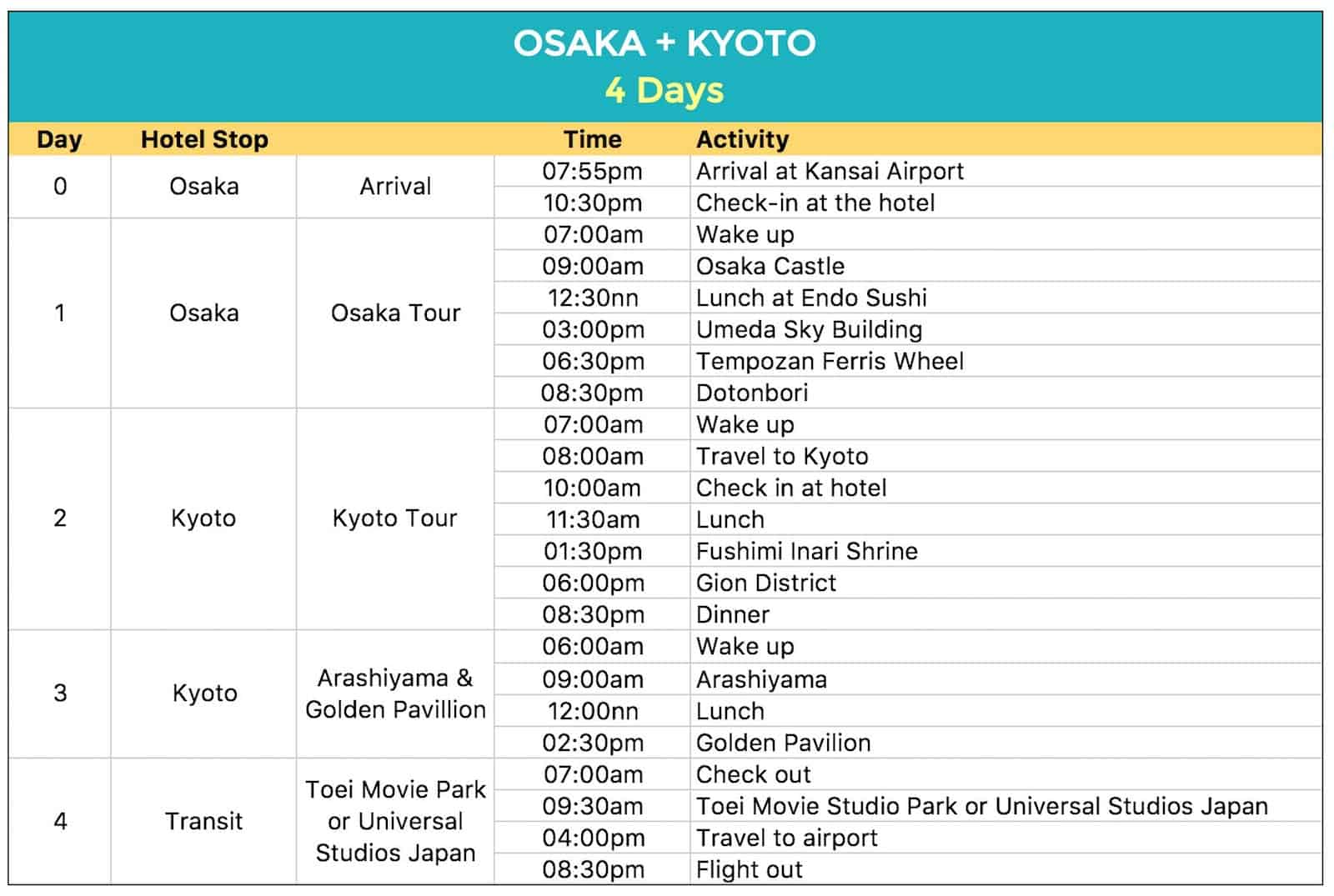
Osaka – Nara – Kyoto Itinerary: 4 Days
Duration : 4 Days, 4 Nights Estimated Budget : ¥45,000 (USD400, PHP20,000)
This itinerary assumes you will be landing at Kansai International Airport at night and will be staying in a double room at a budget hotel or hostel for ¥6000/night (¥3000/head). You will be visiting Nara but only on a day tour.
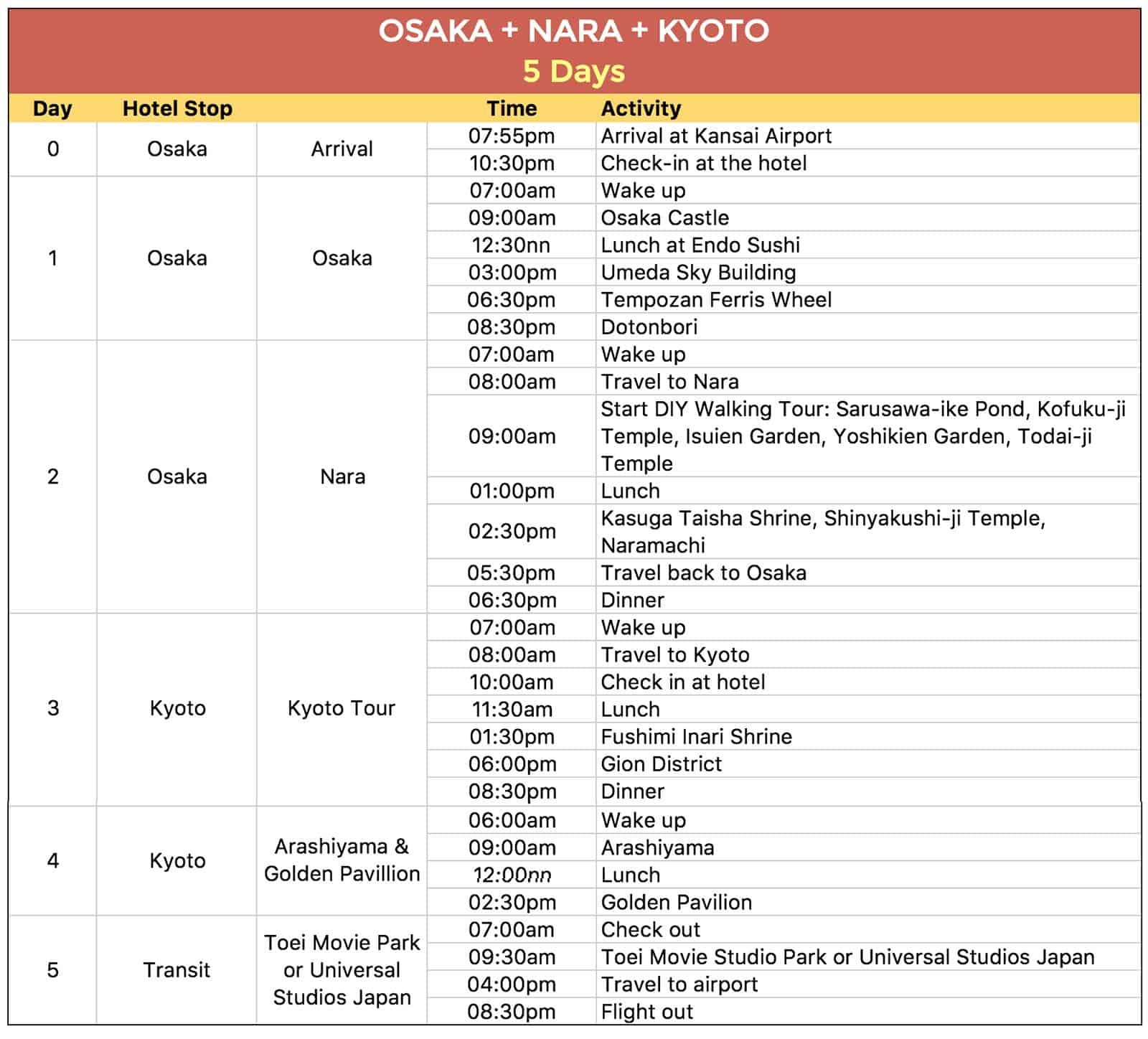
Osaka – Kyoto – Tokyo Itinerary: 8 Days
Duration : 8 Days, 8 nights Estimated Budget : ¥85,000 (USD760, PHP38,000)
This itinerary assumes you will be entering Japan via Osaka and leaving via Tokyo. You will also be staying in a double room at a budget hotel or hostel for ¥6000/night (¥3000/head) in Osaka/Kyoto and ¥9400/night (¥4700/head) in Tokyo.
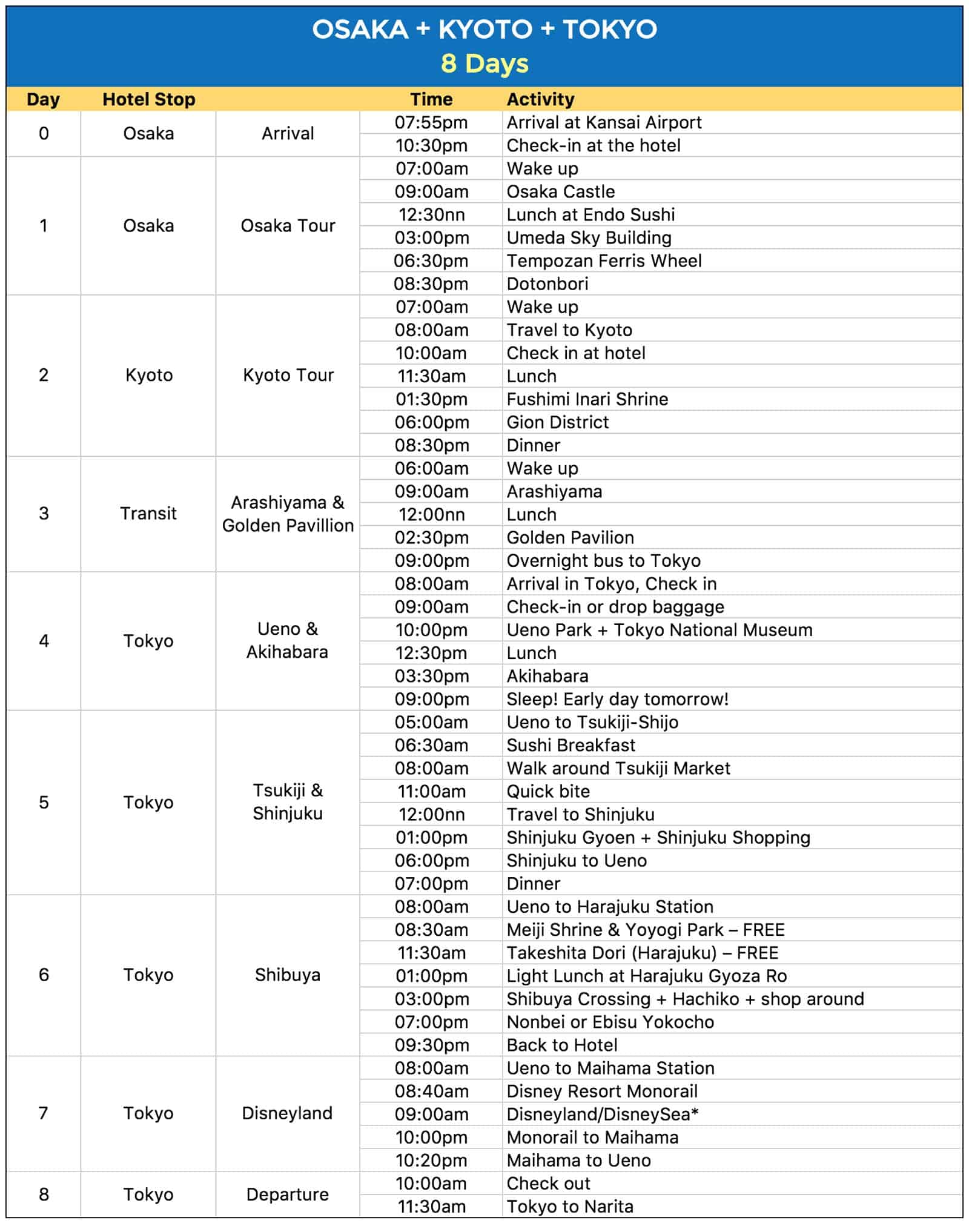
Tokyo – Kyoto – Osaka Itinerary: 7 Days
Duration : 7 Days, 6 nights Estimated Budget : ¥85,000 (USD760, PHP38,000)
This is the reverse of the Osaka-Tokyo itinerary above. This one assumes you’re landing in Tokyo and leaving via Osaka. Your hotel budget here is the same: ¥6000/night (¥3000/head) in Osaka/Kyoto and ¥9400/night (¥4700/head) in Tokyo.
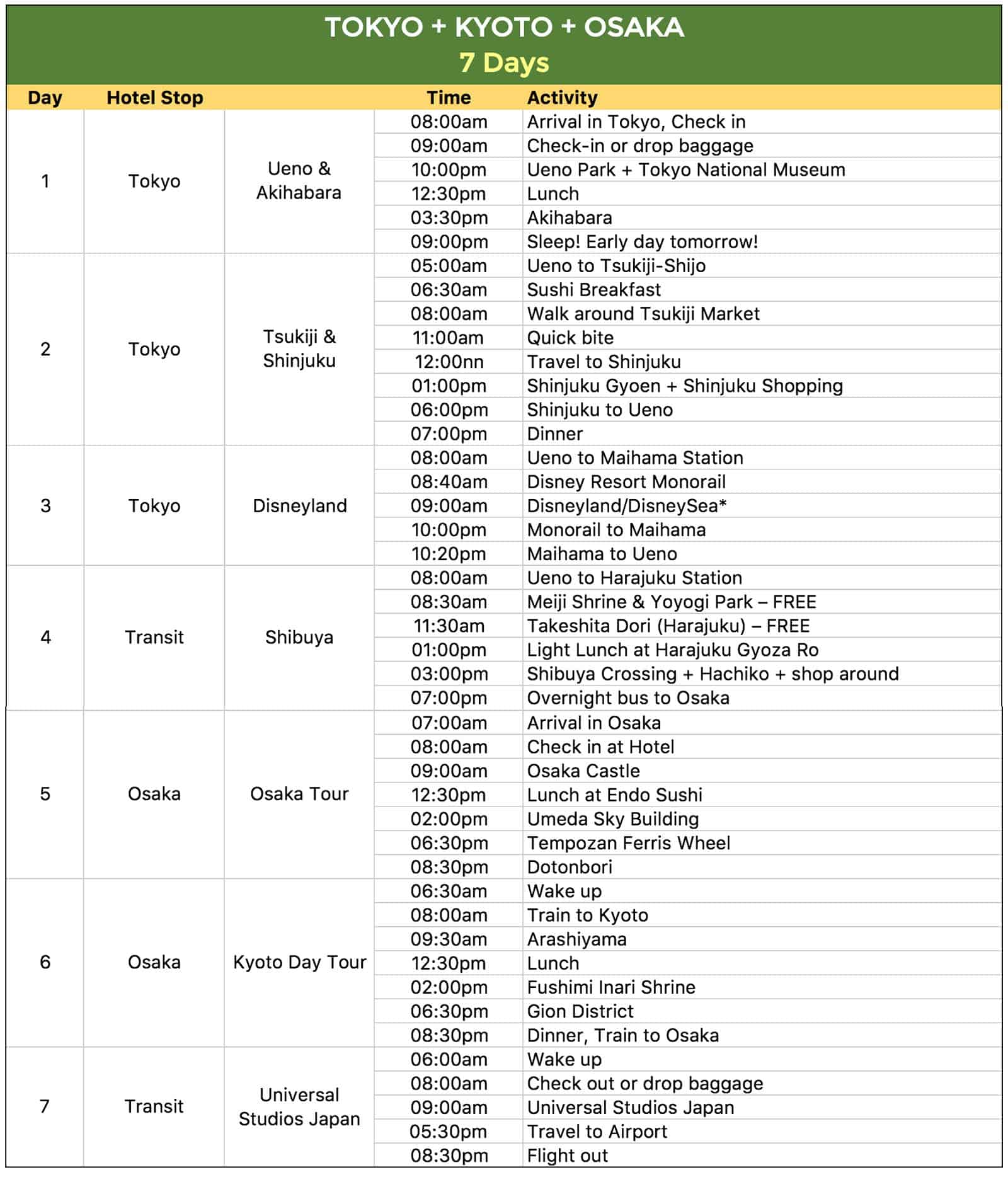
Tokyo – Nagoya – Kyoto – Osaka Itinerary: 15 Days
15-Day Budget Backpacking Duration : 15 Days, 14 nights Estimated Budget : ¥115,000 (USD1030, PHP51,200)
This one is for budget backpackers. This assumes you’ll be staying at hostel dorm (around ¥2000 per night). Because you will be visiting multiple cities including day tours in Ibaraki and Kawaguchiko, it would be great if you have a JR Pass.
Do you really need a JR Pass?
It depends on your chosen itinerary. In this post, we weighed in on the JR Pass. You might want to read it first before making a decision: For more info, read: Is the JR Pass Worth It?
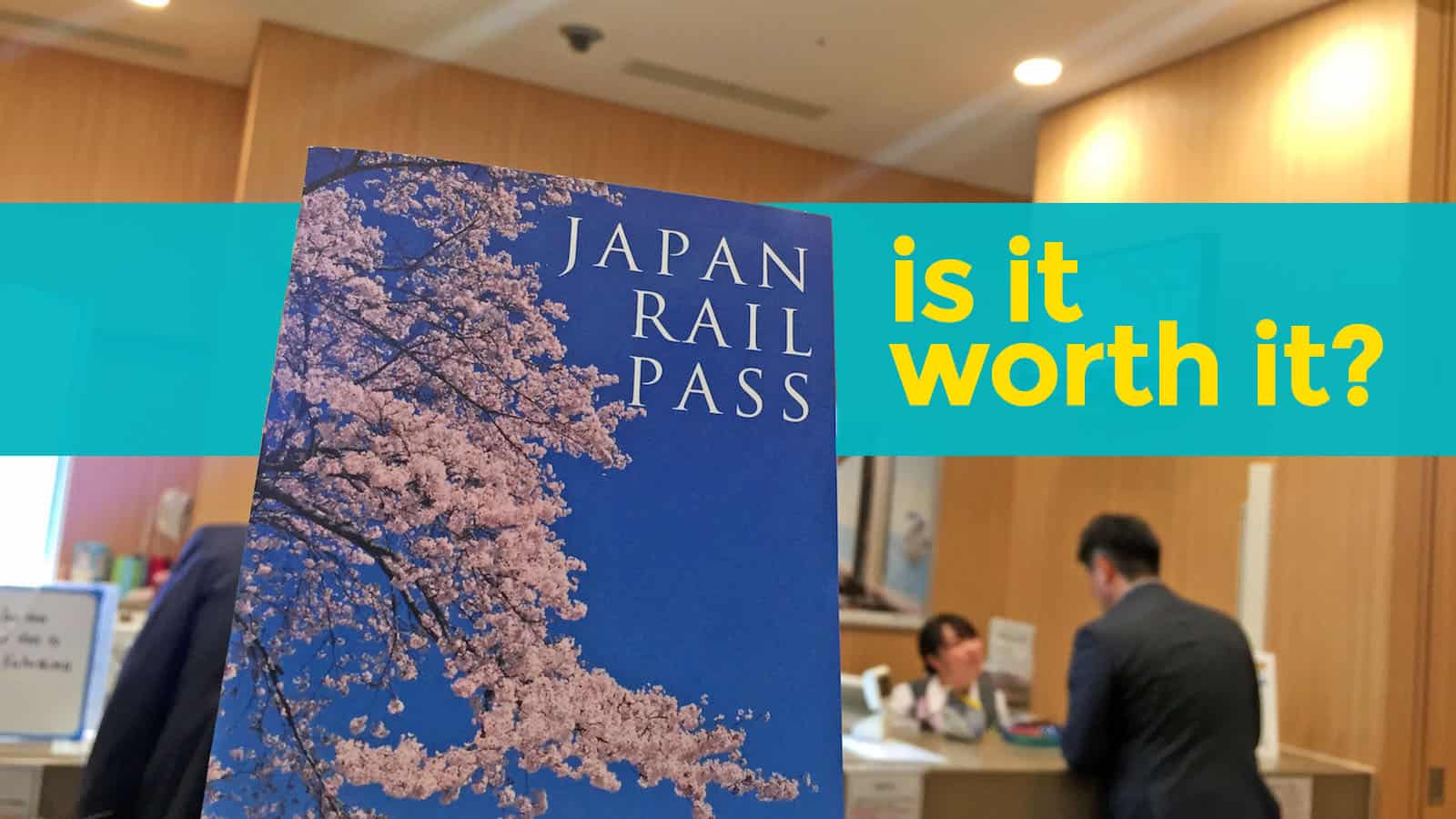
Top Budget Hotels in Tokyo
According to TripAdvisor users as of Feb 2017.
Search for more: Tokyo Hotels
Top budget hotels and hostels in osaka (under $70), search for more: osaka hotels, top guest houses in kyoto (under $70), search for more: kyoto hotels.

2️⃣0️⃣1️⃣9️⃣ • 3️⃣ • 2️⃣4️⃣ (updated) 2️⃣0️⃣1️⃣7️⃣ • 5️⃣ • 2️⃣5️⃣ (first up)
More Tips on YouTube ⬇️⬇️⬇️
Is this post helpful to you?

Related Posts:
- 10 Photos of Cherry Blossoms in Japan
- JAPAN MULTI-CITY TOUR: How to Plan a Budget Trip
- Sample OSAKA-KYOTO-NARA-KOBE DIY Itinerary: 4, 5, 6 Days
- Sample OSAKA- KYOTO ITINERARY with Budget Estimates: 1-6 Days
- 8 FREE or Cheap Things to Do in KYOTO and OSAKA
- Sample TOKYO ITINERARIES with Estimated Budget: 1-8 Days
- KOBE DAY TOUR FROM OSAKA: A DIY Itinerary
- KYOTO DAY TOUR FROM OSAKA: A DIY ITINERARY

- Recent Posts
- FLIGHT RESERVATION for VISA • How to Get Dummy Ticket for Schengen, Canada, China and Other Visa Applications - 22 March 2024
- 2024 Cebu Pacific Promos & PISO SALE with List of Covered Destinations - 4 March 2024
- Top 13 FREE Attractions to Enjoy in MACAU - 19 February 2024
I probably visit your japan articles for so many times as I am traveling to Japan next month (solo trip). I am pretty anxious about how much it would cost me. Can I ask for advice if it’s better to get JR pass TOkyo-kyoto-osaka-tokyo is my itinerary.i wanted midnight bus but just wondering if it would cost the same if I have JR pass? Thanks! More power!
Hi Weywey, overnight bus is a looot cheaper than JR Pass. If you can handle an 8-hour bus ride overnight, go for it.
Here’s our article about JR Pass: http://www.thepoortraveler.net/2017/03/is-jr-pass-worth-it/
Hi. This post is so helpful. I’m planning for a 8d/7n trip to Osaka-Kyoto-Tokyo-Osaka, solo traveler btw. :)
Day 1 – Arrival Day 2 – USJ + Dotonbori Day 3 – Arashiyama / Fushimi Inari / Gion Day 4 – Tokyo = Meiji Shrine / Shibuya + Hachiko / Takeshita / Sanrio Puroland Day 5 – Disneyland Day 6 – Ueno Park / Tokyo Museum / Akihabara / Return to Osaka Day 7 – Osaka Castle / Umeda Sky Bldg / Back to MNL
If ever I get JR pass, do you think it will cost me the same if I use midnight buses back and forth Osaka? Or it’s better if I depart na lang from Tokyo to MNL? (Mas cheaper kasi sa Osaka. Hahaha.)
Thank you so much in advance. :)
If you haven’t booked your return flight yet, I would seriously consider exiting via Tokyo so you don’t need to go back to Osaka. Yes, it might cost more but it will give you more time too. :)
From Kyoto/Osaka to Tokyo, take the overnight bus.
Hi! Would just like to ask if the budget you posted per option is on a per head basis? For example on option 7, budget is 38k pesos per person if there were 2 of us planning to take this trip?
Hi Meg, yes, that’s per person. But bear in mind that these are “overestimates.” For example, the ¥1000 budget per meal, which is used in these itineraries, is often too much because you can actually find a good bowl of ramen, even in Tokyo, for only ¥500. But it’s better to overestimate than under.
Almost 1/3 of the budget also goes to hotel accommodations. If you can find rooms cheaper than the price used in this itinerary, that would significantly bring the costs down.
Traveling Japan was one of my FAVORITE countries of all time. Kyoto was especially…well, special for lack of a creative word LOL Mindblowing might be more apt. Also, the Rail Pass was a HUGE cost saver. Great suggestion!
I’m curious if you guys can manage a budget trip like this for a ski trip, though. The snow is FANTASTIC out near Sapporo, but it was the most expensive part of my trip
Hi Lexi, oh the only time we tried skiing was at Fujiten (near Lake Kawaguchi). I think it’s a bit cheaper than other ski resorts, no entrance fee, but getting there was super expensive because if you don’t have a car (and we didn’t), the only way to get there was by taxi. And you know how costly Japan cab rides are.
Hi. We are 3 in the family going to Osaka next month for a week. Can you give us an itinerary for budget travellers? Thanks.
Hi Yoshke. Thanks for posting all these tips on Japan. I’d like to visit Hiroshima, would you mind sharing if you have been there. We would love to include it in our itinerary of osaka, kyoto amd Hiroshima. Thanks
Hi. I just want to ask for some advice. I have booked a plane ticket for Manila-Tokyo and vice versa this coming September. We plan to stay for a week but we thought that its too long if we will just stay in Tokyo. I just want to know if its practical to get a Whole Jr pass? Can we used that to go to Osaka and return to Tokyo? Hope you could help. Thank you
Hi Jenelyn, in my opinion, a week is still too short for Tokyo, there’s just a lot to do there. The surrounding destinations like Kamakura and Yokohama are also worth a visit. If you decided to stay in Tokyo, you don’t need a JR Pass.
If you really want to visit Osaka and your return flight will also be from Tokyo, the JR Pass isn’t the best option either. You can find cheap flights. Or if you’re up for it, take an overnight bus, which will also save you a hotel night.
More info here: https://www.thepoortraveler.net/2017/03/is-jr-pass-worth-it/
Hi, Your link to Sappora Itinerary Sample and Nagoya Itinerary Sample on the top of your page are swapped. Maybe you didn’t notice it.
Hi Win! Great catch! Thanks for letting us know. Fixed now!
Hi does the budget includes transportation cost in japan during the trip?
hi po, pla po namin mag punta ng japan next month. me, husband and yung son ko. manila-osaka tokyo to manila po ang plano namin. first time namin sa japan, kailangan ba namin bumili ng jr pass? hingi po sana ako ng suggestion mo, kung ilang days namin kailangan mag stay ng osaka para makalibot and sa tokyo.. 10-13 days po kami mag stay ng japan.
If Osaka and Tokyo lang ang balak nyong puntahan and no side trips to other distant cities, you don’t need a JR Pass. This post explains it: https://www.thepoortraveler.net/2017/03/is-jr-pass-worth-it/
If 10 days, I suggest 6 days in Tokyo and 4 days in Osaka+Kyoto.
If 13 days, 7 days in Tokyo and 6 days in Osaka+Kyoto.
Can you recommend a travel agencies that organise the itinerary tokyo with disneyland
We haven’t tried having a travel agency organize our Japan trip for us, so we can’t recommend anyone. :(
hi, so we are going to Japan for the first time in August. I’ve only booked 6D/5N going to Tokyo…. Reading your articles, seems that is too short, waaaah :( Anyway, so just to confirm, if we stay in TOkyo we won’t be needing the JR pass right? How will we get around the city? Also, where do you think is the best area to stay as springboard to must-go places in Tokyo? The only sure place we will visit is Tokyo Disney as well as Mt. Fuji tour. What else can you recommend? Thanks in advance!
Yep, you DON’T need a JR Pass if you’re staying in Tokyo.
My favorite base is Ueno. We explained why in our TOKYO TRAVEL GUIDE. You can find that here: https://www.thepoortraveler.net/2016/12/tokyo-travel-guide-expenses/
Super thank you again!!! I’m going crazy making the itinerary…. All your articles are very helpful!
Hi Pwede po humingi ng soft copy of Tokyo – Kyoto – Osaka Iterynary. Thanks po
Do you have a itinerary for tokyo – hakone-mt fuji- kyoto- osaka- tokyo? Thanks.
Hi ask ko lng po if single entry lng ang visa. Can we enter in tokyo and exit in osaka? Or same exit din kame dapat kung saan ang point of entry nmin? Thank you!
Hi Chi, okay lang na magkaiba ang entry and exit points kahit single entry visa. Basta wag ka lang lalabas ng Japan tapos papasok ulit. :)
Hi! I love how comprehensive yet simple your website and itineraries are! May I know though if can replace Disney Sea/Land with Fuji Q, in your 8-day Osaka-Kyoto-Tokyo itinerary? We have exactly 8 whole days for touring, that is excluding our arrival and departure days. We will travel this September na. Just got our visa. hehe
Hi Isla, yes, that’s possible. :) You can visit Fuji Q as a day trip from Tokyo. :)
hi Yoshke I will travel with my wife and two daughters age 18 and 20 to japan in march for 35 days. we will use the 21 day japan rail pass. we would like to visit Okinawa also. we fly out of Edmonton alberta Canada and will fly to okinowa first then return from Tokyo. this is our first trip to japan. could you help us with this itinery or suggest a good site for this period of time. Thank you and any help is appreciated.
Wow! 35 days! :D If I had that much time (and money), I would do it like this:
Days 1-5 Okinawa Days 5-9 Fukuoka & Nagasaki Days 9-12 Hiroshima Days 12-15 Tottori Days 15-20 Osaka & Kyoto Days 20-25 Nagoya/Gifu Days 25-29 Hokkaido Days 29-35 Tokyo
To maximize your JR Pass, use it first when you travel from Fukuoka to Hiroshima (Day 9). This will allow it to be effective until Day 29. when you travel from Hokkaido to Tokyo. This way, you have covered most long-distance trips.
Japan-Guide .com has an online forum too. Maybe you can post this on their forum. :D
Hi! I want to Travel to Tokyo, Osaka and Kyoto but I have roundtrip ticket MNL-NRT. No exact days yet since I can still rebook my flight but still with NRT. Is it okay not to get JR Pass? Or I do I need it to get back to Tokyo?
The number of days of your trip is a key factor in determining whether you need a JR Pass or not. So decide muna how long your trip is.
But yes, it’s possible to travel from Tokyo to Osaka/Kyoto and back even without JR Pass. You can take the bus.
hi Sir .. good day po . we’re planning to visit japan this november . 2 adult and 1 kid i saw your iteneray .. can you help me look for a budget hotel wre we can stay .gusto ko po sana na eto mga puntahan namin 7 days po tokyo kyota osaka wla po kase kayong hotel na nailagay. buget hotel po sna .. salamat
You may check out our individual travel guides for info and recommendations on WHERE TO STAY:
Osaka: https://www.thepoortraveler.net/2018/03/what-to-do-in-osaka/
Kyoto: https://www.thepoortraveler.net/2018/03/things-to-do-in-kyoto-itinerary/
Tokyo: https://www.thepoortraveler.net/2016/12/tokyo-travel-guide-expenses/
I have a question on the itinerary particularly on Tokyo – Kyoto – Osaka Itinerary: 7 Days. 1. What type of pass or card recommended to use on this itinerary? Is PASMO card enough to use in all the transportation needed? 2. PASMO card is accepted also in OSAKA and Kyoto train/buses?
1. When is your trip? We will be publishing better, more cost-efficient sample itineraries later this month.
2. Yes, PASMO card is accepted by any train gate or bus with an IC reader. Not all buses have IC readers though, I think.
Hi. Would a single-entry visa suffice if we fly to Osaka then fly out from Tokyo?
Hi Louise, yes, as long as you’re not flying out of Japan in between!
Hi, Me and my brother are planning to explore Japan later this month for the first time. And we’ll be spending 10 days. Our flight will be MNL-OSAKA-MNL. What mode of transportation can you recommend if we want to go to Tokyo and come back to Osaka? And what are other itineraries can you recommend? Thank you so much.
Hi Rhona, if budget traveler kayo, okay i-take ang bus. Overnight bus, pwede rin para tipid.
We’ll be creating more sample itineraries soon!
Hi, paano mo gumawa ng itinerary templates for 7 days? Any app you can recommend? Love your blog and it’s so helpful! Thank you!
Hi Girlie, we make our itineraries based on experience lang.
Hello. I want to consider your 8 days / 7 days multi city itinerary, might follow it sa planned Japan trip. One question though, would want to include in the itinerary the visit to see Mt. Fuji. What route can you recommend in between those days? Thank you!
We would like to follow the 8 days intinerary (osaka – kyoto – tokyo ) 1. Do we need to get JR pass? 2.. in your itinerary , is it DIY? If so we need to buy all the tickets in advance thru klook or at site(japan) 3. Or you have arrange tour packages in agency?
Hope you can ease my mind and help me with this.
More power to you!
1. If your entry point is Osaka and exit is Narita/Haneda, no need for JR Pass. I’m assuming you’re taking the bus to Tokyo.
2. Yep, it’s DIY.
3. It’s DIY.
Hi Yoshke Dimen,
Greetings to you from Singapore.
I am planning a family trip of 10 days to Osaka/Nara/Kobe/Nagoya/Kyoto/Osaka in mid Nov this year. My tentative itinerary is as follows. Appreciate for your input. TQVM.
Day 1 Arr at Osaka at night Day 2 Osaka city tour Day 3 Nara day tour with train from Osaka Day 4 Kobe day tour with train from Osaka Day 5 Leave for Nagoya from Osaka- Nagoya castle Day 6 Shirakawa-go day tour Day 7 Ohsukamon & Ohsu shopping street Day 8 Leave for Kyoto from Nagoya Day 9 Visit Kyoto Day 10 Leave from Kyoto to Osaka for afternoon flight to Sg
Is the route feasible & practical? Appreciate for your suggestions. TQVM.
Switch Day 3 and Day 4 so that you’ll visit Nara on Day 4. Then, get a 5-Day Kintetsu Rail Pass, which will cover your journey from Osaka to Nara, Osaka to Nagoya, and Nagoya to Kyoto. :)
Replace Day 7 with the Day 4 in the sample itinerary here: https://www.thepoortraveler.net/2017/05/nagoya-japan-travel-guide/
We will soon be updating this post because we now have better sample itineraries. But we’re still trying to find time to update.
Greetings from the Philippines
My friend and her 2 sons will visit(1st time) Japan this June 20 to 26. Our entry is at Narita Airport, We dont have yet a place but we plan to stay in Tokyo, would you recommend any please? Or if not in Tokyo, where? Thanks in advance!
Hi Donna, this post might help: https://www.thepoortraveler.net/2016/12/tokyo-travel-guide-expenses/
Hi! I’m planning to follow your Osaka-Kyoto-Tokyo itinerary but will tweak it a bit to make it a 10-day trip. Our itinerary is still flexible. I’m planning to add one full day for Universal Studios in Osaka, and another for a day tour in Mie, specifically in Nabana no Sato. Any tips on which pass/es to use and if it’s necessary to go back to Osaka or go directly to Kyoto? Thank you in advance!
Hi Margaret,
If you’re visiting Mie too, consider getting a Kintetsu Rail Pass. :)
Have you considered making a stop in Nagoya? It sits right between Osaka/Kyoto and Tokyo, and it’s the city closest to Nabana no Sato.
Hello! Thanks for replying. I’m thinking of adding Nagoya to our itinerary as well. Is a day tour to Shirakawa-go worth it in the spring season + Takayama (we’re travelling april 2020 btw)? Or should we go there in autumn/winter instead? Any suggestions for this itinerary? Thank you!
Day 1 – Arrival in Osaka (visit places covered by Osaka Amazing Pass) Day 2 – Universal Studios Japan + Dotonbori Day 3 – Nara Day Tour Day 4 – Transit to Kyoto, Fushimi Inari, Gion District Day 5 – Arashiyama, Golden Pavilion, Transit to Nagoya Day 6 – Free morning + Nabana no Sato in the afternoon Day 7 – Nagoya Castle, Toyota Museum, Sakae District Day 8 – Transit to Tokyo, Ueno Park, Akihabara Day 9 – Shinjuku Day 10 – Shibuya, Harajuku Day 11 – Departure from Tokyo
Hi Margaret, yes, Shirakawa-go is worth it. Takayama is lovely too. I love small Japanese cities and villages so I’m a bit biased, haha.
I think your itinerary is good. A bit too fast-paced for me — I would insert a couple of free days — but since you only have 11 days and if you have the energy, go for it! :)
Hello Miss Yoshke Dimen,
I and my friends will be visiting Tokyo in October but we only plan to visit Hitachi Seaside Park, Tokyo Disneysea and Mt. Fuji. Is it practical to get the JR pass? We will be only be there for 5 days.
Thank you in advance!
Hi Russel, parang hindi practical for you.
Consider Tokyo Wide Pass. Covered nya Fuji, but I’m not sure about Hitachi Seaside Park. I think some parts of Ibaraki prefecture (where Hitachi Park is located) are covered though, di ko lang alam yung extent.
We’ll be travelling Osaka-Kyoto-Tokyo by February 29 for 8 days trip with group of 8 adults and 1 child. please check if my itinerary is doable and any suggestion? Thank you so much!
Day 1 PM flight. Day 2 Osaka Castle, Kuromon Market, Dotonbori Day 3 USJ Day 4 Kyoto Day Tour: Arashiyama, Fuji inari shrine, gion district Day 5 Tokyo: Yoyogi Park or Ueno Park??? Day 6: DisneySea Day 7: Shibuya, Akihabara Day 8 Manila
Hi Ana, it looks doable. My only comment is, Yoyogi Park is best if sa Day 7 rin since it’s located in Shibuya. Then ung Ueno Park and Akihabara naman yung magkalapit. :)
Maluwag yang itinerary na yan, which is okay if big group tapos may bata. :)
Hello! We already Visited Japan(tokyo, osaka, yokohama, atami) as a couple but we wanted to go back with kids this time. May you please suggest an itinerary that includes Disneyland, UStudios, hokkaido and other places that we have not visited yet. Thank you!
How many days do you have for that trip?
Hi, Do you have sample itinerary trip in Japan for 1 week during January. including skiing.
Hi, Yoshke!
Do you have a priced version of you Tokyo – Kyoto – Osaka Itinerary: 7 Days? Just so I could see the breakdown of the Php38,000.00, too.
By the way, thank you for the detailed itinerary. I’ll be sure to use your affiliate links. :)
Thanks, Rina
Hi Rina, unfortunately, I didn’t keep the breakdown when I made this. We’re planning to write a more detailed Tokyo-Kyoto-Osaka itinerary with breakdown of expenses though, but not sure how soon we can do it as we’ll be hitting the road soon.
I’ll be touring Osaka (3days) -Kyoto (2days) -Tokyo (4days). I’ll be getting the JR pass but Im still confused if I ALSO need to get the ICOCA. Can I use the JR pass around Tokyo, or there’s a different pass for this? Thank you!
Hi Lei, as long as JR ang sasakyan mo, pwede mong gamitin ang valid na JR Pass.
If hindi JR yung train, you can buy a separate single ticket na lang or use ICOCA/SUICA. Depende yan sa specifics ng itinerary mo.
Hi do you have recommended itinerary for 12 days? Tokyo day 1-5 transit to Osaka day 6 then day 7-12 kansai region. Hope to hear from you. Thank you!
is the amount indicated like the osaka kyoto tokyo, around 38k, is that good for two or per person? We got a bit confused with the intro of this article. Just want to clarify. Thanks
Hi Patty, as stated, estimated budget is PER PERSON, but it’s assuming there are 2 people traveling and splitting the cost of accommodations.
If it’s confusing, we’ll probably revise the article and exclude hotel in the computation in the future.
Hi Yoshke! Your blog is so informative. Thank you for all the details. :) I would just like to ask help with the best itinerary for us, a family of 4 (kids are 10 and 1 yr 4 months). We will be going to Japan this coming Feb 10-19 and Osaka is our entry and exit. We are planning to tour Osaka, Kyoto, Nara and Tokyo including USJ and Disney Sea if possible with the length of stay we have. Since we have a toddler with us and a senior citizen, can you give/suggest to us the best possible itinerary with the pass we need to buy? Hope to hear from you! Thank you very much!
Since Kansai Airport is both your entry and exit, visit Tokyo first. It’s always a good idea to visit the farthest destination first so you don’t stress yourself out trying to catch your flight out.
Day 1 – Arrival/Transit to Tokyo Day 2 – Disney Sea Day 3 – Shibuya (Meiji Shrine, Harajuku, Shibuya Crossing) Day 4 – Transit to Osaka, Namba/Dotonbori Day 5 – Nara Day Tour Day 6 – Kyoto Day Tour Day 7 – Osaka Tour Day 8 – Universal Studios Japan Day 9 – Departure
If you want to take the train for Osaka-Tokyo-Osaka, get a nationwide JR Pass and make sure that long distance trips (Osaka-Tokyo, Tokyo-Osaka, Osaka-Nara) are all within 7 days.
If you want to fly for Osaka-Tokyo-Osaka instead, get separate city/regional passes na lang for the trains/subway.
Need your help if possible, this it our (adult son/me) first trip to Japan and we would like to visit everywhere but I know we can’t. I have already booked a hotel in Tokyo, purchased the 14 days JR pass and booked a couple of shows/places (below) which apparently sell out. Still pending to book the One Piece Tower/Park and Ghibli Museum. We are traveling during year end and I know many things are closed which is where am having a hard time. We want to spend a couple of days in Hokkaido/Sapporo and then go back to Tokyo, visit Osaka, Kyoto, Nara, Hiroshima, Miyajima, Kanazawa, etc. We want to visit Mt. Fuji, Bamboo Forest the Temples, the Golden Castle, and the Imperial Palace, Akihabara, Harajuku, Shinjuku, Shibuya, the deer, Disney, etc. I know it’s a lot and have no clue where to go first b/c I don’t know what will be closing down for new years. I also need an idea for my son’s New Year’s birthday. How can I make the most of my trip and plan it to make it super worth it. We are from Miami, FL USA it’s a very long trip and not sure how many times I can go again.
DEC26 Day 1 – Arrival at Narita Airport 3:20 PM 27 Day 2 – 28 Day 3 – 29 Day 4 – 30 Day 5 – 31 Day 6 – JAN 1 Day 7 – My son’s birthday 2 Day 8 – 3 Day 9 – have tix for TEAMLAB BORDERLESS (TOKYO) ENTRANCE 12:00 noon 4 Day 10 – 5 Day 11 – 6 Day 12 – 7 Day 13 – 8 Day 14 – 9 Day 15 – have tix for YAYOI KUSAMA MUSEUM – TOKYO 1:00 PM 10 Day 16 – 11 Day 17 – Departure from Narita Airport at 6:45 pm
My concern is your TeamLab borderless visit is smack in the middle of your itinerary, which throws a wrench into any smooth-flowing itinerary I could suggest.
Is that final or can that visit be moved towards the end of your trip?
Thank you for response and trying to help us. It ca be moved..
To be honest, 17 days is too short for all the places you want to visit. But if you really want to visit all those, here’s a simplified itinerary.
Note, however, that the journey to and from Sapporo by train is looooong. That’s why I always recommend flying when going to or coming from Tokyo or anywhere south of it.
I also didn’t consider the days when some attractions are possibly closed (especially on the days around New Year’s Day).
DEC26 Day 1 – Arrival at Narita Airport 3:20 PM 27 Day 2 – Tokyo to Sapporo 28 Day 3 – Sapporo 29 Day 4 – Sapporo 30 Day 5 – Sapporo to Osaka 31 Day 6 – Osaka JAN 1 Day 7 – Nara Day Tour (son’s birthday) 2 Day 8 – Kyoto Day Tour 3 Day 9 – Osaka to Hiroshima 4 Day 10 – Hiroshima 5 Day 11 – Miyajima Day Tour 6 Day 12 – Hiroshima to Kanazawa 7 Day 13 – Kanazawa 8 Day 14 – Kanazawa to Tokyo 9 Day 15 – Tokyo, including YAYOI KUSAMA MUSEUM – TOKYO 1:00 PM 10 Day 16 –Tokyo 11 Day 17 – Departure from Narita Airport at 6:45 pm
My reco is to remove Sapporo. It’s beautiful but it’s out of the way.
If Sapporo is non-negotiable, then probably remove Kanazawa then maximize your stay in Tokyo (there’s A LOT TO DO IN TOKYO) or insert a destination in Tohoku Region just to break the long train journey from Sapporo to Osaka.
Thank you so much for the help. I will further research the New Years shut down for the attractions and see what I can remove / change. Again thank you so much for all the info it is greatly appreciated. I will definitely will need to plan more than one trip.
No prob, Rita. It’s really hard to build a Japan itinerary because there’s SO MUCH to see. :S
Sorry just noticed I had a few typos. I can change it for later in the trip, that is not a problem.
I know! I have been trying myself for a while, thank you so much for your help. I am very exited!! Will tell you all about it when I come back.
Hi!! Please help.. im planning to visit kyoto and nara for 2 days then ride a bus overnight to tokyo. Should i buy a pass? Hope you reply.. thanks!!
In Kansai, where will you be based?
Hi, ask lang po san po best mag palit ng currency dito na sa pilipinas o dun na po sa japan? Thanks
Thanks to these itinerary references to create my own itinerary and have a budget for every place to visit for the first time. Because of the pandemic, I still have more time to save money. :) I’m a big fan of this Blog. Try to listen also to their Podcast on Spotify to have more details about their travel experience.
Hi, we are planning for 10D9N trip (Tokyo – Nikko – Kurakama – Hakone – Mt Fuji – Lake Kawaguchiko). Is JR tokyo wide pass + SUICA enough for us? thanks
Hi! Can you recommend an 8 day trip for Nagoya-Tokyo area? Or if you have a better suggestion for the itinerary, arrival and departure is in Nagoya. Thank you!!
Featured On

We heard you!
Your comment is now queued for moderation! We’ll try to get back to you soonest. While waiting, follow us on these channels.
Subscribe on Youtube! Follow us on Instagram!

- Work with Me
- Start a Blog
- Yearly Roundups
- 101 in 1001 Goals
- how to start a travel blog
- tips for new bloggers
- write me a guest post!
- Work With Me
A Passion and A Passport
Proving Travel is Possible with a Full-Time 9-5
10 Days in Japan: A First-Timer’s Complete Japan Itinerary
last Updated: March 7, 2024 hiroshima japan kyoto miyajima nara osaka tokyo
FYI: Affiliate links may be sprinkled throughout the awesome, free content you see below. I’ll receive a small commission when you purchase from my links (at no extra cost to you), which I’ll totally blow on adult things like boba tea and avocado toast. As always, thanks for the support.
Looking for the best way to spend 10 days in Japan? You’re in the right place!
Continue reading for tons of first-hand tips, recommendations, and a complete 10 day Japan itinerary, which can easily be turned into two weeks in Japan if you’ve got a few more days. I absolutely LOVED my time in the country, and with some proper planning, I can guarantee you will too.

Japan is over-stimulating and over-whelming in the best way possible. An absolute thrill to the senses.
From the shiny bright lights of Tokyo’s Akihabara District to the serene temples and zen gardens in Kyoto , Japan is a country where the past and the future collide more than you initially realize.
I can promise you that every bite of food will be better than the last, and you’ll be saying oishi (“delicious” in Japanese) during every meal.
If you can visit during cherry blossom season, you’re in for a real treat – the streets will be lined with the most beautiful bunches of white and pale pink flowers you’ve ever imagined, which in turn makes the country smell absolutely phenomenal.
Japan is quite literally the most fascinating country I’ve explored to date. (And I just hit my goal of 30 countries by my 30th birthday a few months ago!) #killingit
I’d love to spend more time in Japan, and am highly encouraging everyone I know to discover this little piece of Asia sooner than later. So today, I am sharing with you my 10 day Japan itinerary, all heavily researched (for hours!) before my trip and followed pretty much to a T.

Overview of this 10 Day Japan Itinerary
When I initially started planning my trip, I was worried that 10 days in Japan wouldn’t be enough. Thankfully, I proved myself wrong and was able to see and do oh so much , as well as stuff myself silly with all those Japanese snacks I had heard so much about. [Spoiler alert: bring stretchy pants.]
The country is filled with so many fascinating areas, but 10 days in Japan will give you enough time to see the highlights. To be completely honest, this Japan itinerary is rather jam packed, yet highly efficient (I promise!), although I suggest slightly modifying it if you’d like a more relaxed trip or are traveling with kids.
While we’re at it, check out all my travel planning tips right over here!

This Japan itinerary starts in Tokyo , makes a day trip to either Kamakura, Nikko, or Hakone, then ventures south to Kyoto , with day trips to Nara, Osaka, Hiroshima, and Miyajima Island. Distances really depend on the mode of transport you use, with bullet trains being the fastest.
- Days 1-3 : Tokyo
- Day 4: day trip from Tokyo
- Days 5-6: Kyoto
- Day 7 : Nara and Osaka
- Day 8 : Miyajima and Hiroshima
- Day 9 : morning in Kyoto → Tokyo
- Day 10: Tokyo in morning/afternoon → airport
Japan is a decently large-sized island country located in Eastern Asia, being slightly smaller than California . Rest assured, the entire country is connected via trains. In my experience, Japan may have the most efficient and well-connected public transportation system in the world (and that’s coming from someone who spent their childhood riding the extensive New York City subway).
Despite holding the title for the 10th most populated country in the world (aka: it’s crowded), you can still find some peace and solitude in the many gardens and temples located just about everywhere.
Pre-Travel Guide to Japan
Where to get the best flight deals to japan:.
I swear by Skyscanner and Google Flights , and always always always use these two sites when looking for airfare. The option to watch prices and get email notifications are top notch and one of my favorite features of the two.
Always check budget airlines that may not be listed, especially if you are coming from other areas in Asia with shorter flight times. A great list of budget airlines can be found here .
For reference, we flew premium economy on China Airlines with a short layover in Taipei for about $1200 round trip from San Francisco – during Easter and cherry blossom season – but I saw deals for under $800 in coach. [I’m not complaining about the upgrade that my husband insisted on buying, but know that cheaper flights are out there.]
If you’re coming from the East Coast USA, flights will be a bit more expensive but shouldn’t be more than $500 more or so.

Where to stay:
In an effort to keep things simple (and avoid changing accommodation every night or two – what a pain!), this itinerary will have you staying in 2 main areas (Tokyo and Kyoto).
I highly advise booking accommodations near centrally located train stations in each as it’ll be easiest for the day trips mentioned in the 10 day Japan Itinerary below.
I opted to stay near Shibuya Station in Tokyo, as it’s centrally located and easy to reach other districts. In Kyoto we stayed near Kyoto Station as we were taking a bunch of day trips and wanted to be able to walk to our accommodation easily after a long, busy day on the road bullet train.
- Luxury: Cerulean Tower Tokyu Hotel
- Mid-Range: Shibuya Excel Hotel Tokyo
- Budget: Shibuya Tokyu Rei Hotel
- Check out other hotels in Tokyo here.
- Luxury: Hotel Granvia Kyoto
- Mid-Range: Kyoto Century Hotel
- Budget: Rihga Royal Hotel Kyoto
- Check out other hotels in Kyoto here.
- Yado Kiramachi
- Kyoto Takasegawa Bettei
- Muromachi Yutone Kyokoyado
Airbnb is also a great option and a good way to save some money if you’re spending a few nights in one spot (always check the cleaning and booking fees, as these can greatly increase the price should you only need a 1-night stay).
New rules regarding Airbnb rentals were implemented in June 2018, and now listings must be registered and display a license number on their booking page. Thankfully all current listings on Airbnb are compliant (the company removed any which failed to register in 2018), so you can be sure your booking is absolutely legit.
While I’d love to recommend the Airbnbs we stayed in during our trip to Japan, they are no longer available. However, there’s tons more to choose from – just check out the Airbnb website .
First time using AirBnB? Sign up with THIS LINK to get $30 off your first stay!
When to visit:
There’s never a horrible time to spend 10 days in Japan, but each season has their pros and cons.
Spring : If you’re hoping to see the ever-so-beautiful cherry blossoms, April is your best bet. That being said, it’s also the month most people visit Japan for that very reason. I visited in early to mid-April, and while yes it was crowded, the beauty of the cherry blossoms found throughout the country was well worth it.

Fall : Autumn is another wonderful time to visit Japan, as you’ll get to experience the vibrant fall colors (bright red leaves) from September to November.
Summer (June to August) is hot, humid, and rainy (although the rain tends to dissipate in early July), while winter (Dec-Feb) is generally cool, sunny, dry and great for snow-sports in the mountains.
Note that weather varies dramatically throughout the country, so be sure to plan accordingly especially if you visit higher altitudes.
Read Next: When to Visit Japan (Weather, Seasons, Festivals, and Crowds)

How to get Japanese Yen:
I highly advise you to NOT exchange your money at a currency exchange kiosk before or after you land as you won’t get the best rates. Instead, take out local currency (Japanese Yen) at the airport via ATM machine.
If you travel quite frequently, consider applying for a Charles Schwab bank account. The company refunds any and all fees associated with foreign transaction ATM withdrawals. You’ll pay no ATM fees anywhere in the world, including your home country. It’s what I’ve been using for years and it’s saved me 100’s in unwanted pesky fees.
Surprisingly, considering it’s crazy-advanced technology and all, Japan is mostly a cash society; yes, we were exceptionally wowed by that! Expect your credit card to get rejected at most places (especially small eateries and of course street-food stands) and be sure to carry enough Yen with you.
If you’re coming from the US, an easy way to figure out USD to JY is to move the decimal point two spots to the right >> 100Y = approximately $1USD. Just for quick reference, 10,000Y = approximately 100USD.

How to Get Around Japan:
If you’re visiting Japan from elsewhere in the world (i.e. you are not a resident of Japan), you are able to purchase a JR train pass for varying amounts of time. The JR pass gives you access to all of the trains, most Shinkansen lines (bullet trains), the ferry to Miyajima, and a few other transportation lines. Options include 7-day, 14-day, and 21-day.
I used a 7-day JR pass during my trip, and I highly advise you to do the same if you’ll be following this 10 day Japan itinerary. The Green Car option, while a bit more expensive, is JR’s version of “first-class” and most definitely worth it in my opinion. Note that it does not cover all bus routes/lines and some local trains, but these only cost about 100-300Y ($1-3USD), so no biggie.
If you plan on using a JR pass, you NEED to purchase it before you enter the country . Once you arrive in Japan, there is no option to buy it. And when I say no option, absolutely NO option at all.
Once you purchase the pass (which must be done outside of Japan) you will receive a voucher in the mail (within a few days) which you will then exchange upon your arrival in Japan at a designated JR ticket booth in major train stations.
Buy your Japan Rail Pass here (it’s the company I used and our voucher arrived promptly in the mail). There was free delivery straight to our home which I greatly appreciated, and once in Japan we saved a ton of money on the Shinkansen (high-speed bullet train), and breezed through the JR rail stations like a boss.
I can’t imagine doing Japan any other way than with a JR Pass. Check out the options (standard and green pass) here.

UPDATE — Buying a JR Pass in Japan : The Japan Rail Pass be will sold at a higher price point and on a trial basis in Japan through October 1, 2023 at major stations and airports. However, if you know you’ll be using one, miiiight as well save a bit of money and purchase it beforehand from a trusted company . There’s really no reason not to.
The public transportation system in Japan is top-notch, and although extremely overwhelming (at first, trust me), it’s by far the best (and most cost effective) option for getting around throughout the country.
Electricity and Power in Japan:
Japan uses the same 2-pronged electrical outlets as found in the USA. If you’re coming from America, note that some electrical devices use a three-pronged plug.
It’s also important to understand that the amount of voltage is different and you’ll need a converter (different than an electrical adapter) to change the amount of electricity pushed to each device if you plan on bringing anything which uses an excessive amount of power (including hair dryers, curling irons, and/or straightening irons).
If you don’t want to worry about this, I suggest you invest in dual-voltage devices made especially for travel like this dual-voltage blow dryer , dual-voltage mini straightener , and this dual-voltage curling iron .
Using a Pocket Wifi Router in Japan :
If you’ve done any research on Japan, you probably came across something called Pocket Wifi . What is it exactly and why should you consider getting it for your trip to Japan?
Pocket Wifi is exactly as it sounds — a small portable device that you can keep in your pocket (or purse/backpack/day bag) that provides wifi to all your devices (cell phone, iPad, computers, etc). And the best part? One Pocket Wifi will power up to 10 devices, so you can share the same Pocket Wifi with your family and friends.
Since wifi is less common in Japan than in other countries (surprising, right?!), this handy little device does wonders! You will be able to find free wifi in your hotel/ryoken, Starbuck locations around the city, and some other restaurants, but I always recommend having your own, especially if you’re visiting any smaller cities. Do note that some ryokans and older hotels might only have LAN cable internet access, instead of wifi, so you’ll definitely want a Pocket Wifi there!
You’ll use wifi on your phone for just about everything in Japan — train schedules, getting around, translating important phrases, making FaceTime calls to family, etc. You don’t wanna be without it when you need it!
And they make it so super easy — the Pocket Wifi will be delivered straight to your hotel in Japan! Once you’re done with your trip, use the convenient prepaid envelop to return your router from any address in Japan. Couldn’t be simpler than that!
Check out the benefits and purchase your Pocket Wifi here. Honestly, a life saver!
Useful Japanese Phrases:
- Hello/Good Afternoon: konnichiwa
- Good bye: sayonara
- Delicious: oishi
- Thank you: arigatō
- Please: kudasai
- Where’s the toilet: benjo wa doko desu ka?
- Does anyone speak English? Eigo no hanaseru hito wa imasen ka

Packing tips for Japan:
Clothing : Seaso ns are kind of temperamental in Japan, and you may be wishing you brought different clothing. Therefore, I highly suggest you pack layers for your trip to Japan. An umbrella (cute ones here , here , and here ) and light raincoat (like this or this one ) are recommended as well.
We encountered much more rain during our 10 days in Japan than we had originally planned for, and I’m glad I brought along a raincoat. If you don’t want to stuff a coat in your luggage, consider bringing along a poncho just in case.
Electricity and Power : As noted above, most of Japan’s electrical outlets are the 2-pronged “Type A” type (100 Volt, 50-60 Hz).
If you have a device with a 3-pronged or European/UK-style plug, you may need a travel adapter (for all devices) and power converter (for high powered devices like a hair straightener or blow dryer).
Pack comfy shoes that are easy to take off. You’ll need to slip off your shoes at various temples, at the airport, at ryokans, and some restaurants. My favorite ones here (on sale), here , and here .
I also suggest bringing along socks if you don’t want to go barefoot… These sushi socks are quite cute and perfect for the occasion… 🙂
Small throwaway bags for garbage. You won’t find many garbage cans around Japan in general, and it’s expected that you keep your trash on you until you can throw them away. Keep a small bag in your purse/backpack for this purpose. A small foldable tote is perfect for this, and can be used for spontaneous shopping trips.
Pack light. Navigating Japan is much easier when you have a small suitcase, especially since Japanese trains (and train stations) do not cater to travelers with a lot of luggage. In addition, there’s not as many elevators or escalators as you might wish, so remember, you may be carrying your luggage up and down a few flights of stairs.
I recommend traveling with a small rolling suitcase (one that fits in the overhead bin on an airplane like this one or this one ) and a backpack (I have this one and love it).
Stay organized with packing cubes , which also help you fit more into smaller suitcases (I’m able to fit about a months worth of summer clothing using packing cubes and packing strategically).
Language : If you’re up for it, you can also consider taking along a small Japanese Phrase Book . The language is quite difficult, and Google Translate (which won’t work without wifi or a cell plan) saved our butts far too many times.
Japanese written language uses characters, which you’ll see all over the place. Thankfully, most signs are written in phonetics using the alphabet we use.
We were also surprised by the low number of people who speak any English. Save yourself some frustration and pack a lightweight phrase book in your bag. Interested in learning some Japanese before your trip?
This book looks like loads of fun, and I’m actually thinking of buying it before my next trip back to the country. (The Japanese language is difficult you guys, just trust me.)
Travel Insurance for Japan
Yes, you need this. I always recommend purchasing travel insurance before your trip. You never know what might happen (flight delays, lost baggage, illness), and travel insurance definitely helps with all of those unfortunate unexpectancies.
I highly recommend the companies World Nomads and SafetyWing . I’ve recently been buying coverage with SafetyWing since they cover pandemic-related costs (which most travel insurance companies do not do).
Whenever we travel, we always buy a short term plan (depending on how many days/weeks we’ll be away) before leaving for any trip! Even if you don’t end up using it, peace of mind is 100% worth it in my opinion.
Find plan options and pricing here (and at only a few bucks a day, there’s no excuse not to!) I always say, if you can’t afford travel insurance, you can’t afford your trip. It’s that easy.
Buy your travel insurance now — don’t wait until it’s too late!
10 Days in Japan: A Complete Japan Itinerary
And now, the fun part! The 10 day itinerary in Japan!
Day 1: Arrive in Tokyo!
You’ll most likely be flying into Narita Airport and will need a little over an hour to get into the city center via the Narita Express. After such a long flight (with lots of time difference), it’s best not to plan much on this first day – hello, jetlag!
I suggest exploring the area you’re staying in (my suggestions: Shibuya or Akihabara) and devouring your first Japanese dinner of either ramen or pork Katsu.

During my stay, I opted for an AirBnB in Shibuya , which has an epic nightlife with tons of stuff going on, restaurants included (even if “partying” isn’t your thing- it sure ain’t mine!). Use this first afternoon/night to relax and rest up, as the rest of this itinerary will be go-go-go!
Day 2: FULL DAY IN TOKYO (West Side)
Today’s all about modern Tokyo ! You’ll be exploring the western districts of the city, including Shibuya, Harajuku, and Shinjuku – just saying these names are fun! You can either walk from district to district as they are fairly close together, or buy single use train tickets to hop between each.
DO NOT USE YOUR JR PASS YET as it will expire before you finish needing it later on during the trip. Train tickets within Tokyo are not very expensive, and you won’t be needing many today anyways!
Stop 1: Shibuya

If you opted to stay in Shibuya, you won’t need to take a train here! Shibuya is Tokyo’s version of Times Square , and with all the bright lights and massive amounts of people, it’s easy to see why. Be sure to check out the world-famous Shibuya Crossing , where 100’s of people scramble across the street at once.
For the best view above, head to Starbucks (you’ll need to order something before going upstairs), or find the Keio Inokashira Line at Shibuya Station for another perfect view.

Also say “Hello” – or Konichiwa — to Hachiko (the most loyal dog in the world statue) at Shibuya Crossing and do some shopping at Tokyu Hands .

Meiji Shrine shouldn’t be missed as well, which is the Shinto shrine that is dedicated to the deified spirits of Emperor Meiji and his wife, Empress Shōken. You’ll be seeing lots of shrines and temples during your time in Japan, and Meiji is a great one to start with!
If you’re lucky, you may even witness a traditional Japanese wedding ceremony! I, however, was not so lucky.
Stop 2: Harajuku
If you want to get a taste for Japanese street style, visit Harajuku. On Sundays, you can see traditional Harajuku Girls dressed in elaborate costumes and anime – so fun! Try and spot the girl in the photo below all decked out in costume. If you can’t make it on a Sunday, you can get a feel for Japanese street style any day of the week.
You can reach Harajuku by taking the Yamanote line to Harajuku Station, although it’s not a far walk from Meiji Shrine.

Walk down the famous shopping street of Takeshita Dori , where you’ll find a whole mess of fun stores and fun cafes. Note that most shops don’t open until 11am, but if you’re following this itinerary, you’ll probably arrive here around 1pmish or so.
Be sure to try a crepe – the unofficial street food of Harajuku, which you’ll find all over Takeshita Dori! We also visited a hedgehog café and played with them for about 45 minutes or so. A super quirky and super weird area, definitely not meant to be missed!
Read Next: Top Things to do in Harajuku

Stop 3: Shinjuku
Shinjuku is the largest neighborhood in Tokyo (dubbed the crazy entertainment district), and you’ll find thousands of restaurants, shops, entertainment, and other attractions that you could easily spend all day here.
With limited time, we spent a decent portion of the afternoon and night here and felt that was sufficient enough to see the highlights.

Many people opt to see the ever-so-popular Robot Restaurant , which I’ve heard is an other-worldly experience, but after reading reviews, we decided against it. Do your own research and decide for yourself whether this show is worthy of your time and money.
Whether you decide to spend part of the evening at the Robot Restaurant, I highly encourage you to make a visit to Omoide Yokocho , commonly known as Piss Alley.
Piss Alley is a small network of alleyways along the tracks northwest of Shinjuku Station filled with dozens of tiny eateries serving ramen, soba, sushi and yakitori. Just pick one with open seats and go in – they’re all worthy of some stomach real-estate.

Consider the free observation deck on the 45th floor of the Tokyo Metropolitan Government Building , visit Shinjuku Gyoen (a large public park near Shinjuku Station being a perfect cherry blossom spot – check on hours, we missed the entrance by about 20 minutes 🙁 ), and find an epic view of the area from the pedestrian overpass near the northwest corner of the Shinjuku station.

Day 3: FULL DAY IN TOKYO (East Side)
Now it’s time to experience the more traditional side of Tokyo , including Sensoji Temple and Ueno Gardens. Another bird’s eye view can be seen today, at nearby Tokyo Skytree.
If you’re staying in Shibuya like I did, you’ll need to take the train from Shibuya Station to Asakusa Station (35-45 min on train) via the JR Yamanote Line to Ginza or Asakusa Line. Make sure to purchase single tickets – do NOT activate your JR pass yet!
Asakusa and Sensoji Temple

Asakusa is the spiritual heart of Tokyo and a good place to start your day! Sensoji Temple is the main attraction here, and you’ll start your morning journey at the Kaminarimon Gate .
As you walk toward the temple buildings, check out the historic Nakamise Dori shopping street, pick out some souvenirs and grab a Japanese snack (or two!) before exploring Sensoji Temple.
Consider drawing Omikuji (written fortunes) while here. If you’re up for it and are interested, check out the surrounding old-fashioned neighborhoods around Asakusa.

Sumida Park and Tokyo SkyTree
If you’re visiting during cherry blossom season, I highly advise you to visit Sumida Park , which is an absolutely wonderful spot to see the flowers in bloom! It was one of the least crowded public parks we went to and FULL of cherry blossoms!
I cannot recommend this spot enough! Bring a snack or two and sit on a blanket for the ultimate experience. We got sakura donuts from Mister Donut (located all around), and ate our flower-themed treats amongst the cherry blossoms.

Next up – Tokyo SkyTree , the tallest tower in not only Japan, but the entire world! At 634m (2,080 feet), the complex has two observation decks with great views over the city. There’s even a glass floor for any of you brave souls! Expect a cue, so plan on spending a bit of time here. The Tokyo Skytree is about a 20 minute walk or a 5 minute train ride from Asakusa.
If you don’t wanna wait in line, I highly encourage you to book your skip-the-line Tokyo SkyTree ticket in advance. You can even upgrade to include the Tembo Galleria.

End the afternoon at Ueno Park , another large public space located in central Tokyo and another lively cherry blossom spot. There are more than 1000 cherry trees of multiple varieties lining its central pathway and lots of temples and shrines here to check out, as well as museums and a zoo if those are of interest to you.
You’ll most likely want to take the JR train from Tokyo SkyTree to Ueno Park.

Akihabara District
Wake up because we’re off to Tokyo’s crazy Akihabara District! Spend the evening perusing the many electronic shops, including Yodobashi Akiba – the world’s largest with nine stories stuffed with hi tech equipment – for geeks with money.
You’ll also find Japan’s diehard fan anime culture here, with stores devoted to anime and manga; just be sure to keep kids away from the adult-only sections (I wondered at first why all the anime was butt naked)!
You could easily fill up a whole afternoon and night in Akihabara, from its maid and Gundam cafes, gaming centers (check out Super Potato Retro Shop if you want to be transported into the 90’s), and just gazing at the bright lights.

Day 4: DAY TRIP from Tokyo — 3 Options
Today you’ll activate your JR pass and start putting it to use! Now that you’ve explored Tokyo, get out of the busy city center and explore another nearby area. There are numerous day trips you can take from Tokyo , and depending on your interests, you may want to visit more than one!
Unfortunately this ten day Japan itinerary only allows for one, but if you have another day or two to spare, you could easily do all three.
I opted for Kamakura because of the rainy and cold weather, but I would have loved Nikko or Hakone had the weather been more cooperative that day. With two weeks in Japan, you can most definitely do all three if you’d like.
Here are my three recommended day trips from Tokyo:
1) Kamakura

Don’t miss the Great Buddha of Kamakura (at Kotokuin Temple), easily the most popular attraction in the area, and literally hard to miss at 44 feet. Here you’ll find the second largest Buddha in all of Japan.
Another site not to miss, and only a few minute walk from the Great Buddha – the Hase Dera Temple , which is a beautiful temple located on a hillside overlooking the ocean.

There’s also a bamboo forest at Hokokuji Temple , similar to that in Kyoto, and it’s possible to see Mt. Fuji on a clear day from Kenchoji Temple.
Once you’ve had your fair share of temples, or are just hungry for some lunch, head on over to Komachi-dori , the busiest commercial street in Kamakura. Try the local specialty of Shirasu-don , (a Whitebait rice bowl), which you’ll easily find in numerous restaurants on the busy street.

Not interested in venturing to Kamakura alone and prefer a group tour? Looking back, I wished I booked a tour. Although it wasn’t too far away, we got a bit confused on the train and wasted a bunch of time trying to navigate our way to Kamakura, and then even more time once we arrived.
Many of the tours include other highlights like a tea ceremony and a view of the Bay, which we missed by going alone. I recommend these (from Tokyo) which cover all the top attractions:
- Full Day Trip to Kamakura, Yokohama, and Tokyo Bay (from Tokyo) : Not only does this day tour from Tokyo take you to all the highlights of Kamakura, but you’ll also get to have lunch in Yokohama’s bustling Chinatown, visit the traditional Japanese-style sunken garden of Sankei-en (including tea rooms!), and admire the modern cable-stay Yokohama Bay Bridge.
- 5 Hour Nature and History Walking Tour: This walking tour follows a hiking route from Kita-Kamakura to Hase-dera Temple, passing many historic temples and shrines. You’ll be able to enjoy some wonderful panoramas from a hiking trail that offers views in all directions. Note that transportation is not included.
Literally sick of the city and need to get some nature into your life? Nikko may just be your answer. Full of ancient moss, stone lanterns, vermillion gates, and towering cedars, there’s a reason why this area is one of Japan’s most visited areas.

Located about two hours north of Tokyo, Nikko is the site of the famous Toshogu Shrine , the mausoleum of Tokugawa Ieyasu (VIP in Japan), and numerous other temples and shrines. Don’t miss the famous Shinkyo bridge , the beautiful Nikko National Park (on a sunny day), Kanman-ga-Fuchi Abyss, and Kegon Falls .
I’m quite bummed we didn’t make it here as all the photos look absolutely spectacular, but now I’ve got another reason to return to Japan!

Trying to fit in a lot during your one day in Nikko? Consider a group tour which gets you around easily to all of the highlights.
Day Trip Options here:
- From Tokyo: Nikko World Heritage Full-Day Tour : Explore the beautiful mountain landscape of Nikko, Japan, experience the majesty of the Tamozawa Imperial Villa, bow to the three golden Buddah’s at the Rinnoji Temple, explore the surrounding landscape with a trip to Kirifuri Falls, and have a relaxed Japanese lunch at a local restaurant.
- Nikko: Autumn Leaves and World Heritage Full–Day Tour : Discover the beautiful autumn leaves and world heritage of Nikko. During your full-day tour by air-conditioned coach, visit Nikko’s natural sights, Senjo-gahara and Kegon waterfalls, and Nikko Toshogu Shrine. Perfect during those autumn months!
If you have more than 10 days in Japan, check out these additional day trips from Tokyo .
If seeing Mt. Fuji is on your bucket list, then I definitely recommend making the day trip to Hakone.
Once arriving, you have a whole slew of options to fill your day, including the Hakone Tozan Cable Car for stunning views, the Hakone Ropeway for even more epic views, Owakudani with views of Mt. Fuji on a clear day, and a small Buddhist alter.
You can also take a Hakone Sightseeing Cruise and spend time at the Hakone Open Air Museum (art gallery). Brave? Try a black egg!

If you’re not up for heading to Hakone alone , there are numerous day trips from Tokyo that leave the transportation and planning up to someone else. You’re on holiday – treat yourself and save yourself the hassle! I recommend the followings tours:
- From Tokyo: Mt. Fuji and Hakone Day Trip by Shinkansen : Spend a day trip traveling to Mt. Fuji, Japan’s most famous symbol and highest mountain. Enjoy the view from the 5th Station before visiting the nearby resort town of Hakone, known for its onsen hot springs. Return to Tokyo by bullet train!
- From Tokyo: Mt. Fuji and Hakone Tour with Bullet Train : Get spectacular views of Mt. Fuji and its surrounding mountains on a day trip from Tokyo. Cruise across Lake Ashi by boat and take the ropeway up Mt. Komagatake. Relax in the hot springs resort of Hakone, and then catch the bullet train back to Tokyo.
However, note that seeing the mountain is never guaranteed and it’s possible you may make the trip only to be disappointed. Some months out of the year have higher chances of visibility, including the winter months. If it looks like a questionable morning with lots of clouds, I highly suggest you alter your plans and opt for either Nikko or Kamakura instead.
Day 5: MORNING BULLET TRAIN TO KYOTO then EXPLORING
First Bullet Train Ride!

*Note that you’ll be required to make a seat reservation if you have opted for the Green JR Pass. Make this reservation when you first exchange your JR voucher for a ticket, or the night before leaving for Kyoto. Don’t wait until the morning of because it’s possible the reservation desk will not be open yet.
Get up nice and early, grab some breakfast in the station/on the way to the station, and take a 7:00/7:30am bullet train from Tokyo Station (you may need to transfer at Shinagawa Station) in route for Kyoto!
If you take this early morning train ride, you’ll arrive in Kyoto around 10:30am or so, which is necessary if you want to see a bunch of Kyoto sites today. Once you arrive in Kyoto, put your luggage/bags into a coin locker (roughly 500-900 Yen for two suitcases for the entire day) and get exploring!
A note about Kyoto’s public transportation: Unlike Tokyo, Kyoto relies on large public buses. We were unaware of this and unfortunately caught off guard when we couldn’t take fast trains to get around. Give yourself some extra time as it’ll take longer to get around. Embrace it – look outside the window on the bus and take in some local Kyoto life.
Arashiyama Area
Catch the bus to the Saga-Arashiyama Station , where you’ll be hanging out for a few hours. First up, Tenyru-Ji Shrine and its accompanying zen garden. So many beautiful plants and flowers (nicely labeled in both English and Japanese) here, such as the Japanese wisteria, which you’ll never see outside of Japan.

Once you exit the garden, you’ll come across the Arashiyama Bamboo Grove/Forest . Walking through the Bamboo Grove is definitely one of the essential experiences to have in Kyoto so don’t pass it up!
The grove is much smaller than I thought, taking roughly 15 minutes to walk through, but is absolutely excellent for photography.
Walk through slowly to take it all in, and don’t forget to look up at the towering bamboo! Bring a wide-angle lens and if possible, a go pro, in order to include as much of the bamboo in your photos!

Before you head to the Monkey Park (coming up next!), you’ll most likely come across a lovely area with small eateries and a beautiful, green emerald lake. A good spot for some photos in my opinion! 🙂 We enjoyed a few vending machine coffees and teas here (you’ll be doing that everywhere in Japan too, you’ll see!).
Read Next: Top Things to do in Kyoto and Attractions

Next up, walk to the Iwatayama Monkey Park ! Yes, it’s about a 15-20 minute walk completely uphill to reach the park, but definitely worth it! Just be aware, the Google Maps directions to this attraction are wrong.
The entrance to the park is simply near the orange shrine gate at the south side of the Togetsu-kyo bridge. Look for a cartoon picture of a monkey and you’re golden!

The park is a nice change from the temples and shrines you’ll be seeing a lot of in Kyoto, and it’s so much fun to feed the monkeys for only 100Y. There’s also a wonderful view of Kyoto from up here.
Before anyone gets mad at those pictures of the monkeys “behind bars”, please know they are free to roam wherever they’d like throughout the park, and us humans are actually put in an enclosed area when feeding them. This is to protect both the animals and us.
We could have easily spent hours watching the monkeys and admiring the view, but off to the Golden Pavilion it was!
Golden Pavilion (Kinkaku-ji)

If you’ve got more time today, take the bus to the Golden Pavilion , which is super impressive and made entirely of gold! Reflected in the lake, it’s no wonder this is one of the top things to do in Kyoto.
Make sure to try some Japanese flavored ice cream here, such as green matcha and/or black sesame, my new favorite! It’s guaranteed to be crowded, but very, very worth it in my opinion.

*Don’t forget to head back to Kyoto Station to collect your bags before heading to your hotel or AirBnb for the night!
Day 6: FULL DAY IN KYOTO
Nishiki Market

Start the day at the Nishiki Market – known for its different food stalls where you can try all kinds of Japanese cuisine and treats.
Stroll for an hour or so up and down the streets of the market, stopping whenever something tickles your fancy. The market is a great place to dive into some of the more unusual dishes – don’t be a chicken, try them!

However, absolutely don’t leave the market without trying tako tamago – the infamous candied baby octopus stuffed with a quail egg. It tastes way better than it sounds – I could have eaten three!
Want a taste of those cutesy animal donuts you’ve possibly seen all over the internet? You can try them here – at Floresta Donuts . I had a hard time eating mine as it was just too cute to bite into! Quite possibly my favorite thing I ate during our 10 days in Japan! SO cute!

After your fix of Japanese delicacies and donuts, walk on over to Gion, Kyotos famous geisha district. If you’re lucky you may spot a real true-life geisha , although they tend to walk fast to their destination and don’t like to show their face.
However, if you do spot one, but courteous and don’t obviously follow them or point your camera directly to their face. Show respect for their culture. I wasn’t so lucky and didn’t spot any on my trip.
Higashiyama District
End the day at the Higashiyama District, the world famous hub of Kyoto’s best-known shrines and temples. And let me tell me, this place is worth checking out. It’s one of my favorite areas in all of Kyoto .

Make sure to walk down Sannenzaka and Ninensaka – the two most beautiful streets in the district, with numerous souvenir shops and eateries. It can get rather crowded during the day (for good reason!), so we chose to come a bit before dusk had encountered a less cramped experience.
Still cramped, but less cramped than I imagine mid-day would be. You’ll find some eats on the walk – make sure to try a sakura cream puff !

Kyomizu-dera Temple , a listed UNESCO site, should be next on your list. Again, it’s quite busy, but the view out over a sea of trees is hard to beat – just imagine this during cherry blossom season (absolutely to die for!) And yea, try an onigiri maki – an emoji in the wild!

Finish off this (long and tiring) day by walking part of the Philosopher’s Path (found on Google Maps as Tetsugaku-no-michi) , a path that runs along a narrow river and is lined with more cherry blossom trees than you can ever imagine!
You’ll end at the Silver Pavilion, although not as fancy and intricate as the Golden Pavilion, and not even lined in silver, but still impressive nonetheless.
Day 7: DAY TRIP TO NARA AND OSAKA
It’s time for some day trips today, and we’ll be crossing off two in one day’s time! Head to Nara from Kyoto Station (via JR Nara Line – roughly 1 hour on the express train), then after seeing some of the top temples, head on over to Osaka and eat everything!
Get ready to interact with some deer in Nara Park , which can be found all throughout the area and are literally impossible to miss! And oh yea, those crackers you see being sold on the street? Those are for the deer, not us hungry humans!

A few temples to see: Todaiji (must visit Unesco World Heritage Site with super tall Buddha), Kasaguga Taisha Shrine (the most important shrine in Nara), Kofukuiji Temple, and Gangou-ji Temple. If you’ve had enough of temples by this time, head over to Osaka and skip a temple or two.
Tip : Get the Nara Kotsu one day pass (it’s more of a wooden plague you can wear around your neck if you please) for 500 Yen. This sightseeing bus brings you around to the top attractions in Central Nara, and is good for most of the buses you see throughout the city.

Off to Osaka for the rest of the day! Many people skip Osaka as they think it’s just another large city like that of Tokyo, but we absolutely loved our few hours here! Don’t skip it!
First up, the ever-so-beautiful Osaka Castle , one of Japan’s most famous landmarks! Get off at Osakajokoen Station.
Note that the castle may very well be closed by the time you reach it depending on how long you spend in Nara (last admission is 4:30pm in April, a bit later in the summer months), but the outside alone is worth the train and short 20 minute walk!
Next up, Dotonbori Street ! It’s an absolute madhouse full of people, shops, and eateries, and an absolute must-do while in Osaka. Be sure to look up and admire the moving animal billboards found on the buildings.

Osaka is the food capitol not just of Japan, but of the entire world. Hence, you’ll want to eat everything in sight (just leave some room for a Kobe beef dinner). Try beloved regional dishes like okonomiyaki, takoyaki (fried octopus balls – tastes way better than it sounds), udon, and hiyashi ame ginger drink.

Rule of thumb: if there’s a long line, the food is out of this world. Wait and you’ll be rewarded.
If you want to get some shopping on, head on over to nearby Shinsaibashi, the city’s premier shopping district. We chose to skip the shopping and focused on stuffing our faces 😉
Great dinner suggestion: Tsurugyu. This place is all about Kobe beef , and is super fresh and decently priced. Expect to pay around 5,000Y per person, drink included. Reservations are highly recommended, although we somehow got extremely lucky and were able to sit at the bar – but don’t count on this!

Day 8: DAY TRIP TO MIYAJIMA AND HIROSHIMA
Get ready for another jam-packed day. Yes, it’ll take a while to get here, but trust me, on a clear, sunny day, it’s 100% worth it and absolutely beautiful.
Take an early morning bullet train to Hiroshima, which takes roughly 2 hours from Kyoto Station, then a local JR train to Miyajimaguchi Station, then finally the JR ferry to Miyajima. All included in your JR Pass .

You can choose to visit either Miyajima or Hiroshima first, but I highly recommend visiting Miyajima during high tide to see the gate “floating” in the water. Check tide schedules online.
If you opt for Miyajima first (again, tide dependent), and take an 8am bullet train out of Kyoto Station, you’ll reach Miyajima by approximately 11am.
Head straight to the tori gate (after some deer interaction of course, yes there’s deer here and they’re SUPER friendly, just watch your food).
You’ll want to snap a million photos because this place is just so damn beautiful it’s hard not to! You can also check out the floating shrine as well, which we loved and was unlike any other shrine/temple we saw in Japan!

Spectacular views your thing? Take the Miyajima Ropeway (~15 minutes, $17 roundtrip) for better-then-great views of the whole area from the top of Mt. Misen . There’s a bus at the base of Miyajima Island which will take you to the ropeway station fo’ free as well if you’re already feeling super tired from your journey.

Before heading back to the ferry, pick up some ice cream (green tea or black sesame, you are in Japan!) – perfect on a hot, sunny day.
Take the ferry back to Miyajimaguchi Station, then the JR train to Hiroshima. Note that you’ll need to either take a tram or buy a Hiroshima Sightseeing Hop-On, Hop-Off Loop Bus “Meipuru-pu” to get around in Hiroshima super easily – which is free of cost for JR pass users .
We took the sightseeing bus to Hiroshima Castle , and then to the area with the A-Bomb Dome , Children’s Peace Monument , and Peace Memorial Museum and Park . The museum was closed by the time we arrived, but we were still able to wander around at the memorials and pay our respects.

End this super long day eating okonomiyaki at Okonomimura , a humungous multi-level eatery with tiny stalls of different shops making varieties of the famous pancake. Just for reference, we made it back on a bullet train around 8:30/9pm, getting back to Kyoto around 11pm. Told you it was a long day. 😉

Day 9: KYOTO THEN BULLET TRAIN BACK TO TOKYO
Today’s your last day in Kyoto, so it’s time to do those last-minute things you missed, including the Fushimi Inari Shrine. Put your bags in coin lockers at Kyoto Station before heading out for the day (just don’t forget to pick up before the bullet train heading back to Tokyo!)
Morning/Afternoon in Kyoto
1. Fushimi Inari Shrine (Taisha): COME EARLY BEFORE THE MASSES ! No matter how tired you are, do not skip Fushimi Inari Shrine! To get here, you’ll need to take the JR Line (Nara or Keihan Main) from Kyoto to Inari Station.
The shrine is comprised of over 10,000 beautiful orange-y red tori gates arching over a scenic, possible 2-hour-long walking trail. You don’t need to do the entire circuit, but definitely make it past the initial arch as this is the most populated one due to its close proximity to the start.
Make sure to notice the numerous fox statues along the shrine grounds, as they are thought to be Inari’s messengers and hold much importance to this area. And get some inari sushi if you’re a bit hungry – look how cute they are! Definitely one of my favorite things we did during our 10 days in Japan.
Read Next: Alllll the best things to do in Kyoto

2. Nijo Castle: One of Kyoto’s most popular and impressive sights, and a wonderful place to walk around on your last official morning in the city. The grounds are large with numerous fortifications, a lovely castle, beautiful moat, and gardens.

Inari Shrine to Nijo Castle: Head back to Kyoto Station, then take the JR Sagano train to Nijo stop
3. To-Ji Garden and Temple: Depending on your groups level of tired-ness, you may choose to skip these gardens (which are a 15 minute walk from Kyoto station). We were too pooped from the week’s festivities to even think about wandering around here, and let’s face it – I saved myself an hour or so of complaints from my husband.
We both get a little grumpy when the tiredness kicks in. If you do decide to go, you’ll find the tallest wooden pagoda in Japan, a lovely garden with a koi fish pond, and some beautiful cherry blossoms. Next time for me!
Bullet Train to Tokyo
Once you’re done with your activities in Kyoto, back on the Shinkansen (bullet train) to Tokyo it is!
The bullet train from Kyoto to Tokyo takes around 3 hours or so, and with our stomachs grumbling already, we opted for a dinner of bento boxes to take on the train with us. You’ll find a handful of stalls in the train station selling a wide variety of food options, with bento boxes being absolutely perfect for the long train ride!
Since you’ll only be in Tokyo for one additional night and will need to take the train from Tokyo station to Narita International Airport the next day, I suggest staying in the Ginza area, 1 or 2 stops on the train depending on which line you take.
It also lets you explore a new area the next morning before heading off to the airport.
Recommended hotels in Ginza:
- Luxury : Millenium Mitsui Garden Hotel (where we stayed and we absolutely loved it! – and less than $150 a night!)
- Mid-Line : Solaria Nishitetsu Hotel Ginza (super chic upscale hotel at affordable rates in a great location)
- Budget : Tokyo Ginza Bay Capsule Hotel (if you don’t know what a capsule hotel is… go check that out!)
Day 10: SUSHI BREAKFAST AND OFF TO THE AIRPORT
Before heading out for the day, it’s a good idea to check out of your hotel to avoid rushing back for the mid-morning check-out time, and be sure to ask your hotel to store your bags (which you’ll pick up later before heading off to the airport).
Sushi Breakfast at Tsukiji Market

On your last official morning after 10 days in Japan (cue the sad face), there’s nothing better than an authentic sushi breakfast! And no better place to get fresh sushi than at the Tsukiji Fish Market – the world’s largest, busiest fish market!
Note that the Tsukiji Fish Market is comprised of two parts – the inner market (the Uogashi wholesaler market) and the outer market. The inner market is where you’ll find the early-morning wholesale tuna auction (think 4am, yes, really that early), while the outer market is for all of us foodies hoping to satisfy our taste buds with some seafood goodness.
While Daiwa Sushi and Sushi Dai are two of the most common sushi shops in Tsukiji Market, the lines are astronomically long. We picked a place at random and had a wonderful experience – the fish was fresh, service was adequate, and prices were competitive.
You won’t find mediocre sushi anywhere in this area, so decide for yourself (and your hungry belly) if waiting in those long lines is worth it.
If you have a little extra time and wanna learn about Japanese food culture and the market in general, consider signing up for a Tsukiji Outer Market Food and Drink Walking Tour . You’ll sample bonito, katsuobushi, dashi stock, sushi, sake, fresh tuna, local omelets (my all-time fave) and so much more. I so wish we did this as we didn’t learn much about the market and honestly didn’t even know where to begin on our own — there’s so many stalls and we didn’t know half of the foods!
Next time we’re in Japan I REALLY wanna take this combined tour of the Tsukiji Outer Fish Market and sushi-making class! I love taking cooking classes when I travel (I’ve made macarons in Paris, egg tarts in Lisbon, and tamales in Mexico so far), so I think sushi in Japan is next for me!
Shopping in Ginza
After filling up on some sushi (and ice cream, because, why not?!), head back to Ginza for some upscale window shopping. This district is home to the most expensive shopping and real estate in Tokyo – kind of like New York’s Fifth Avenue, but with more lights!
Off to the Airport

Depending on your flight time, you may have a bit more time, but it’s always wise to get to the airport extra early for international flights.
Head back to your hotel, collect your bags, head to Tokyo Station, then to Narita Airport (takes approximately 1 hour via Narita Express), have one more Japanese meal at the airport, and say goodbye to this eclectic yet charming country.
If you have any questions on this 10 day Japan itinerary, please ask below in the comments! If you follow this itinerary (exactly what we did), I can promise you not only will you see so much in such a short period of time, but you won’t be stressed out planning either! 🙂
TRAVELING TO JAPAN SOON? Don’t forget travel insurance! I’m a big fan of World Nomads and SafetyWing when traveling abroad.
Recently, I’ve been mostly using SafetyWing since they cover pandemic-related claims (most travel insurance companies do not). Be sure to protect yourself from possible injury, lost baggage, travel delays, and theft before it happens. Learn more and Sign up here.
Did you know that …
When you purchase something through our links, we earn a small fee (but you still pay the same) ! Win-win! If you found this article useful, consider using the links within the article or below. Thanks for your support!
- Book a hotel
- Best place to find tours
- Second favorite place for tours
- Favorite travel insurance
- Book a rental car
- My favorite packing items on Amazon
- Start your very own blog!
Feel free to share this 10 day Japan itinerary with a friend (just copy and paste the link!), and get started planning your trip! Have you been to the country before? What were your favorite things to do in Japan?
Photos via Day 1a | Day 2 and Steam Fire at Asakusa | cherry blossoms | Akihabara | Hakone 1 and 3 | Hakone 2 |
Leave a Reply Cancel reply
Your email address will not be published. Required fields are marked *
Save my name, email, and website in this browser for the next time I comment.
September 23, 2020 at 10:18 pm
Great post! We are planning to visit Japan around cherry blossoms season next year. Your 10-day itinerary seems perfect. We might add 3 to 4 days to it as we love to follow the slow pace when we travel 🙂
September 23, 2020 at 10:47 pm
You’re gonna have the best time ever – I wish I could go back and do my entire itinerary again! An extra few sounds would be perfect; we had to rush around a lot!
April 13, 2021 at 11:26 pm
Very elaborate Japan guide! Hope to visit this wonderful place in the near future!
March 27, 2022 at 5:54 am
Thanks so much, this was very helpful, and fun to read. I’ve been once by myself and hope to return with my wife. If it’s not too personal, what was the total cost of the trip for two?
April 4, 2022 at 6:16 pm
Hi Bill! So glad the post was helpful! Unfortunately it’s really hard to say the total cost, as it greatly varies depending on what hotels you choose, activities you do, and restaurants you eat at! With that being said, the street food is absolutely phenomenal and a great way to save a bit of money! We loved it all!
April 7, 2022 at 1:22 am
such an amazing post and trip, wish i can go there very soon. thankyou for sharing 🙂
July 18, 2022 at 8:44 am
I am so very grateful for your post. I have been researching for months and this is the most helpful post I have found! We will be traveling to Japan April 2023 for my sons graduation present. We will only have 7-8 days there. If you were to take off 1-2 days which would they be. Right now I am thinking one less day in Tokyo but not sure what else to eliminate.
July 20, 2022 at 6:58 pm
So glad you found it helpful! I would cut off the day trip from Tokyo, and eliminate a day in Tokyo like you suggested. You can see the main highlights of Tokyo in 2 long, jam packed days. It’ll be a very hectic and tiring trip, but you’ll see a lot in just a week! I cannot wait to go back to Japan! Enjoy your trip — sounds like it’ll be a special one!
August 29, 2022 at 1:19 pm
I’m planning a trip to Japan and this has been super helpful! One question though, did you mainly find lodging in just Tokyo and Kyoto? And you did day trips out of those cities but would return back?
August 29, 2022 at 8:42 pm
Hi Francesca — yup, did exactly that! I stayed in Tokyo and Kyoto and did day trips! SO much to see! Have such a great trip! I cannot wait to go back to Japan!!!
October 1, 2022 at 10:40 pm
Hey! your post is SUPER helpful for my 10 day trip I want to take in April 2023! But I was curious if you visited any hot springs or passed by any while on your trip? I want to go to one with my boyfriend and have a relaxing dip 🙂 I look forward to the trip and your trip sounds like something we would follow to enjoy our time! thnk you 🙂
October 2, 2022 at 4:33 pm
Hey there! We didn’t have time for any on our first trip, but spent a few days at an onsen in Mt. Muji on our second trip! Highly recommend adding that in if you’re looking for some peace and quiet! It was incredible!
August 9, 2023 at 9:19 am
Hi! Which onsen do you recommend?
November 1, 2022 at 11:18 am
Can u suggest a place to do one day of kintsugi lesson. I love your itinerary and plan to follow it to the T. And will definitely share my experience once I am back… I have about 13 days…one last thing..anything that a vegetarian can eat
November 6, 2022 at 2:26 am
Excellent guide! May I know is the 7-day JR pass one-way only (Tokyo -> Kyoto)? Do we need to buy another ticket/pass for the bullet train from Kyoto back to Tokyo?
November 6, 2022 at 4:32 pm
The JR pass works for all directions! As long as it’s still within the 7 days if you buy the 7 day pass! You can use the pass as many times as you want within the time frame you buy it for. It’s great!
November 27, 2022 at 10:18 pm
love your itinerary! i’m planning to visit japan in december and wondered if the disneyland in tokyo was worth it?
November 28, 2022 at 7:47 pm
Hi Rama! How exciting! I’ve never been to Tokyo Disney so unfortunately cannot comment! Have a great trip! Japan is easily one of my favorite countries!
January 19, 2023 at 12:04 pm
This post is amazing! We are planning a trip to Japan and this has everything. Thank you so much for taking the time to share your experiences!
January 20, 2023 at 5:15 pm
Of course, so glad it’s helpful! Let me know if you have any questions! We loved our trips to Japan and can’t wait to go back!
February 9, 2023 at 2:03 pm
Thank you so much for sharing, this is super helpful! I was wondering, if you were to have stayed at a ryokan during this trip, when / in which city would you recommend staying? I’m currently planning a 10 day try and would like to follow your itinerary but also want to squeeze in a stay in a ryokan!
March 22, 2023 at 6:38 am
I just wanted to thank you. My wife and I returned last night from our first trip to Japan, 11 nights in total. We followed your itinerary almost to the letter, including all three day trips from Tokyo – Kamakura, Nikko and Hakone.
It was an extra special trip for us, celebrating my 50th birthday, and your itinerary made the incredibly intimidating task of knowing how to structure a short trip to Japan, manageable and endlessly rewarding.
I commend you for your excellent research and wanted you to know how valuable of a service you are providing!
March 28, 2023 at 7:06 pm
Just to be clear, you’re recommending just two home bases during the ten days in Japan: Tokyo and Kyoto? We’re going in October and are booking hotels. So – one hotel in Tokyo and one hotel in Kyoto from which we see those cities and take day trips. It’s that simple?
April 5, 2023 at 11:07 am
Yup — makes it so much easier than booking a different hotel for every night! 🙂 The train system is amazing in Japan and you can easily get to so many day trips from both major cities.
April 26, 2023 at 3:42 pm
We are planning a trip to Japan in April 2024 and I came across you blog post. Amazing post and your detailed itinerary is very helpful. I’m wondering if there is any advantage of choosing Narita vs Haneda airport. We will be flying from SFO and have options to both.
April 27, 2023 at 2:05 pm
If you can find a flight to Haneda for a decent price, I’d actually choose that! It’s much closer to Tokyo itself. However, more airlines fly into Narita. I’ll be looking into Haneda for my next trip! 🙂
May 9, 2023 at 4:22 pm
Thank you so much for this very helpful itinerary. My husband and I are planning to visit in early December to celebrate my 60th birthday. Your suggestions and recommendations were very helpful and I will definitely be using them. Thank you again.
May 9, 2023 at 5:54 pm
Glad it was helpful! That’s so exciting — what a special spot for a birthday! Have the best time, and let me know if you have any questions!
May 21, 2023 at 2:06 am
We are booked on a cruise around Japan for 10 days but coming in earlier to do some land tours and hopefully see things we will not be able to do on the cruise. All your information was so informative and will be looking more into it all. We will be leaving Sydney Australia on 23rd March 2024 specifically for Cherry Blossom time.
August 9, 2023 at 9:17 am
Hi! We are flying to HND arriving June 8th at 21:05. We depart from NRT June 20th. I haven’t booked any accommodations yet. I’m trying to follow your itinerary. How many nights would you recommend in Tokyo and Kyoto? Should we stay in another city for a few nights to reduce traveling time? Regarding the JR Pass, we fall in between the 7 day and 14 day pass. I’m thinking the 7 day pass should be enough if we start using it day 4 or 5. Thank you!
November 5, 2023 at 2:56 pm
Hi Jess. Your itinerary was the inspiration for my first visit to Japan last month with my niece. We followed the majority of the 10 days outlined including all of the daytrips except for Hakone. Your suggestions were excellent because each day trip was unique and memorable. Your tips on where to purchase the local currency, the JR train pass as well as the packing tips were incredibly helpful. We also made it a point to try every single one of your foodie recommendations. Black sesame and Sakura were definitely our favorite Japanese flavors for ice cream. Nishiki Market, Golden Pavilion in Kyoto, the floating shrine in Miyajima, the Great Buddha statues at Kotokuin in Kamakura and at Todaji in Nara, Okonomimura in Hiroshima, Fushimi Inari Shrine were absolute highlights. Thank you so much for sharing this well-researched and well-organized itinerary that helped us make the most of our truly breath-taking adventure in Japan.
November 8, 2023 at 12:16 am
So glad it was helpful and that you had an amazing trip to Japan! Every time I go back I’m already planning my next trip! Such a wonderful, diverse country!
December 18, 2023 at 4:02 pm
Hello, I want to make sure I understand your itinerary. At the beginning, does it call for 4 or 5 nights in Tokyo?
January 16, 2024 at 12:46 pm
What would you add to this itinerary if you travel with 12 and 13 year old children?
January 20, 2024 at 10:56 pm
Hi there! I don’t have kids so not sure I’m the best person to ask! There’s tons of things to do in Tokyo for people with all different interests though.
February 20, 2024 at 5:16 am
Fantastic info for a possible first time visitor. Thanks so much! Just querying the following part of your page though:
“If you’re coming from the US, an easy way to figure out USD to JY is to move the decimal point two spots to the right >> 100Y = approximately $1USD. Just for quick reference, 10,000Y = approximately 100USD.”
If I move the decimal place to the right for 100.00Y that equal 10000 USD based on the above. Should that have said “move the decimal place two spots to the left (which would = 1.00)
February 20, 2024 at 5:19 am
Ignore all that.. I now see it from the US point of view – i.e. move the US decimal point two spots to the right to get JPY. Sorry! Great site, really appreciate ethe information.
March 7, 2024 at 3:50 pm
what is the latest the bullet trains operate for example taking a day trip from Kyoto to Osaka at what time do you have to head back? Is there a website were we can see this?
You may also love...

Subscribe To The Newsletter
FOR TRAVEL INSPO and FUN
No spam, only fun!
Favorite Destinations

- About Jessica
- How to Plan a Trip
- Fave Travel Companies
- Shop My Faves
Destinations
- World Travel
- San Francisco
- Northern California
- Southern California
- Central Coast
Japan Travel Guide – Hokkaido | Tohoku | Tokyo | Kyoto

12 Days in Japan Autumn Itinerary
What do you expect from a trip to Japan in the fall ? Viewing vividly colored fall foliage is not the first and last thing you do here, instead there is a list of exciting activities you must experience. Before you figure it out anyway, I would like to ask you some other questions.
Would you go on a hike in the wood to experience the fall colors or take a stroll along the trails of traditional Japanese gardens ? Do you want to explore the traditional Japanese old villages or the historic temples and shrines? Do you want to experience a shinkansen ride or interested in an amazing rickshaw ride? Are you keen to experience the ancient architecture or modern landmarks?

I reckon you have gone through all these questions. You don’t have to decide anything yet because the following suggested itinerary is going to highlight most of the exciting activities that all of your family members would gladly like to experience. In fact, there is something for everyone.
Nobody will be disappointed, if they follow this suggested itinerary for this year autumn holiday in the land of the rising sun. Japan is without question one of the top destinations in the world to admire the fall foliage . If you want to immerse yourself in the beauty of this glorious fall season, you have to embark on a dream trip to Japan’s most iconic koyo spots, which includes Kyoto , Osaka , Tokyo , Nara , Kamakura , Hakone , Nikko , and Takayama .
Your valuable time and money that you are going to spend in Japan will not be wasted for sure. And I guarantee that this trip would meet your all expectations. Before you arrive in Japan, buying a Japan Rail Pass and making online hotel reservation in advance is must.
I also recommend you to read this travel guide to get some practical Japan travel info. This suggested itinerary would be suitable for those who intend to travel to Japan between mid November and late November . Ok let’s get started now!
***the above photo of Kitano Tenmangu Shrine is taken by Norio Nakayama, who is a good photographer and a blogger from Japan, who also owns a personal blog named “ airoplane.net ” – visit his blog site and get some awesome travel news and recommendations.***
Day 1 – Tokyo->Nikko->Tokyo

Unlike other suggested itineraries, that guide you visit a day trip to Tokyo’s most famous sightseeing attractions, I would suggest you to start off your Japan Fall Tour with a visit to Nikko , a UNESCO World Heritage Site in Japan . It’s a great destination, famed for a day trip from Tokyo.
Seated at the foot of Mount Nyoho, in the western part of Tochigi Prefecture , Nikko is an ultimate destination to admire traditional Japanese nature and historic shrines.

Although two day is recommended to explore all the sightseeing spots in Nikko that includes Central Nikko and Okunikko area , a day is enough to discover most of its famous landmarks.
Explore the Shinkyo Bridge, Rinnoji Temple, Toshogu Shrine, Taiyunbyo, Kegon Waterfall, Chuzenji Temple, and Chuzenjiko Onsen area .
Marvel at the decorative structures of the Shrines, lake, mountains, and the waterfalls. After spending a memorable day in Nikko, get back to Tokyo in the evening and sleep tight because tomorrow you are supposed to take another day trip from Tokyo.
Hotel to Stay overnight in Tokyo: Hotel Gracery Shinjuku, Tokyo .
There is a suggested two day Nikko itinerary , read that to get some travel tips and ideas from including access info from Tokyo to Nikko.
Day 2 – Tokyo->Kamakura->Tokyo

If you are searching for a perfect day trip from Tokyo, which is cheap, easily accessible, and historically profound, I would tell you to embark on a trip to Kamakura , a magical place to feel the atmosphere of an old Japanese town.
It boats of having many temples and shrines, gardens, great Buddha statues including some designated hiking trails .
Here I have a suggested itinerary for your dream trip to Kamakura . If the timing of your visit perfect to Kamakura is between late November and early December, you will witness beautiful temples’ garden decorated with red maple trees.
Don’t miss visiting Hase Temple, Engakuji, Hokukoji, Kotokuin Temple, Tsurugaoka Hachimangu, and of course you should walk along the Komachi-dori Street .
Day 3 – Tokyo->Hakone->Tokyo

Where do you want to go Fujigoko (Fuji Five Lake area) or Hakone? Both these places are worth a visit during the fall. Though in Fujigoko area, the best time to see the fall foliage through early November and Mid November .
While on the other hand, in Hakone, the fall colors are at their brightest in the second week of November.
The fall colors timing between these two areas seems almost the same, don’t you think so? I think a visit to Hakone as a day trip from Tokyo would be much more adventurous than visiting Fuji Five Lake area. Who want to miss great views of Mount Fuji from a gondola ride?
Who would not like to enjoy a pleasant sightseeing boat cruise on Lake Ashinoko ? You can even enjoy a scenic train ride on the Hakone Tozan Railway ! These activities are awaiting you to make you fall in love with Hakone.
Buying a Hakone Free Pass is highly recommended to have easy access to most of the sightseeing spots within Hakone area.
It offers you unlimited use of Odakyu-Affiliate trains, buses, cablecars, ropeway, and discount admission to various tourist attractions. This is simply a useful Pass to discover Hakone from A to Z.
On day 3, take a walk to Shinjuku Station, then you hop on the train to Hakone-Yumoto Station. Then you are to have a scenic train journey from Hakone-Yumoto Station to Gora Station.
Visit Gora Park from the station (a-5 minute walk), a French style landscape garden with a fountain and flower garden provides a tranquil space to admire the surrounding picturesque landscape.
Please note that in Gora park is considered one of the best places to see fall colors in the area. In search of history, moss garden, and a breathtaking Japanese landscape garden, head to Hakone Museum of Art . You will be delighted exploring them all.

Next you take the cable car to reach Sōunzan Station . Then head to the ropeway platform. From there, you take use the Hakone Ropeway (connects Sounzan Station with Togendai Station) to get to Owakudani Valley and then to Togendai.
Be sure that the ride would be a thrilling experience! The valley is said to be one of the wonders of Hakone’s unspoiled nature.
You will find a hiking trail there. Eat some black chicken eggs boiled in the hot Sulphur springs. Consuming the black eggs is believed to increase your lifespan.
Therefore, Owakudani (active volcanic zone) is worth a visit along with viewing the snow-capped Mount Fuji (on clear days) from the gondola along the way to Togendai.
You will not have to pay admission fee to use the ropeway if you have a Hakone Free Pass. If you are hungry, please head to Togendai View Restaurant for a quick bite.
What’s next? You are to make your way to Moto-Hakone Station by the Hakone Sightseeing Cruise ship .
Board the ship on time and wait for the beautiful surrounding views as it takes you on a journey to an ultimate adventure. This is obviously the perfect gateway to enjoy incredible seasonal scenery of Lake Ashinoko.
In the fall, the slopes of the surrounding mountains are ablaze with colors. From the ship, on a clear day, great views of the majestic Mount Fuji will definitely thrill you.
When the journey ends, head towards Onshi Hakone Park, and then continue your tour by moving towards the Hakone-Yumoto Station by bus. Take the train to get back to Shinjuku Station , in Tokyo.
Day 4 – One Day in Tokyo

How to spend a day in the capital city of Japan? Many expert travelers who frequently visit the city or have visited it numerous times can advice you various ways to explore it.
Therefore, I will gladly share mine; and hopefully you would like to follow it. If you don’t like it, you can Google and find some suggested one day Tokyo itineraries. I will not bother if you follow them either.
The best time to immerse yourself gorgeous fall colors in the city is in late November. If you want to start this fall trip to Japan around mid November, which I mean on November 15 or 16, 2022 , then after the end of three incredible days of adventure, yet you cannot expect to view fall foliage in the city.
Today is not going to be your last day stay in Tokyo; you will be back here again before you leave for your home country. Therefore, you would better start exploring some of the amazing highlights the city has to offer you year round.
Did you make a list of places you want to visit in Tokyo before leaving for Japan? Visiting the popular sightseeing attractions of Tokyo is easy because of its punctual and reliable public transport facility.

Manage your time to visit the attractions such as Tokyo national museum, Asakusa, Sensoji Temple, Tokyo Skytree, Shinjuku Gyoen, Harajuku, Shibuya .
All of these attractions let you feel the atmosphere of what Tokyo really is and why it is called as an amazing city in the world.
Walking down the Takeshita Dori (Street) is different than taking a walk along Shibuya’s Center Gai in the evening. If you are a fan of Hachiko: A Dog’s Tale , don’t forget to see to the Hachiko Statue .
Spend a lovely evening exploring the neighborhood by heading out to the shopping stores and restaurants.
Day 5 – Tokyo->Takayama

Today, in the early morning, you are heading towards Takayama by train. First take the J R Tokaido Shinkansen (Hikari Train) from Tokyo to Nagoya, and then transfer to limited express train to Takayama.
The entire one way journey takes about 4.5 hours. And that’s a good sign of spending half a day in Takayama on day 5.
Check in at either Best Western Hotel Takayama or Takayama Green Hotel . Have your lunch before you make your way to Hida Folk Village (Hida no Sato) . It’s a 10 minute bus ride from Takayama Station . If you want to take a walk to the village, then it will take about 30 minutes.
The village itself is a museum that showcases over 30 old traditional houses (built in the Edo period) from the Hida region.
Explore all the wooden structures, and other notable treasures you find there one by one. Get back to the station.

Even if you decide to stay there for 2 hours, you will still have enough time to take a walk along the old town of Takayama .
Experience a unique rickshaw ride in this well preserved historic town. Roam around the area and get to Takayama Jinya by crossing the iconic Nakabashi Bridge .
For best Japanese curry , I would tell you to visit Jakuson , a restaurant located adjacent to the station, famous for serving excellent curry. Enjoy your dinner there.
Let’s call it a day!
Day 6 – Takayama->Shirakawago->Kanazawa

Today you are off to two magnificent destinations known as Shirakawago and Kanazawa . The best way to reach Shirakawago from Takayama is by bus. Nohi bus offers daily buses from Takayama to Kanazawa.
Besides, it provides day trip tour package to Shirakawago (UNESCO World Heritage Site), lunch included.
If you don’t want to visit Kanazawa, you should rely on the day trip sightseeing course. I believe, you should not miss visiting some famous places in Kanazawa such as Kenrokuen Garden, Kanazawa Castle Park , and if you have time then a museum located adjacent to Kenrokuen. Spend half a day in Shirakawago and rest of the time in Kanazawa.

Kenrokuen is one of Japan’s three most beautiful landscape gardens, where incredible seasonal changes can be enjoyed just by taking a stroll along its picturesque garden trails.
While on the other hand, Shirakawago is a beautiful traditional Japanese old village, home to dozens gassho-zukuri farmshoues , and nestled at the foot of Mount Hakusan in northwestern Gifu Prefecture , has become one of the most important highlights in central Japan.
Before you get to Shirakawago, I think you should take a look at the seasonal photographs and read the descriptions of the famous landmarks in the area .
Day 7 – Takayama->Kyoto

This morning you enjoy a little hike along Higashiyama Walking Course , a-3.5 kilometer hiking trail offers picturesque views of the beautiful surroundings including temples and shrines and the castle ruin.
Spend two hours for the hike and on your way back to the hotel, stop at the Kokubunji Temple , a beautiful Buddhist temple which is worth a visit. That’s it!
Next you take the train to Kyoto Station from Takayama Station . Here is the route: Takayama Station to Nagoya Station by JR Hida limited express train, then Nagoya Station to Kyoto Station by the JR Tokaido Shinkansen .
The entire ride takes about 3 hours. Spend your three hours of train journey adventure by reading one of the following books.
1) Spring Snow 2) The Makioka Sisters
Check in at Kyoto Hotel Tower or if you want to experience a stay at a ryokan in Kyoto, stay at Toshiharu Ryokan .
Spend a free time till you get to sleep. Though, you may find it interesting to go out for a dinner at night. If it’s possible for you, then why not to go for it?!
Day 8 – Kyoto->Arashiyama->Kyoto

This travel plan is especially designed to catch the peak fall foliage season in Kyoto, Nara, Osaka and Tokyo.
There is nothing much to say about Arashiyama , because a few days ago I have shared 1-day suggested Arashiyama itinerary for you. Follow that itinerary in order to find out how to get the most out of your time in Arashiyama. Please note Arashiyama is a 15 minute train ride from Kyoto Station.
You don’t need to visit all the places included on the itinerary, instead try visiting the most famous attractions of the town. And the day will be much better if you could spend 2 hours before the sunset at Kiyomizudera temple back in Kyoto.
The temple is a one of the notable places to see autumn leaves in Kyoto. And from the large wooden stage, watching the sunset is absolutely mind-blowing. In the evening, trees are lit up majestically. I don’t want you to miss the night views of momiji.
Day 9 – Kyoto->Osaka->Kyoto

Osaka is a 15 minute shinkansen ride from Kyoto Station. How cool is that! The easy access to Osaka from downtown Kyoto makes visitors spending a full day in the city. Though, you mostly go there to see the fall colors.
Minoo Park, Osaka Castle, and Midsouji Avenue are your prime destinations of the day, but if you want some more from the day trip, I would suggest you to go to Universal Studios Japan (USJ) , a theme park with a lot of things to see and do.
Are you not interested in visiting this theme park? Replace it with Osaka Aquarium . Get back to Kyoto before the sunset.
Osaka in autumn is great, you can find the reason here .
If you are planning to stay in Osaka for 3 days, this travel plan could help you explore all the sightseeing attractions.
Day 10 – Kyoto->Nara->Kyoto

Nara is a World Cultural Heritage Site of Japan, packed with historic landmarks such as traditional Japanese architectures, Buddha statues , gardens, deer, and seasonal beauty.
Nara is a 45 minute train ride from Kyoto Station. Take Miyakoji rapid service train and get off at Nara Station . If you are looking for an easy day trip from Kyoto, Nara is at the top of the list.
Nara Prefecture is full of important historic treasures and impressive architectures. You may even like to spend an hour at Tanzan Shrine , famous for its 13 story pagoda, where fall colors are at its best in late November. Bear in mind, it’s located outside downtown Nara though.
And it requires a-25 minute bus ride. Whether you are interested in visiting the shrine or not, your today’s goal is to explore most of Nara’s popular attractions such as Todaiji Temple, Nara Park, Kasuga Taisha, Horyuji Temple, Kofukuji Temple, Todaiji Museum, Nara National Museum, and Isuien Garden .

It’s always amazing to stare at the Todaiji Temple’s main hall, which is considered to be the largest wooden building on earth.
It houses a-15 meter tall bronze Buddha Statue (Daibutsu) . You would like to see a picturesque traditional Japanese garden at Isuien garden.
In fact, autumn is the perfect time to visit it. Besides, relax the ground of Nara Park where you can meet many freely roaming deer. Feed them well! Please don’t you forget to miss a thing I have mentioned here.
Learn about autumn leaves in Nara .
In the evening, you will return to your accommodation in Kyoto.
Day 11 – Kyoto->Tokyo

Today, you explore the attractions of Northern Kyoto and Higashiyama district . In Kyoto, it’s true that you find endless discoveries, and each attraction tells you a different story.
Two full days is highly recommended to cover most of the popular sightseeing spots in the city. So far you have visited other renowned places on the other days.
You start the day with a visit to Kitano Tenmangu Shrine , one of the best places to see fall foliage in Kyoto.
Then head over to Kinkakuji temple (Golden Pavilion) , spend a great time there walking along the path, and having fresh match tea and sweets at the tea garden found within the temple’s ground.

Proceed to Ryoanji , a Zen temple famous for its breathtaking rock garden . It is said to be the best rock garden you would ever explore in the land of the rising sun.
Embark on a trip to Ninnaji temple (World Heritage Site) to see its picturesque pond and rock garden, located beside the former residence of the head priest known as Goten.
Your next destination is Gion . There you walk down the Hanami-Koji Street and find a good restaurant to have your lunch from. Then you head toward Tofukuji Temple , experience mind-boggling views of autumn leaves from the famous Tsutenkyo Bridge.
Leave for Tokyo in the evening.
Day 12 – Tokyo

Today you will embark on a trip to Tokyo’s some of the most popular koyo spots. You can see the list of our top recommended autumn leaves spots in the city .
Make the day memorable by visiting city’s two most beautiful Japanese landscape gardens known as Rikugien Garden, and Koishikawa Korakuen .
They are also known for their stunning scenery in the fall. These two places should be your top pick when exploring Tokyo’s autumn leaves spots. A walk along the trails of the gardens would reveal their autumn beauty for sure.

Tokyo’s Icho Namiki (Ginkgo Avenue) is a perfect place to see mind-boggling golden ginkgo leaves . It’s a stunning 400 meters long ginkgo tree-lined path with sidewalks. It looks spectacular when the leaves turn beautiful color in the fall.
The day would be unforgettable if you visit Tokyo Imperial Palace, and Imperial Palace East Garden . Rest of the time, you may head over to some shopping malls in Shinjuku area to find some souvenirs to bring home.
If you think that you cannot stay in Japan for 2 weeks, but have only a week to travel around, then modify it on your own. Thank you.
Share this:
- Click to share on Facebook (Opens in new window)
- Click to share on Twitter (Opens in new window)
- Click to share on Pinterest (Opens in new window)
- Click to share on LinkedIn (Opens in new window)
- Click to share on Telegram (Opens in new window)
- Click to share on Reddit (Opens in new window)
- Click to share on WhatsApp (Opens in new window)
- Click to email a link to a friend (Opens in new window)
19 Comments
Hi! First of all, thank you for such detailed itineraries! I’m thinking of visiting Japan for the first time this year from 12th to 25th November to learn about their culture and see those stunning places on the photos. I also looked at your 13 day autumn itinerary and loved all the suggestions. Could you be kind enough to tell me more about the must see places for a first timer? Are hostels a good option to save some money in accomodation? Thank you in advance!
Hi Patricia, You’re welcome! Today, I have sent you a message to your email address, kindly read that to find the answers. Thank you.
THANK YOU! I plan to stay in Tokyo in this mid nov, and those day trip cities from Tokyo that you wrote sounds amazing. Hope to visit them all.
Hi, I hope that you will enjoy all the day trips from Tokyo city. Thank you.
I plan to visit Osaka-Nara- Kyoto on Nov 8 for 7days… is it a good time for autumn leave?
Hi Alicia, It’s early to see autumn leaves and the best time to see fall colors in Osaka, Nara and Kyoto is from Mid November to Late November. Thank you.
Hi, I left a message earlier but seems like my message did not get posted.
Would like to thank you for being so kind to share all these. I have been visiting your website almost on a daily basis for the past two weeks to plan for my upcoming trip in November.
Can I trouble you to help me confirm if I am on the right track for my planning:-
1) I am planning the following route and based on my research, it seems that getting these 3 passes would be of most value and most use to me:-
– Takayama-Hokuriku JR Pass – Nikko Pass – Hakone Pass
Oaska –> Kyoto (Nara / Arashiyama) –> Takayama –> Tokyo (Nikko / Hakone). (only travelling to the Okunikko Area for Nikko)
2) I am starting my trip in Osaka to Tokyo for about 10 days from 16 November. Would my route be in time to catch the autumn foliage per your suggested itineray?
Thank you once again!
Hi, Thanks for visiting Kyuhoshi.com. I appreciate it very much. I just sent you a message to your email address. Would you mind reading that message, please? 🙂 Thank you very much.
Leave a Reply Cancel reply
Follow us on Facebook

Essential Japan Itinerary: 10 Days of Family-Friendly Travel (Plus Optional Extension)
P lanning a Japan itinerary for a family is like putting together a giant puzzle: you have to account for transportation schedules, hotel availability, everyone’s interests and the huge variety of opportunities you won’t find anywhere else in the world. It’s a great problem to have!
In this extremely detailed guide, you’ll find out how to make the most of your family trip to Japan with three options for itineraries for Japan with kids that you can use as a launching point based on your needs.
One quick note on how to use this Japan itinerary guide: rather than repeating the same information in each section, in some cases I’ll refer you to previous itineraries that have all of the details. But the beginning of each itinerary has a helpful summary at the beginning that provides an overview of which days you’ll spend in each location, where to stay and what tickets/activities you need to book in advance.
1. Highlights of Japan Itinerary: 10 Days for Family Travelers
2. extended japan itinerary: 2 weeks with kids, 3. slower pace itinerary for japan with kids: 10 days, tips for visiting japan with kids, planning your trip to japan.
There are so many incredible things to do in Japan with kids that your 10 day itinerary will be filled to the brim. Our entire trip was go-go-go , but truthfully we didn’t mind it all because basically everything in Japan is amazing.
Quick overview
Days 1-4: Tokyo
Day 5: Day trip to Hakone
Day 6: Hiroshima
Day 7: miyajima island, day 8: osaka.
Day 9-10: Kyoto
Accommodations
Nights 1-5 in Tokyo:
– Hyatt Regency Tokyo (Shinjuku)
– Mimaru Tokyo Ueno East (Taito)
– Hotel Gajeon (Meguro)
Nights 6-7 on Miyajima Island:
– Miyajima Kinsuikan
Nights 8-10 in Kyoto:
– Mimaru Kyoto Station or Mimaru Kyoto Nishinotoin Takatsuji
– Hyatt Regency Kyoto
– Ace Hotel Kyoto
Activities to book in advance
– Japan Rail Pass
Tokyo subway pass
– Tokyo cooking class
– TeamLabs Tokyo
– Tokyo food tour
– Hakone Free Pass or Hakone/Fuji private tour (my recommendation)
– Miyajima Island tea ceremony and calligraphy class
– Tokyo or Osaka Pokemon Cafe
– Kansai Thru Pass
– Osaka Aquarium Kaiyukan
– Kyoto tour
Tokyo is a fascinating, exhilarating and sometimes overwhelming melding of old and new. There’s so much to see and do that it can be very challenging to plan. I’ve put together an in-depth Tokyo with kids itinerary for four days that breaks down what to do each day based on geography and transportation so that you maximize your time.
Day 5: Day trip from Tokyo to Hakone
Head toward Mount Fuji on a wonderful day trip from Tokyo to Hakone, 100km southwest of the city. The journey will take 2 hours by public transit but it’s such a different experience than you’ll find anywhere else!
Pro tip : There’s a lot of different transportation involved in this day trip. One alternative I wish we’d considered is this Hakone/Fuji private tour . While it would have been more expensive, we would have made much better use of our time!
To get to Hakone, you’ll either use your JR Pass (if you’re ready to activate it) or the Hakone Free Pass to get to Odawara station and then continue on the local Tozan train line. To maximize your time, be sure to reserve a private room for your family at Hakone Yuryo onsen for 6pm. More details on that later, but we were not able to get an evening reservation and it definitely messed with our schedule!
I recommend that you proceed all the way to Lake Ashi and start your time in Hakone exploring the town area surrounding the port and you can also consider taking the lovely forest walk to the famous torii gate.
A highlight for the whole family is the pirate boat that takes you across the lake. Supposedly you can see Mount Fuji from the boat, though we weren’t able to because it was a little cloudy surrounding the masive mountain. Even so the views are lovely and you’ll go right by the torii gate.
Once you reach the opposite shore, you’ll have the opportunity to take the Hakone Ropeway up the mountainside – and this is where you should get fantastic views of Mount Fuji if you didn’t see it from the lake! Even on a cloudy day, we could tell how absolutely massive it was – and it kept getting larger as we went higher. This is one of the world’s longest ropeways, taking nearly 30 minutes to complete.
The top of the Ropeway is around 1000 meters elevation. To descend on the other side you’ll take the Hakone Tozan Cable Car, which connects to the Hakone Tozan Train – so many different forms of transportation, and thankfully they’re all included with the Hakone Free Pass (even the pirate boat)!
Your next stop is the Hakone Open Air Museum . I’ve heard incredible things about it, and this is probably the best art museum in Japan for kids! There are unique artistic play structures, enormous sculptures and more. Unfortunately last admission is at 4:30 and we weren’t able to make it by then because our reservation at Hakone Yuryo onsen was in the morning and pushed everything back.
The last item on your list of things to do in Hakone on a day trip is pay a visit to Hakone Yuryo onsen . This traditional hot spring inn provides a wonderfully relaxing experience and is a must-do in Japan! While there are public baths available here, you’ll want to reserve a private room since you’re visiting Japan with children. We opted for the Type 3 room, which is very serene and includes everything you’ll need for an amazing visit to an onsen with kids – snacks, towels, robes and plenty of space. The room is yours for two hours, so relax and enjoy to wind down after your busy day trip to Hakone!
If you bring a travel car seat with you, the fastest way to get to Hakone Yuryo is by taxi; otherwise you can take the local bus (just use Google Maps to find your way). For your return to the train station, they offer a shuttle van.
A logistical recommendation: the stretch in Hiroshima Prefecture is brief but transportation-heavy. You’ll potentially take trains, boats, buses and taxis. If possible, I suggest just bringing a few days worth of clothing in backpacks while the rest of your luggage is sent on to meet you in Kyoto. The excellent Yamato Ta-Q-Bin can be arranged by your hotel or nearest 7-11 and it’s pretty amazing. For just $50, our two suitcases and a box with the kids backpacks was waiting in our Kyoto hotel room!
Today is a long day and an emotionally heavy one, but one that’s worth experiencing if your kids are old enough. You’ll hop the earliest train you can manage all the way to Hiroshima, near the southern end of Japan’s main island. Once you arrive at Hiroshima Station, it’s easy to use the sightseeing bus (included in your JR Pass ) to get to Hiroshima Peace Memorial Park. If you haven’t eaten lunch yet, there are some good options in the Hiroshima Station.
Read more about visiting the A-bomb sites of Hiroshima with kids . There are many factors to weigh as you decide if and how to include Hiroshima in your family’s Japan itinerary.
All in all, we spent just over two hours visiting the Hiroshima Peace Park and Peace Memorial Museum. When you’ve finished there, your next stop is Miyajima Island and there are two ways to get there: the easy way and the cheap/hard way.
We mistakenly did it the cheap/hard way and I do not recommend it. We used the #2 local tram from the Dome station to Miyajimaguchi station (approximately 1 hour) and then took the very pleasant Miyajima ferry. While this option is very inexpensive, I wouldn’t have done it if I realized that the alternative was available and better.
There’s a ferry that picks up near Motoyasubashi Bridge right next to the A-Bomb Dome . It’s the Aqua Net Ferry , and we saw it but weren’t sure if it was legit or not because it didn’t look nearly as polished as every other Japanese transportation option. We were just being silly. While it’s a little pricey at 2200 JPY per adult and 1100 JPY per child, it’ll shave about an hour (and a lot of hassle) off your travels. Just buy a one-way ticket, as on the way back you’ll take the JR Ferry and then connect on a convenient train to Hiroshima Station.
When you arrive on Miyajima, you’ll want to walk to your hotel to drop off your bag and then immediately go get dinner. Everything closes early! Our hotel had to call around to find a place that was open at 7pm, but the ladies at Okonomiyaki Kishibe served up delicious food in as homey a setting as you can imagine.
The next day and a bit will give you an opportunity to step back in time on Miyajima Island, one of several islands in Hiroshima Bay. Even if you’ve never heard of it, you’ve probably seen photos of its famous “floating” torii gate! It’s an icon of Japan. The logistics of incorporating Miyajima into your itinerary can be tricky but there are a few reasons why you should consider it.
While most other places you’ll visit on this Japan itinerary for families are fairly well developed cities, Miyajima Island remains a quiet, rural area full of cultural and natural highlights. The ancient Itsukushima Shrine is still largely preserved today. While nearby Hiroshima was devastated by the A-bomb, Miyajima was spared other than some debris found nearby.
Much of the island’s developed area is accessible on foot, though you can opt for a ropeway (cable car) to reach the beautiful summit of Mt. Misen. Miyajima is a great place to enjoy cherry blossoms in the spring or fiery red maple trees in the fall.
Keep in mind that Miyajima is an island with a population of just 2000 people, and most visitors are day trippers. That means you won’t find a ton of restaurants or stores open once the sun goes down, but you’ll also be able to experience the island’s true magic away from the crowds!
Thanks to its very traditional nature, Miyajima island is a great place to try out staying at a ryokan – a typical Japanese guest house. We had a wonderful stay at Miyajima Kinsuikan , which included a large family room with very comfortable futons set up each night, a yukata for everyone (several kids’ sizes available), unlimited access to the wonderful onsen (geothermal bath) in the basement and a seafood-heavy bento-style breakfast that is typical of the region.
On the last point, I’ll say that the staff tried hard to accommodate our dietary needs but definitely didn’t understand due to the language barrier. I ended up taking the kids to Starbucks (yes, Starbucks!) a block away so that we wouldn’t start our days hungry. If you have dietary restrictions and plan to stay at any ryokan in Japan that offers breakfast, it may be best to tell them what you will eat rather than what you won’t – in retrospect if I had said “only rice, salmon, eggs and vegetables” that probably would have been easier for everyone.
But enough about breakfast… Today’s itinerary will seem jam-packed as you read through it, but it really isn’t. You’ll be able to enjoy much of what the island has to offer and feel relaxed while doing it!
One important tip: if you want to walk under the torii, be sure to check the tide schedule in advance. You may need to shift the order of some things around. When we visited, one of the low tide periods lasted for much of the afternoon with just a few inches of water directly under the torii. Prepare for the ground to be very mucky though!
Spend your morning at this fantastic tea ceremony and calligraphy class . It’s a wonderful opportunity to get a taste of some traditional aspects of Japanese culture. There are three parts to the experience. First, your family will be dressed in fancy kimonos by the team of experienced ladies. They have a huge range of styles and sizes to choose from, and adult women in particular will get to experience alllll the layers.
Once you’re properly dressed, you’ll participate in a tea ceremony with the head of the cultural center. She clearly explains each step and its significance. You’ll also get some unique chocolates along with the matcha!
Finally, your family will learn some basics of Japanese calligraphy and choose a character to write on your own souvenir! Since you’re already fully dressed, you can also step outside to. the zen garden and have the staff take some photos for you. They took photos of us during the activities as well and shared them via AirDrop – they aren’t professional, but it’s nice to have them included at no additional cost. This was one of my favorite activities to do in Japan with kids. The organizer suggests a minimum age of 6 years old, though I think that for most kids it’s better for 8+.
It’s time for lunch, so head back to Miyajima’s main shopping street – just follow the crowds one block in from the coast. There are plenty of inexpensive options to take away from kiosks, and we opted for delicious cups of fried chicken that we enjoyed in a peaceful courtyard. You’ll also find various options for seafood, momiji manjū cakes and more! If your kids haven’t exhausted their souvenir budget yet, there are plenty of opportunities here as well.
Continue on past the commercial part of town to visit Itsukushima Shrine. It’s a beautiful and serene place with more than a thousand years of history. Like most shrines it’s just a few dollars to enter and you can move as quickly or slowly along the one-way path as you’d like. There isn’t much written information provided on-site, but you can read up in advance here for a fuller understanding of the complex and its history.
When you exit the shrine, look for signs for the Miyajima Ropeway. This is the cablecar that will take you to the summit of Mount Misen, which dominates the island’s landscape. It’s a somewhat steep 15 minute walk to the ropeway station at Momijidani, so if anyone in your family has limited mobility consider taking the free shuttle bus from Momijidani Park – more info here .
The ropeway is a fun activity for kids and parents alike! You’ll transfer mid-way to reach the summit, where you’re treated to spectacular views of Hiroshima Bay and its islands. We enjoyed the view from Shishiiwa Observatory but if you want to hike another 20 minutes you’ll arrive at Mount Misen Observatory and enjoy additional views.
You’ll either take the ropeway back down or hike it – the choice is yours, and may depend on how long the line for the ropeway is! We waited for about 30 minutes shortly before the last descent of the day and honestly it might have been faster just to walk down. We stopped at Niwa Cafe for dinner, which was a great choice!
End your evening with a relaxing soak in the onsen at Miyajima Kinsuikan. You’ve earned it after such a busy day!
Since this is a fast-paced 10 day Japan itinerary, you’re just going to pop into Osaka on your way from Miyajima Island to Kyoto. The good news is that the trains are very efficient so you’ll have a big chunk of the day to explore!
You’ll take the ferry back to the mainland and then a train to Hiroshima station. From there it’s easy to pick up a bullet train to Osaka. In total, travel time is around 3.5 hours. Once you’re in Osaka and Kyoto, the Kansai Thru Pass is very handy as it covers all of the local rail and bus lines that aren’t already included with your Japan Rail pass .
With just a day in Osaka, you won’t be able to do everything unfortunately. One of the best things to do in Osaka with kids is pay a visit to Osaka Aquarium Kaiyukan . When it opened in 1990 it was the largest aquarium in the world! While it no longer holds that title it’s still a site to behold. There are incredible creatures here including while sharks, and the spiraling design continuously reveals more and more wonders.
If you’re visiting Japan in spring, be sure to check the schedule for the March sumo tournament – typically held during the second and third weeks. You’ll want to buy tickets well in advance, but I highly recommend attending if you can! Sumo is a unique experience and deeply ingrained in Japanese culture. The environment is family-friendly and many visitors bring food from local convenience stores, as concessions are minimal inside the stadium.
Another great option is to reserve a table at the Osaka Pokemon Cafe – check the calendar 31 days in advance. It can be very hard to get a table (we tried!) but thankfully there are other Pokemon things to do in Japan to entertain kids of all ages.
While you’re in Osaka, walk around the famous Dotonbori area to see the lights and spectacle. You can grab dinner nearby if you’re able to find a table without a huge line – there are some amazing options nearby for beef and seafood! If all else fails, check out the standby of CoCo ICHIBANYA for delicious curry.
Wrap up your day by taking the train from Osaka to your Kyoto hotel . It’s only about an hour, though it’s the end of a long and transit-heavy day.
Days 9-10: Kyoto
You’ve reached the final leg of your family Japan itinerary, which is bittersweet. Kyoto is a wonderful place to conclude your trip because it feels so distinctly Japanese (with a thick overlay of tourists, to be completely honest). It’s truly a great city and such a unique place to spend a few days since it retains the traditional architecture and vibe of pre-war Japan.
A quick note on where to stay in Kyoto: there are lots of excellent hotels, and it’s much more compact than Tokyo (for example). But in Kyoto you have two excellent opportunities to stay in a Pokemon themed room at Mimaru Kyoto Station and Mimaru Nishinotoin Takatsuji . We stayed at the latter because it was available, but the entire chain is extremely family-friendly. To say that my kids lost their minds from the surprise when we walked into our room is an understatement. If you can book one of those rooms, it’s 100% worth it.
Kyoto is a beautiful city full of ancient sites blended with modern culture. Follow our 2 day Kyoto with kids itinerary to learn exactly how to make the most of your visit!
If I had my druthers, we would have followed this longer Japan itinerary for 2 weeks of family travel. I’ve offered it here in case you’re lucky enough to visit for longer.
This itinerary covers roughly the same geographic area as the itinerary we did above but allows you to see more. Be sure to read the 10 day itinerary above – I’ll reference that in this expanded itienrary! Pay close attention to the overview, as there are some additional hotel stops and a slightly different transportation strategy.
Day 6-7: Disney
Day 8: Hiroshima
Day 9: miyajima island.
Day 10-12: Osaka*
Day 13-14: Kyoto *
Nights 6-7 near Disneyland:
– Sheraton Grande Tokyo Bay
– Hilton Tokyo Bay
Nights 8-9 on Miyajima Island:
Nights 10-11 in Osaka*:
– Hotel Intergate Osaka Umeda
– Holiday Inn & Suites Shin Osaka
Nights 12-14 in Kyoto *:
*To decrease hotel moves, you can consider staying in Kyoto the whole time. Kyoto and Osaka are only about an hour apart, but you may wind up making the trip a few times because there are plenty of kid-friendly things to do in Osaka!
– Tokyo subway pass
– Disney Sea and Disneyland
– Universal Studios Japan
Days 1-5: Tokyo & day trip to Hakone
Spend days 1-5 as described above in the 10 day Japan itinerary for families.
Days 6-7: Tokyo Disney
On the morning of Day 6, transfer to a hotel near Tokyo Disney like Sheraton Grande Tokyo Bay . While you could stay at a hotel elsewhere in Tokyo, it’s hard to beat the convenience of being right on the monorail! The quieter waterfront location can also be a nice respite after the hustle and bustle of Tokyo.
Tokyo Disney includes both Disneyland and DisneySea. Many Disney lovers regard these as some of the best parks in the world, as they’re very efficiently run and include some unique rides you won’t find elsewhere. And the tickets are a fraction of what you’d pay to visit Walt Disney World! Buy your tickets in advance and just flash the QR code to enter.
After you buy your tickets, be sure to download the Tokyo Disney Resort App. That will grant you access to the free Priority Pass system, which allows you to schedule return times for some attractions.
Before you go, read these helpful DisneySea tips and Tokyo Disneyland tips .
Spend day 8 visiting the A-bomb sites of Hiroshima . You’ll be spending this night (and the following) on Miyajima Island at Miyajima Kinsuikan , so if you don’t feel that visiting Hiroshima Peace Memorial Park is the right choice for your family you can go directly to the island and spend the afternoon at its excellent aquarium.
Spend day 9 on Miyajima island as described above. You’ll do a tea ceremony and calligraphy class in the morning, visit the Itsukushima Shrine shrine after lunch and then take the ropeway to the top of Mount Misen to enjoy stunning views of Hiroshima Bay.
Days 10-12: Osaka
While we only spent one day in Osaka, I wish we’d had longer to base ourselves there! Not only does the city have some wonderful family-friendly attractions but it also makes a great base for day trips.
On your way back from Hiroshima to Osaka, stop at Himeji Castle for several hours. It’s the most impressive castle in the country and designated as a UNESCO World Heritage Site. The original structure was built in 1333 but what you see today dates from the 16th and 17th centuries. For a deeper look, book this excellent private tour of Himeji Castle .
Once you arrive in Osaka itself and settle into your hotel, head out to see the bright lights of Dotonbori and grab dinner. This would also be a great time to visit Pokemon Cafe if you’re able to get a table (reservations open 31 days in advance but there are occasionally walk in tables).
For days 11 and 12 you’ll have some tough choices to make! With young children, make the Aquarium Kaiyukan a priority – it’s really remarkable. If you’re visiting Japan with teens, tweens or older kids then plan to spend a day at Universal Studios Japan – it has favorites like Harry Potter World and Super Nintendo World and is extremely easy to get to if you stay at Hotel Intergate Osaka Umeda or nearby.
If you’re visiting Osaka in March, consider spending a few hours at the huge sumo tournament at Edion Arena!
Be sure to stop by A Happy Pancake for breakfast or lunch. They have both sweet and savory options, and their distinctively Japanese pancakes are the thickest and fluffiest you’ve ever seen! The Doyamacho location is the most convenient in Osaka (there are also outposts in Tokyo and Kyoto).
You’ll probably also want to squeeze in a day trip to Nara to see the famous deer of Nara Park. Don’t miss the “big Buddha” and the beautiful Kasuga Taisha Shrine while you’re there, along with cherry blossoms in the spring and bright red foliage in the fall. It’s exactly one hour each way using public transit, so if you feel tight on time you can go for just a half day.k
At the end of day 12, hop on a quick train to Kyoto to settle into your hotel for the last stop on your Japan adventure.
Days 13-14: Kyoto
Spend days 13 and 14 exploring Kyoto as described in our 2 day Kyoto itinerary .
Are you looking for an itinerary that’s a little slower, whether because you’re visiting Japan with toddlers or just prefer not to cram so much in? I’ve got you covered. In this itinerary you’ll only split your time between two bases and you’ll enjoy plenty of activities that are unique to Japan but still extremely little kid friendly!
To really level up this kid-friendly Japan trip, book your flights into Tokyo and out of Kansai International Airport (KIX) south of Osaka. You’ll save travel time and train fare since you really don’t need a Japan Rail pass for this itinerary!
Day 1-5: Tokyo with day trip to DisneySea
Day 6-10: Kyoto with day trips to Nara and Osaka
Nights 6-10 in Kyoto:
– DisneySea
– Nara day tour
Days 1-5: Tokyo with day trip to Disney
Follow our 4 day Tokyo itinerary for families to explore the city’s many facets, but break up your time with a day trip to DisneySea .
Days 6-10: Kyoto + day trips
Follow our 2 day Kyoto itinerary for families . Add in at least one day trip to Osaka to visits sites like Aquarium Kaiyukan and a day trip to Nara to see the famous deer. You might even have time to go to Universal Studios Japan ! It’s even possible to take a day trip from Kyoto to Hiroshima to pay your respects at the A-bomb sites , and some families may opt to send one parent to do that while the other pursues more kid-friendly options in Kyoto.
I’ve written up many helpful Japan travel tips , but I want to highlight a few here that are specific to visiting with kids.
- Plan well in advance. Many hotel rooms are only rated for two people, so your options for a family will be even more limited if you wait too long.
- Bring a folding car seat with you. While public transportation is excellent in Tokyo and between cities, you may want to take a taxi from the airport with your luggage after a long flight. We also found that Kyoto public transportation wasn’t nearly as robust.
- Let your kids go wild in convenience stores! They’re a great place to grab unique candies, sandwiches for a picnic or even delicious fried chicken.
- Get your kids involved in planning. Check out my son’s favorite things to do in Japan with kids .
- Bring a portable charger (or two) since you’ll be using your phone all day long to take pictures, translate menus and look up directions.
I hope these family-friendly Japan itineraries have give you the confidence to plan your own adventure!
Ready to dive in? Don’t miss these helpful resources for planning your own Japan trip!
- Buy your Japan Rail Pass
- Best Things to do in Japan With Kids: A Kid’s Take
- 9 Tips for Japan Travel You Can’t Afford To Miss
- What to Pack for Japan in Spring (and What to Leave at Home)
- Things to do in Tokyo With Kids: Itinerary for 4 Days of Old and New
- Visiting Kyoto With Kids: 2+ Day Itinerary + Must-Read Travel Tips
- Best Family Hotels in Kyoto
- Awesome Pokémon Things to do in Japan
- Visiting the A-Bomb Sites in Hiroshima with Kids
- 10 Japan Cultural Activities & Attractions For Your Bucket List
Still planning? Pin this for later!
The post Essential Japan Itinerary: 10 Days of Family-Friendly Travel (Plus Optional Extension) appeared first on The Family Voyage .

Itinerary Ideas
Nationwide itineraries.
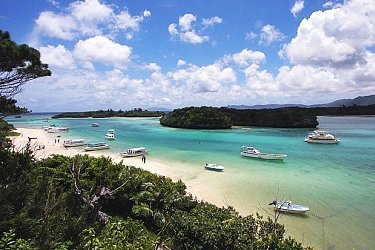
Regional Itineraries
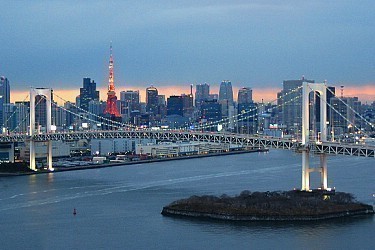
Local Itineraries
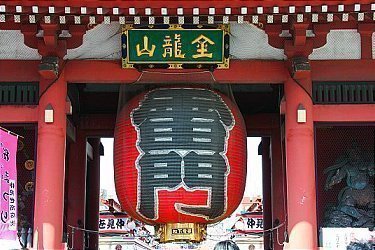
Questions? Ask in our forum .


IMAGES
VIDEO
COMMENTS
Itinerary 1: Classic Japan (Grand Cities and Traditional Villages) 3 nights in Tokyo. 1 night in Takayama. 2 nights in Kanazawa. 3 nights in Kyoto (side trip to Nara) 2 nights in Osaka. This 12-day itinerary is excellent for a first trip to Japan, with plenty of authentic experiences and activities.
Day 1 - Osaka - Reunited in Japan. Day 2 - Nara - When Deer Attack in Nara. Day 3 - Kyoto - Exploring Kyoto. Day 4 - Kyoto - Fushimi Inari Shrine. Day 5 - Hiroshima and Miyajima. Day 6 - Hiroshima - The Atomic Bomb. Day 7 - Tokyo - Not Early Enough for Tsukiji. Day 8 - Hakone - Hot Springs. Day 9 - Tokyo - Hato Bus.
Day 12 - Depart from Narita Airport. Depart Japan from Narita Airport. Regular train tickets will be cheaper than a Japan Rail Pass for this itinerary; however, travelers who do not mind paying extra for the convenience and flexibility of the pass' all-you-can-ride priviledge could consider using a 14-day Japan Rail Pass.
This 12 day Japan itinerary covers a variety of significant highlights in Tokyo, Kyoto, Osaka and the resort town of Hakone near Mt Fuji. This is an ideal itinerary for experiencing the cultural highlights of Japan, including a wellness escape! Tokyo - 4 Days. Tokyo Airports - Arriving in Tokyo. Japan for Couples or Solo Travel.
12 Days in Japan - 6 Unique Itinerary Ideas. In 12 days, you can explore as few as four destinations, like Tokyo, Kyoto, Hiroshima, and Osaka, or over eight on a faster-paced trip, adding in lesser-known locales like Kurashiki, Oda City, and Hagi. Cover the best of Japan and include an island visit to Okinawa, Japan's "Hawaii," indulge in the ...
Days 15 & 16: Hiroshima. Day 17: Train to Hokkaido. The train to Hokkaido, Japan's northernmost island home to volcanoes and rugged landscapes, takes 15-16 hours by train. There are sleeper cars available, but you'll have to pay a surcharge (around 9,500 JPY) for a bed.
This 12-day Japan itinerary features cities, mountains, history and art. Visit Tokyo, traditional Kyoto, the Japanese Alps, and the art island Naoshima. ... 12 days: US $1,000-$1,200 per person per day ... The travel arrangements were awesome and communicated so very clearly. The Axus app was terrific.
Spend 12 days exploring the best of Japan, including its most important cities. Start with a visit to Osaka's brightly-lit city center before exploring Kyoto's traditional historic neighborhoods and quiet temples. Learn about World War II history in Hiroshima, then hop on a plane to enjoy Okinawa's stunning beaches. End the trip in the exciting capital of Tokyo, one of the world's busiest and ...
Day 8 - Side trip to Nara. On a side trip from Kyoto, visit Nara, home of Japan's first permanent capital. Visit some of the oldest and largest temples in Japan and feed the deer that roam freely in the city.
Here, I want to document my day-by-day itinerary in detail (I jotted down notes every other night during the trip), so as to better remember my time there. The trip consisted of three main legs: Part I: Tokyo (Day 1 - Day 4) Part II: Kyoto (Day 4 - Day 7) Part III: Tokyo Again (Day 7 - Day 12) General Observations. Conclusion.
History, Tradition & Culture: Tokyo, Kyoto, Hiroshima & Osaka - 12 Days. Shop, eat, and explore your way through Japan's four major cities in this diverse 12-day itinerary. Start in Tokyo, walking around the best shopping precincts and witnessing the city's thrilling blend of ultramodern technology and ancient landmarks.
Experience Japan's perfect harmony of ancient tradition and modern way of life on a 12-day adventure through the cultural heart of the country with Intrepid Travel. Intrepid Premium Tours are designed for travellers looking for adventure travel with a higher standard of service, well-crafted itineraries, handpicked accommodation and the most experienced tour leaders.
The next step in our 14-day Japan itinerary is Matsumoto. There're many Samurai Castles scattered across Japan and you should visit at least one during your 14 days in Japan. We opted for the castle in Matsumoto as it is one of the few remaining original castles. Most other castles you will see are reconstructions.
Day 4: Kamakura. Buddha Statue in Kamakura. For a change in pace, visit Kamakura, a seaside town south of Tokyo. It was the political center of medieval Japan, but is now a popular resort town, with dozens of Buddhist temples and Shinto shrines.
A nationwide Japan Rail Pass does not pay off for this itinerary. Below are some sample budgets for the itinerary, excluding airfare. Find out more about the sample budgets and about the current yen exchange rates. Single Traveler. Two Travelers. Low Budget. 71,000 - 112,800 yen. 142,000 - 225,600 yen. Medium Budget.
Day 11 to Day 12 - Hakone, Mt. Fuji & surrounding areas. To round up your trip before heading back to Tokyo to take your flight out of there (sob), take some time for some R&R at Hakone, complete with onsen and kaiseki style meals. I hope you enjoyed my tips on how to plan a trip to Japan! Let me know if you have any doubts on the comment ...
"Travel. It leaves you speechless then turns you into a storyteller." ~ Ibn Battua. How to create a unique 2 weeks in Japan itinerary. These days, it seems like most 2 weeks in Japan itineraries speed through the same few spots along Japan's famous old Golden Route — Tokyo, Kyoto, Osaka and maybe Hiroshima with rushed day trips.
Days 9-12 Hiroshima Days 12-15 Tottori Days 15-20 Osaka & Kyoto Days 20-25 Nagoya/Gifu Days 25-29 Hokkaido Days 29-35 Tokyo. To maximize your JR Pass, use it first when you travel from Fukuoka to Hiroshima (Day 9). This will allow it to be effective until Day 29. when you travel from Hokkaido to Tokyo. This way, you have covered most long ...
Distances really depend on the mode of transport you use, with bullet trains being the fastest. Days 1-3: Tokyo. Day 4: day trip from Tokyo. Days 5-6: Kyoto. Day 7: Nara and Osaka. Day 8: Miyajima and Hiroshima. Day 9: morning in Kyoto → Tokyo. Day 10: Tokyo in morning/afternoon → airport.
Day 1 - Tokyo->Nikko->Tokyo. Shinkyo Bridge in Autumn. Photo Credit: Marufish at Flickr. Unlike other suggested itineraries, that guide you visit a day trip to Tokyo's most famous sightseeing attractions, I would suggest you to start off your Japan Fall Tour with a visit to Nikko, a UNESCO World Heritage Site in Japan.
Day 12 - Depart from Kansai Airport. Depart Japan from Kansai Airport. A nationwide Japan Rail Pass does not pay off for this itinerary, but we recommend to use Haruka 1-Way Tickets for your transport to/from Kansai Airport, a 1-day Kansai Area Pass for your daytrip to Himeji and a Koyasan World Heritage Ticket for your trip to Mount Koya.
1. Highlights of Japan Itinerary: 10 Days for Family Travelers; 2. Extended Japan Itinerary: 2 Weeks With Kids; 3. Slower Pace Itinerary for Japan With Kids: 10 Days; Tips for visiting Japan with kids
We strive to keep Japan Guide up-to-date and accurate, and we're always looking for ways to improve. If you have any updates, suggestions, corrections or opinions, please let us know: